
The Great SUPERMAN Rewatch
This essay was originally posted to Twitter between November 18, 2021 and January 31, 2022. It was composed of 6,967 words across 150 tweets.
Roger Ebert used to host classroom screenings of Citizen Kane (Welles, 1941) in which everyone in attendance was, at any time, invited to call out "stop!" if they saw or heard something in the movie worth highlighting. Then the room would discuss it.
What follows is a point-by-point recap of the theatrical edition of SUPERMAN. As Ebert and his Citizen Kane invitees did, I will stop the movie anytime I find something worth commenting on and note the timestamp. I'll strive to make these remarks as original as possible.
00:06 This isn't that important, but I love the '70s Warner Bros. logo. WB always used some variation of lettering against an ornate shield, but this version (designed by Saul Bass in 1972) is probably the most abstract.

00:14 I won't belabor his career or his death, but SUPERMAN is dedicated to Geoffrey Unsworth--the cinematographer who shot this movie and many others, including 2001: A Space Odyssey. Much of SUPERMAN's lavish texture is owed to the sense of dimension he lent to the images.

00:30 The aspect ratio of the screen-within-a-screen we're presented with here looks to be 1.375:1 (similar to the 4:3 of a CRT television set), which is also known as the Academy ratio. This would be period correct for most movies being show in a movie theater in 1938...
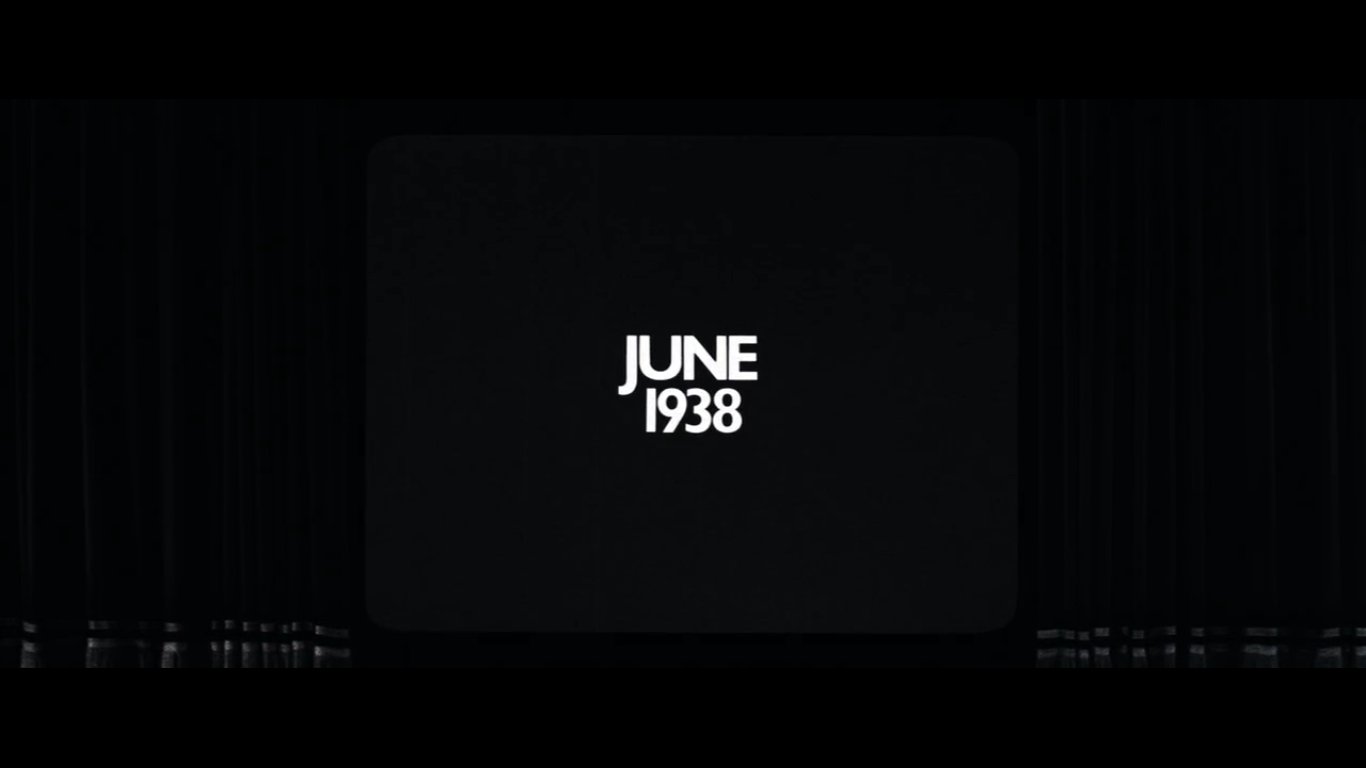
...though various widescreen aspect ratios had been in sporadic use by this time.
In the mid-1950s, widescreen gained traction that would eventually prove decisive over the Academy ratio. It promised spectacle that couldn't be replicated by the emergent home television set.
(Four tweets already and we're only 30 seconds into the movie. I'd better speed this along!)
00:35 The comic book pictured here appears to be made up for the movie, rather than a real issue of Action Comics. Certain period details are correct, such as the 10 cent cover price.
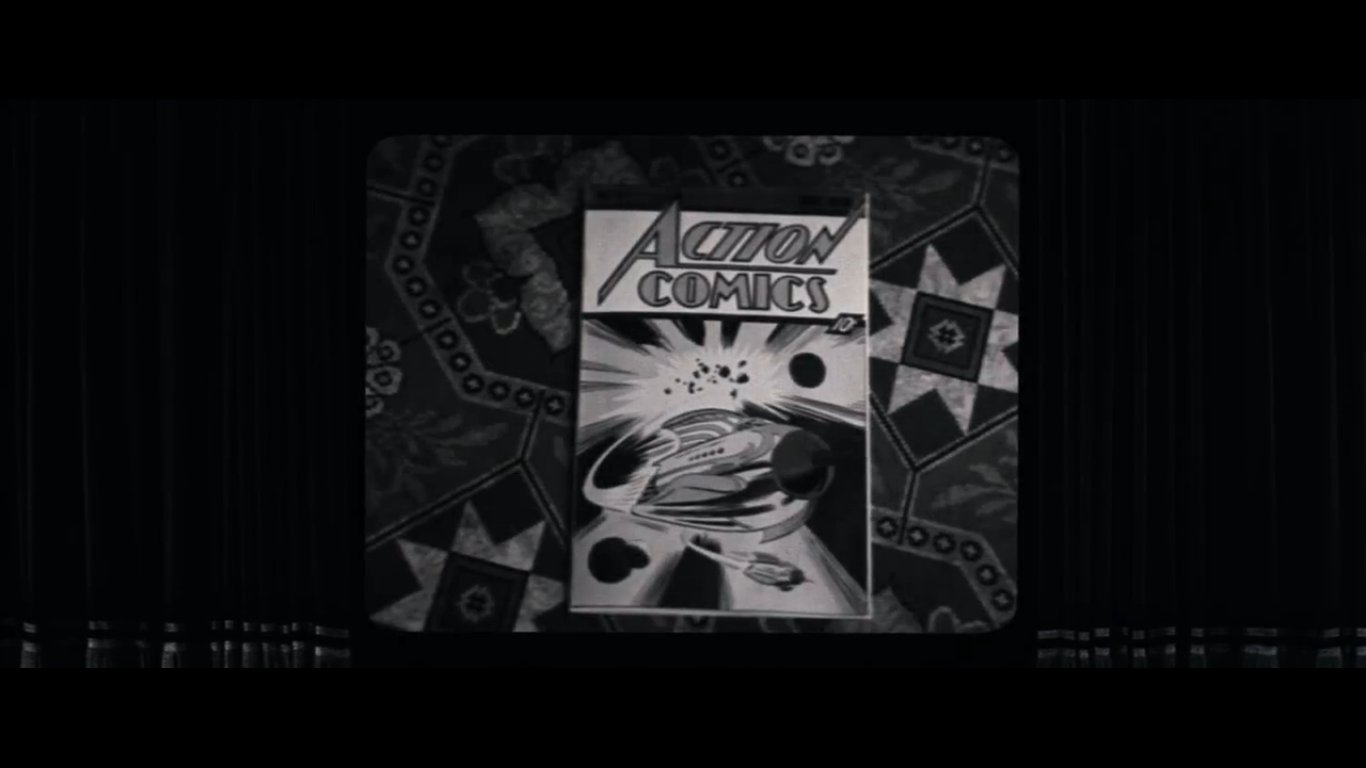
Action Comics cost 10 cents until #283 (cover dated December 1961), when the price was raised to 12 cents.
Also of interest: Action Comics started out as an anthology series. The final time that a non-Superman story appeared on the cover was #18 (cover date November 1939).
01:28 The first of the famous zooming credits, designed by Richard Greenberg using a process called slit-scan, and worth the budget of a small movie. I love the way they break through to the full width of the screen, and the original (pre-extended edition) sound effects.
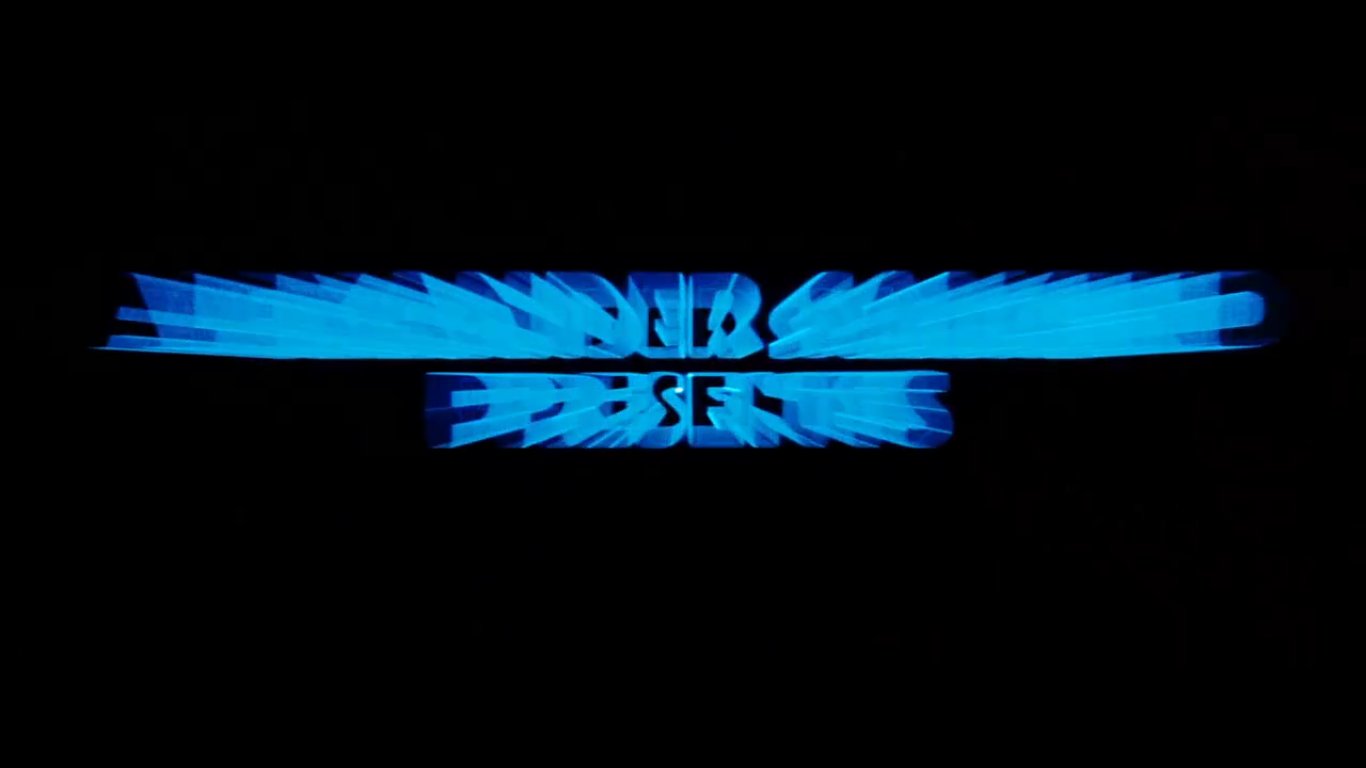
01:35 Reeve and Kidder are indisputably the stars, but Brando and Hackman, being the bankable names that got this movie made, get to go first.

01:55 Initially, the credits zoom towards us, but, starting with the "S" shield, they zoom away from us. An interesting creative choice.

02:03 There will be a full essay dedicated to it, but the music here is just majestic and beautiful.
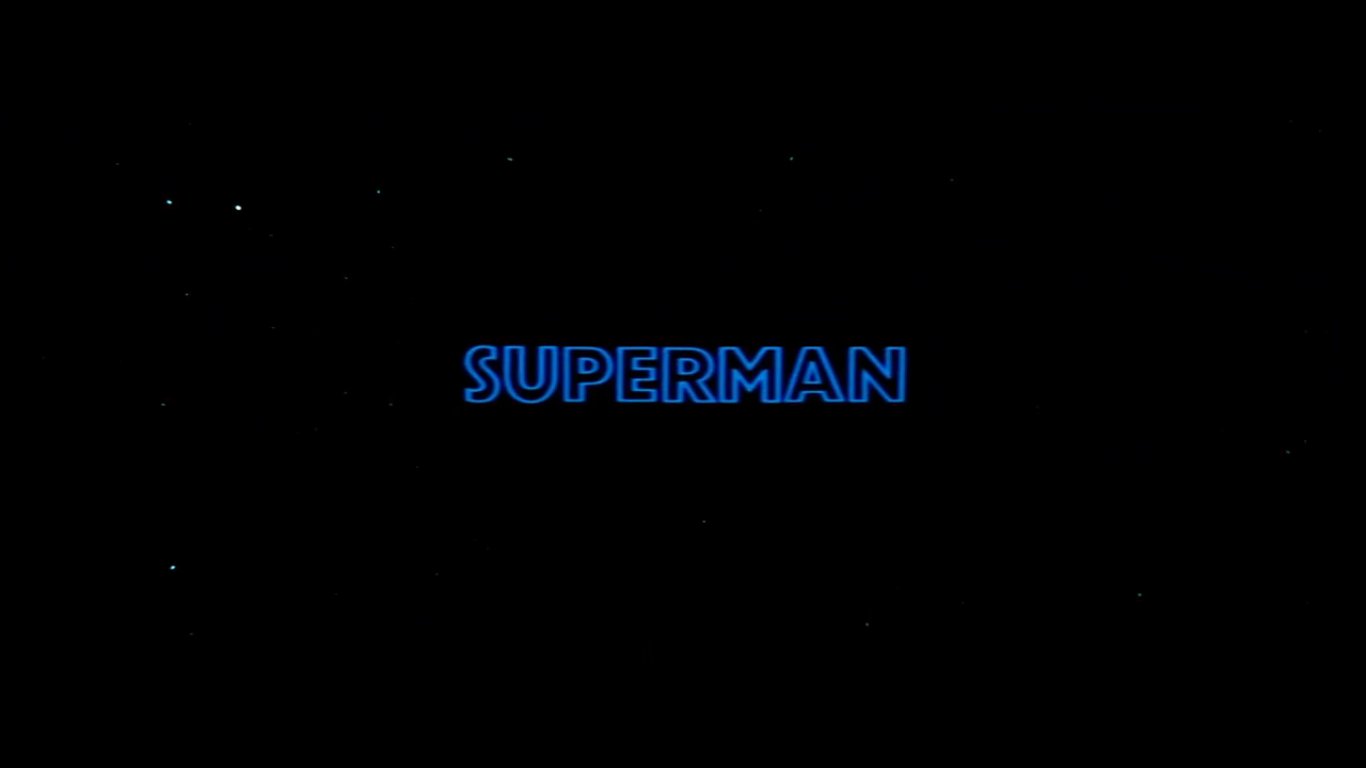
04:47 Read the Mank essay for the significance of Tom Mankiewicz's placement in the opening credits.
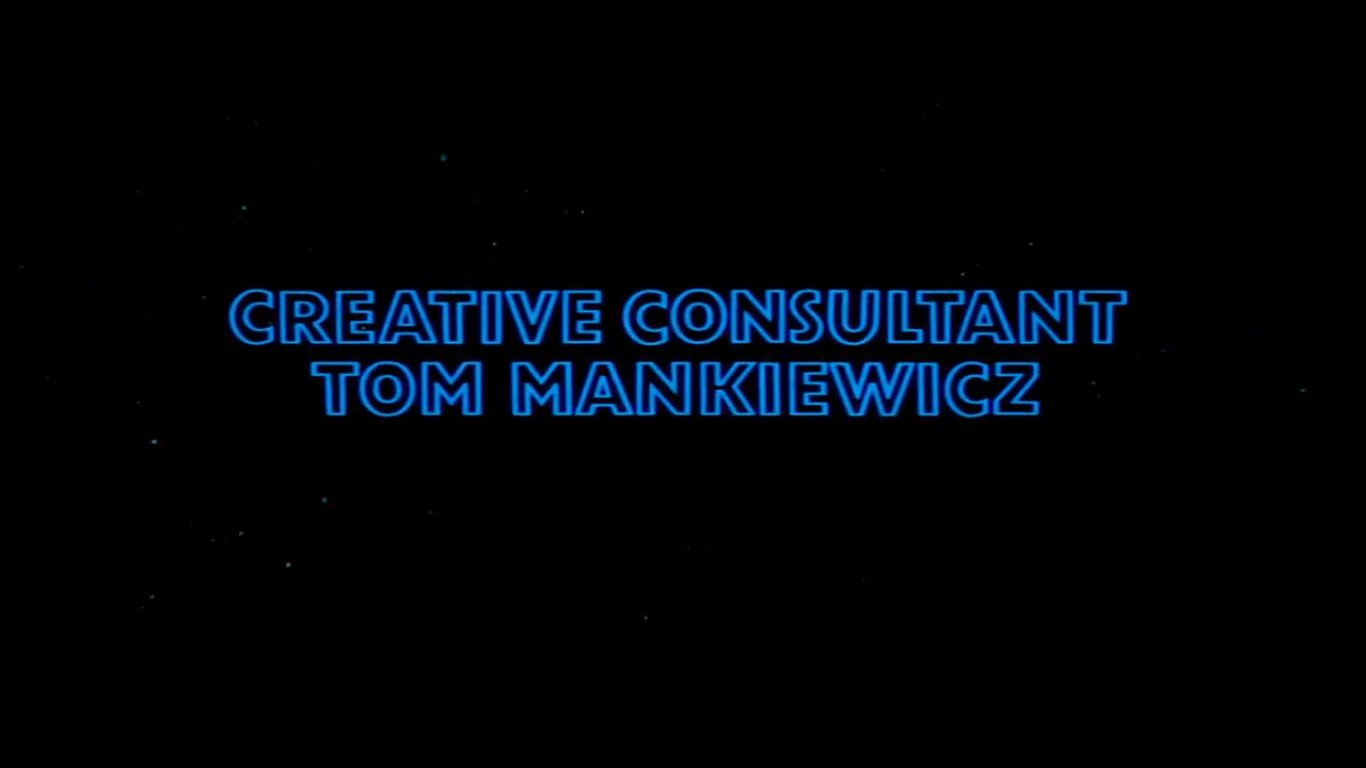
06:41 Almost seven minutes in, we get our first dialogue. (The kid reading the comic book in the intro doesn't count.) Today's superhero movies are designed to deliver fleeting moments of satisfaction as often as possible. Imagine them asking this much of our patience.

07:03 Jor-El presents his colleagues (who appear to be participating by futuristic Zoom call) with information via a glowing crystal. This isn't explained--the movie is trusting us to put it together through context, which is a terrific way of efficiently building the world.
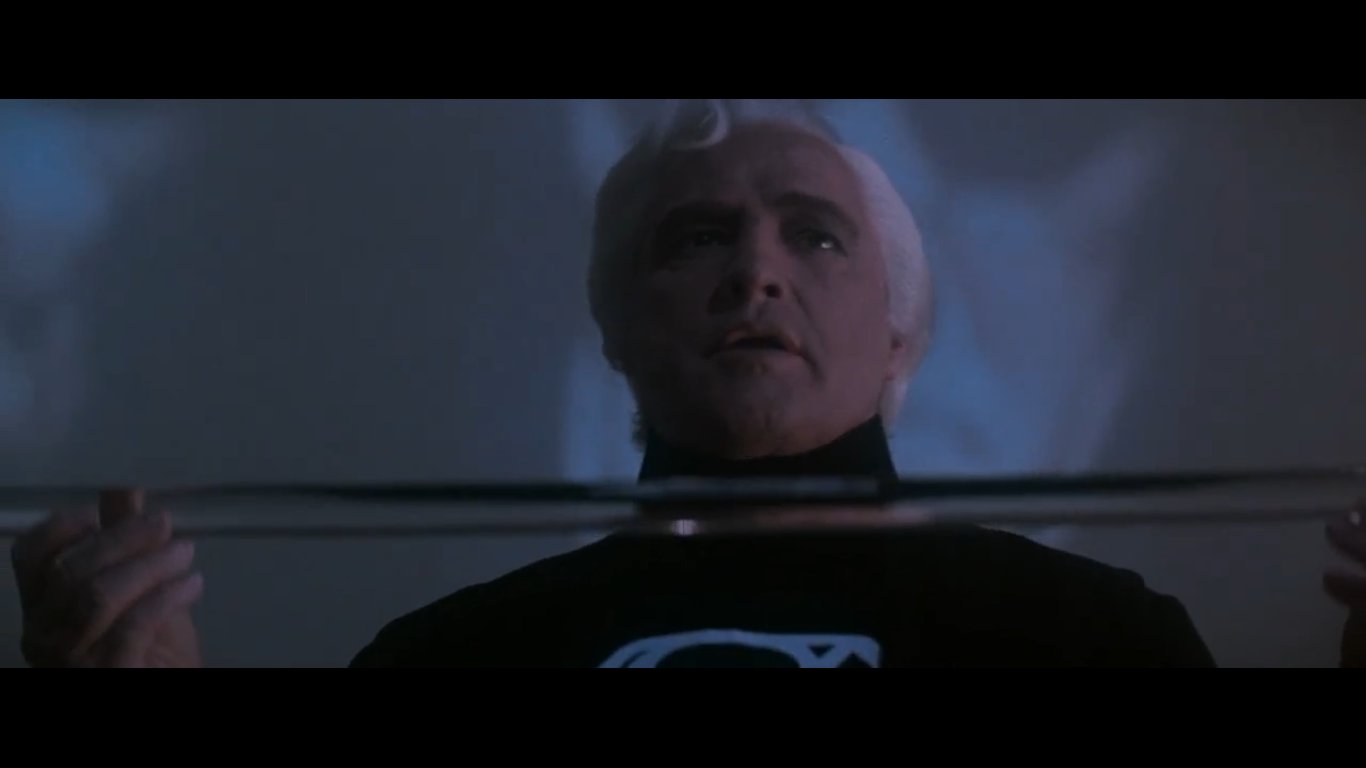
07:21 I hesitate to make fun of the costumes, but it's hard not to think about the gag memes about Zod and his crew being members of a German electronic band or whatever.
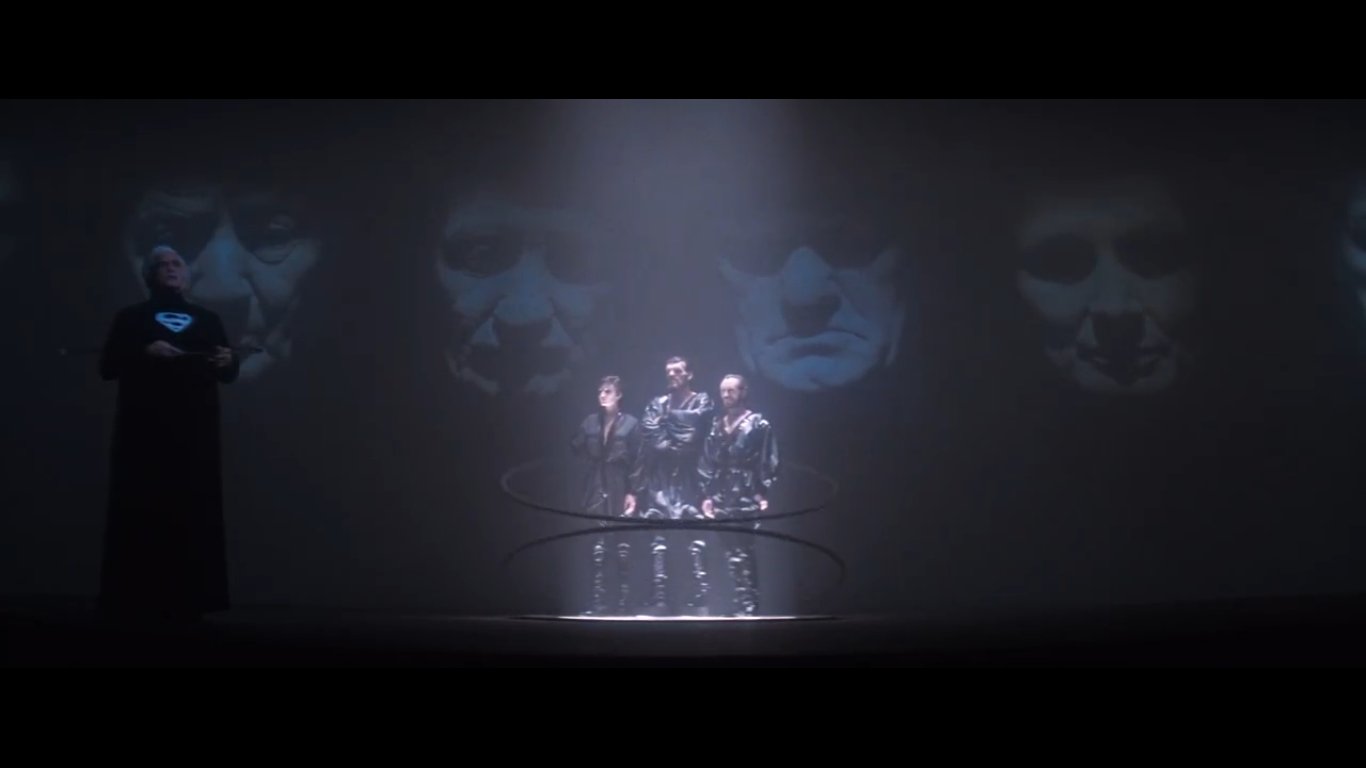
07:38 Unsworth is bringing his Kubrick experience to the party with this sinister underlighting.

08:58 The fast cutting of shots with the villains, plus the slow cutting of shots with Jor-El, culminating in these whipcrack inserts of the closeups of the villains' eyes. Effective, expressionistic editing, the type of artistic choice forgotten by today's house styles.
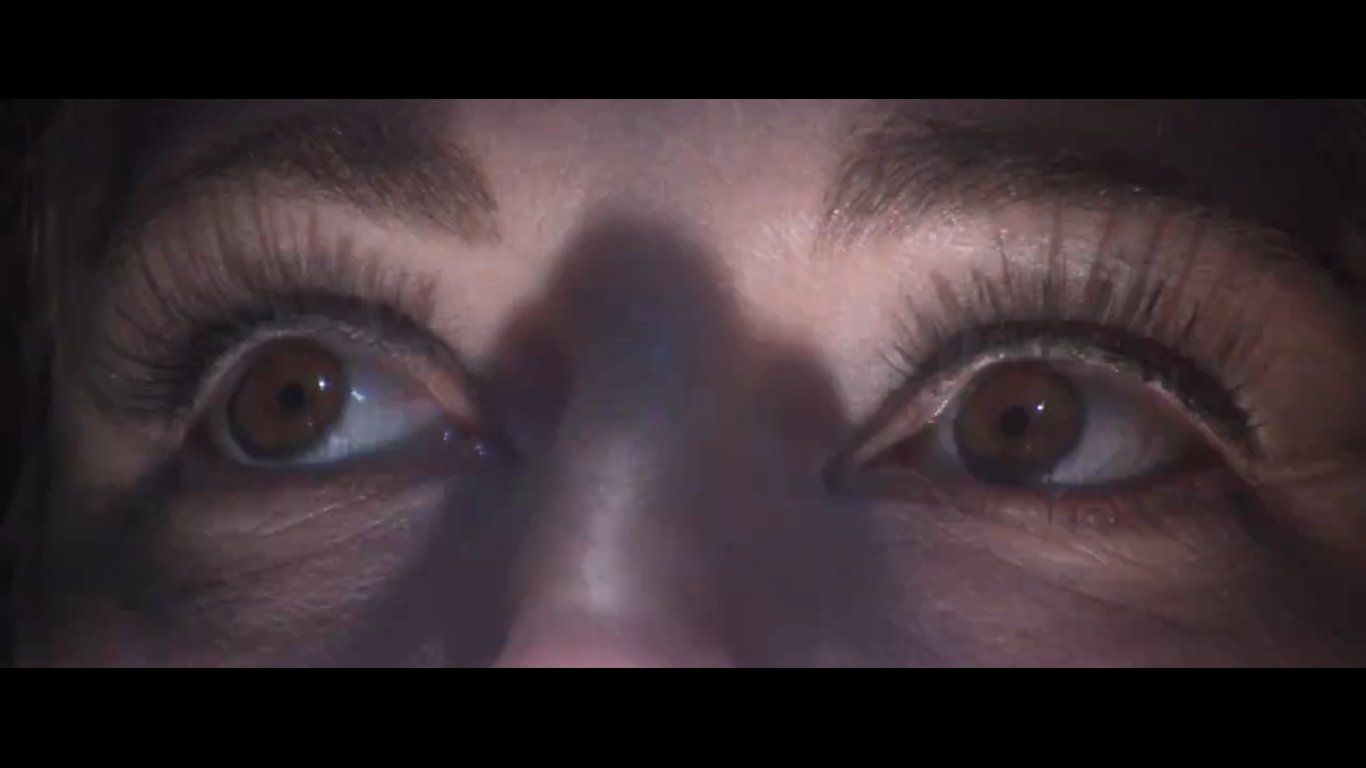
09:38 "You will bow down before me! Both you, and then one day, your heirs!" Wow, I feel sorry for whoever that is.

10:40 The flying effects are the biggest deal, but there are so many other great effects in these last few minutes alone. The movie tosses them around like candy.
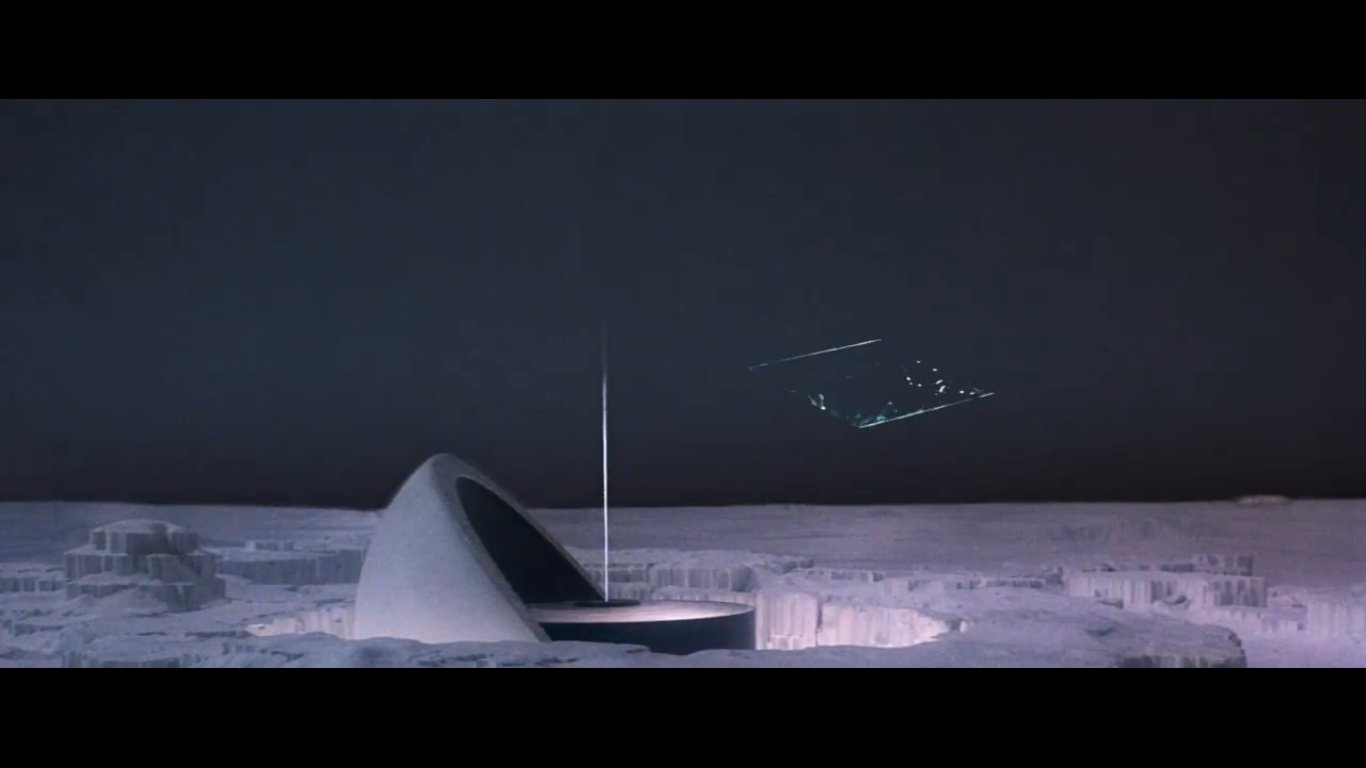
11:14 "You cannot ignore these facts." Letting the scene of Zod and his minions linger while Jor-El's first line of dialogue from the next scene comes in a little early is a terrific scene transition, which gets ruined by the insertion of cut footage in the extended edition.
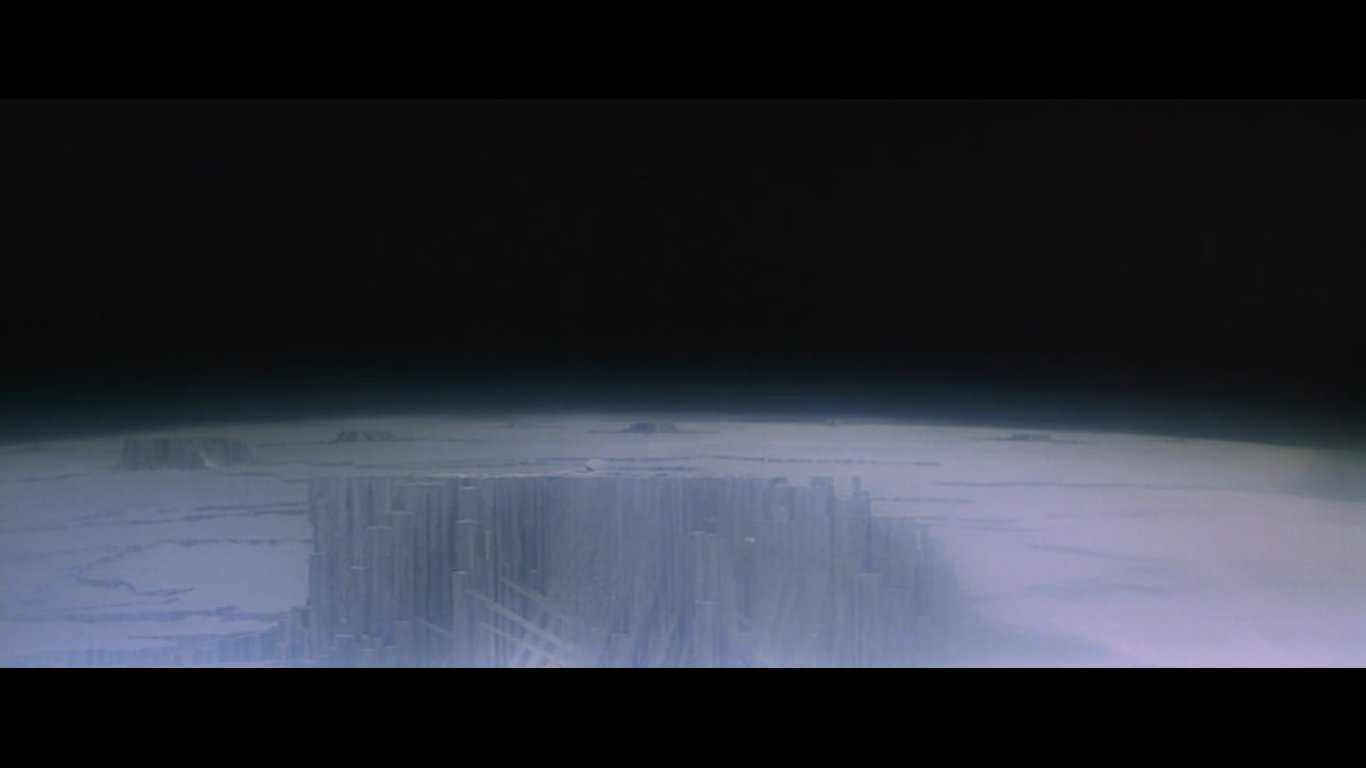
Jor-El is in the middle of telling his fellow council members and scientific contemporaries that the planet is doomed, even as we're seeing the villains escape its orbit. (However involuntary their voyage may be.) The theatrical edition plays this for the irony it deserves.
11:39 These costumes (presumably the formal attire for government meetings) are magnificent. There are a couple things going on here. One, the robes are made up of movie screen material. It's covered in tiny glass beads that reflect light at many times its original intensity.

When unlit, they show a dull gray, which can be seen in production photos and behind-the-scenes footage.

Two, someone (maybe Tom Mankiewicz, though I've seen it attributed to Marlon Brando) decided that the "S" shield is a family crest. Here, everyone gets a crest of their own.
12:35 This is Trevor Howard, a terrific English actor of stage and screen. You may remember him from The Third Man (Reed, 1949), among other impressive credits. This whole scene is filled out with great actors who hopefully got paid very well despite their short screen time.

13:00 Jor-El, as a character, exists within a very narrow range of emotional expression--perhaps that's who he is as a person. Perhaps that's his socialization on a cold planet with a rigidly scientific culture. That said, Brando is doing his best here to convey smoldering anger.

13:33 I talk a little bit more about this shot in the essay "The Last Days of Krypton," but the staging here, and the framing, perfectly convey the mood and the story information without one more word being spoken.

14:05 The first appearance of our hero! He doesn't get any lines here, but still, good performance so far.
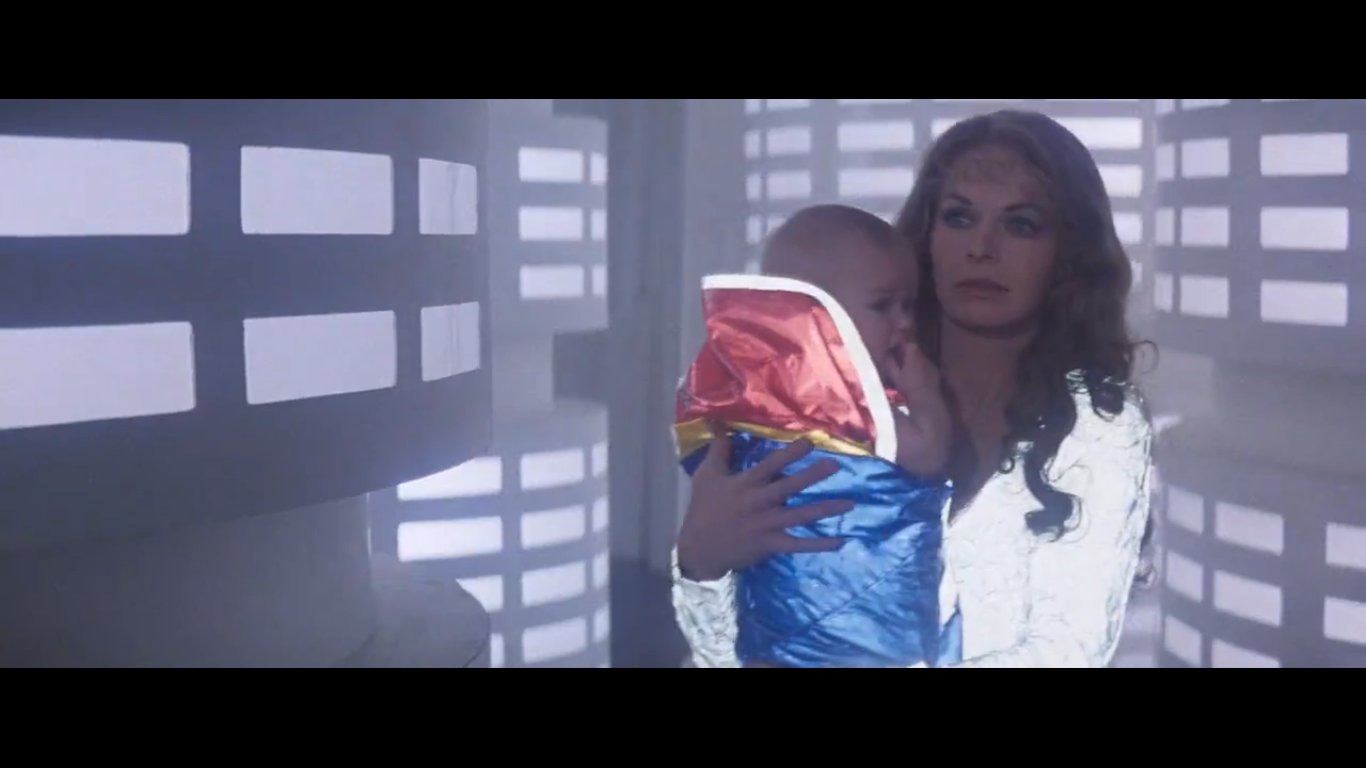
14:16 The design of the spacecraft is unique: a sort of egg, separated into two halves and covered in spines. Unrecognizable as a rocket ship, but why wouldn't it be?

14:53 I love the dialogue in this scene. Lara is fretting over baby Kal-El's chances of survival, while Jor-El is going over all of the factors that tilt in his favor. The movie doesn't overdo it, but they're both scared parents, processing their worries in their own way.
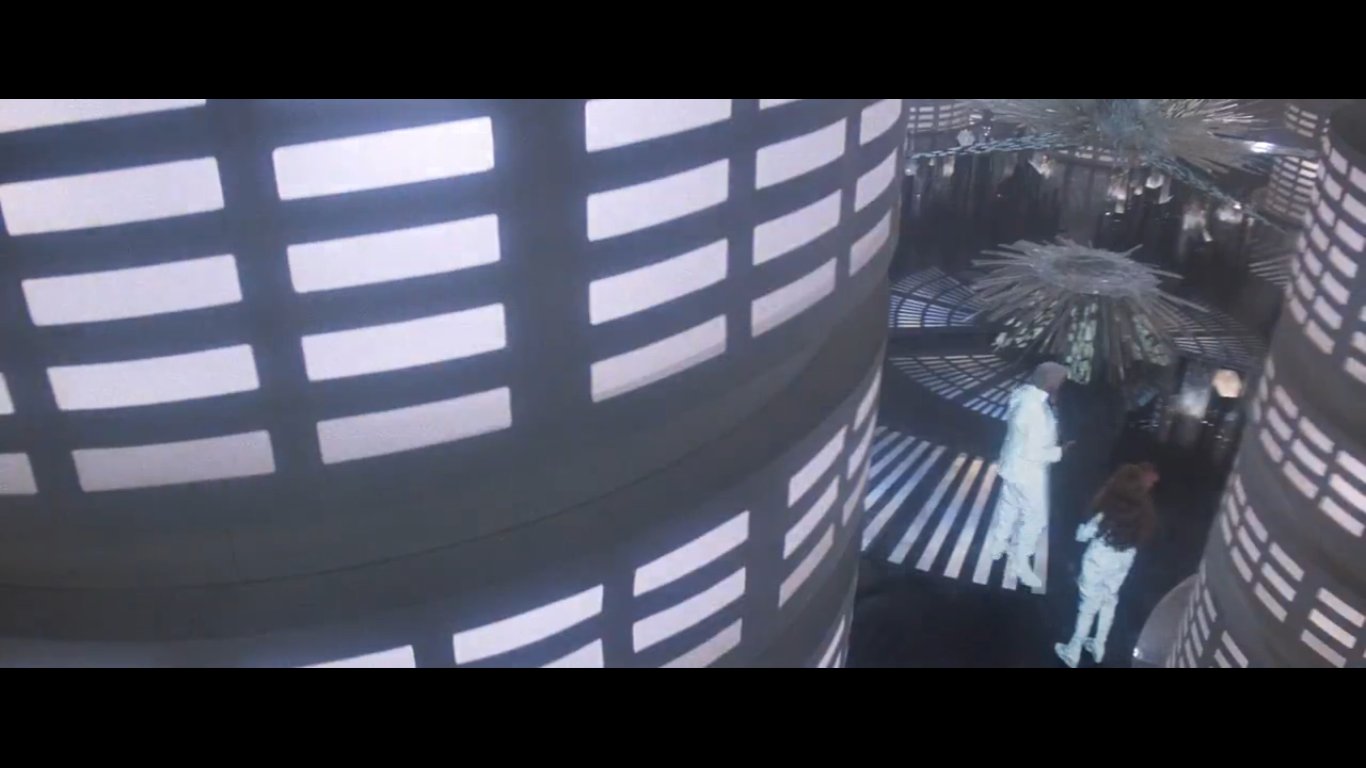
15:00 While they chat, they walk about the laboratory as Jor-El does whatever sciencey things need to be done to prepare the ship. (In the old days, they called this "business.") More contemporary movies might treat this much less imaginatively, with shot-reverse shot closeups.

15:30 Jor-El insists that baby Kal-El "will never be alone." Perhaps with the confidence that someone will find him and keep him safe, but the crystal he holds contains information, including computer simulations of himself and Lara--their lingering ghostly essences.
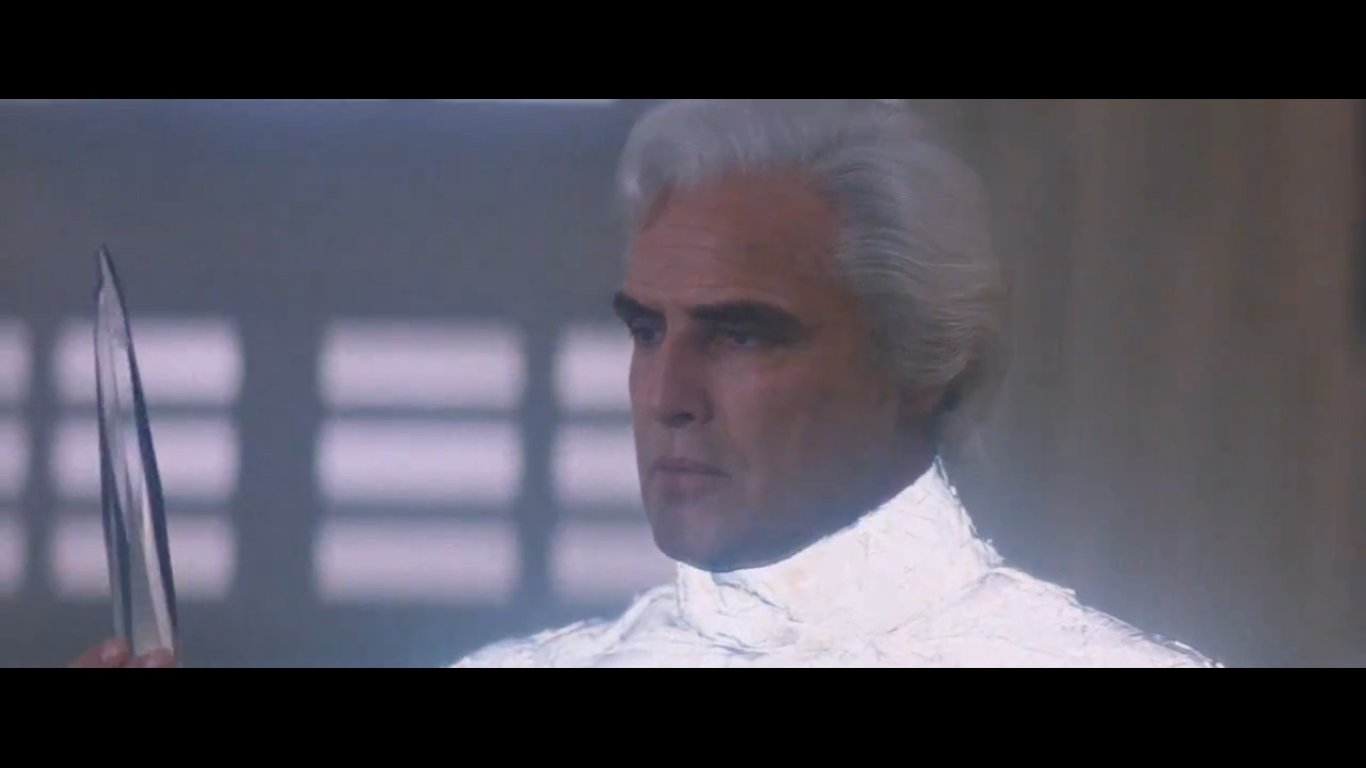
This could be dismissed as a contrivance of the plot. (If Superman needs a convenient source of exposition, he can always visit his space parents via the information crystals.) But there is some poetry here, the Kryptonian equivalent of our elders' family photos and journals.
17:28 Jor-El's goodbye speech is short yet packed with emotional sincerity. I'm loathe to overstate things, but this is the closest a raygun gothic story like this might come to the short but sweet poetry of the Gettysburg Address. Here's where Brando earns his massive payday.

18:12 After the speech, there's no dialogue for the rest of the Krypton scenes. As Jor-El and Lara load their baby into the ship, the ceiling cracks, the floor shakes, and they don't remark in shock--just fatalistically finish their business. From here on out, it's all cinema.

19:12 In the essay "Super Powers," I speculate that Superman's flying ability had to do with some sort of exotic non-gravitational field. Notice that the ship rises with no visible means of propulsion. Coincidence?
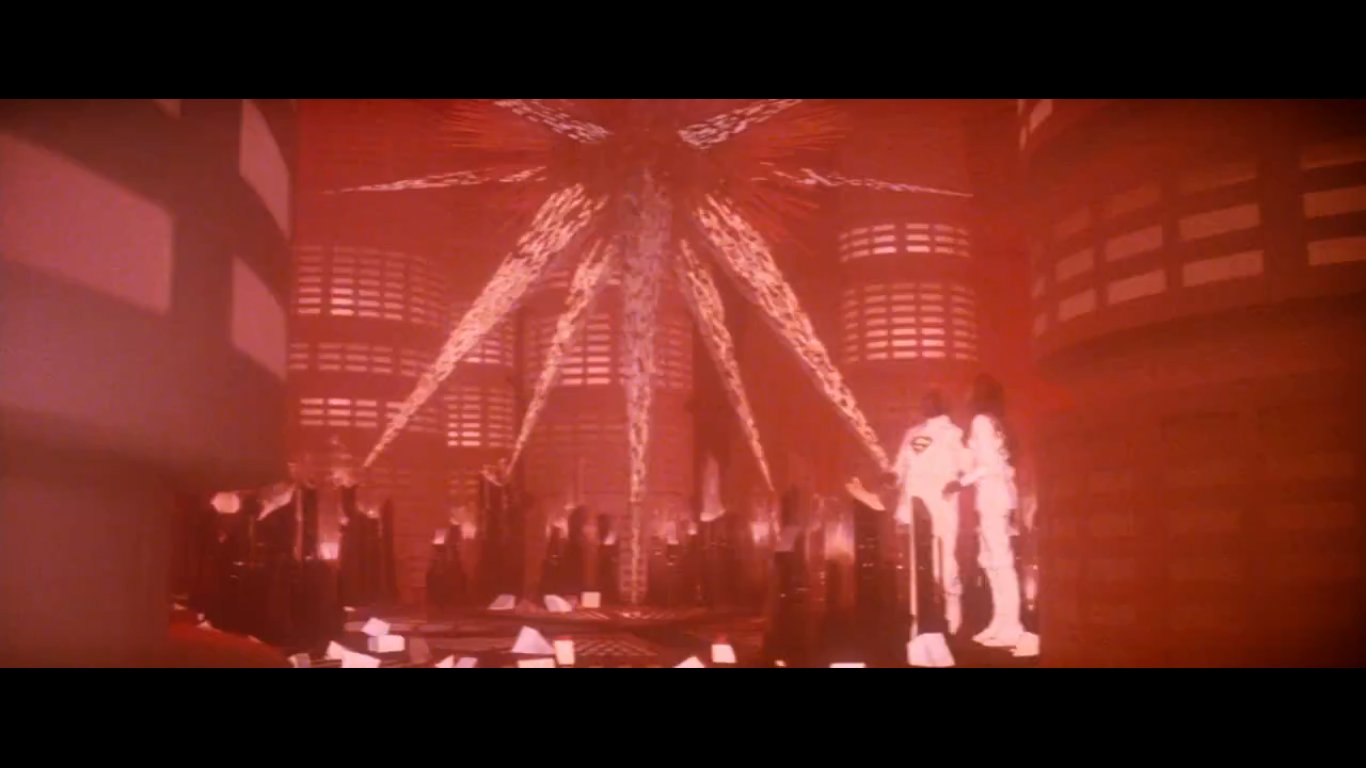
19:34 Though the sparks here are letting them down, the special effects and miniatures throughout the destruction of Krypton sequence are generally solid. Check out the tracking-in on Jor-El and Lara through the window--that's normal footage and miniatures composited together.

20:08 The mayhem on Krypton and the tranquility of baby Kal-El being spirited away into space are juxtaposed here marvelously. There was a death scene shot for Jor-El and Lara, though the footage went unused in all editions of the movie--a tasteful decision, I think.

21:17 There's something very dispassionate about the way we're shown these people as they realize, too late, that the world is crumbling around them, culminating in the far-off view of the planet being ripped to pieces. The movie could have judged them, but it doesn't really.
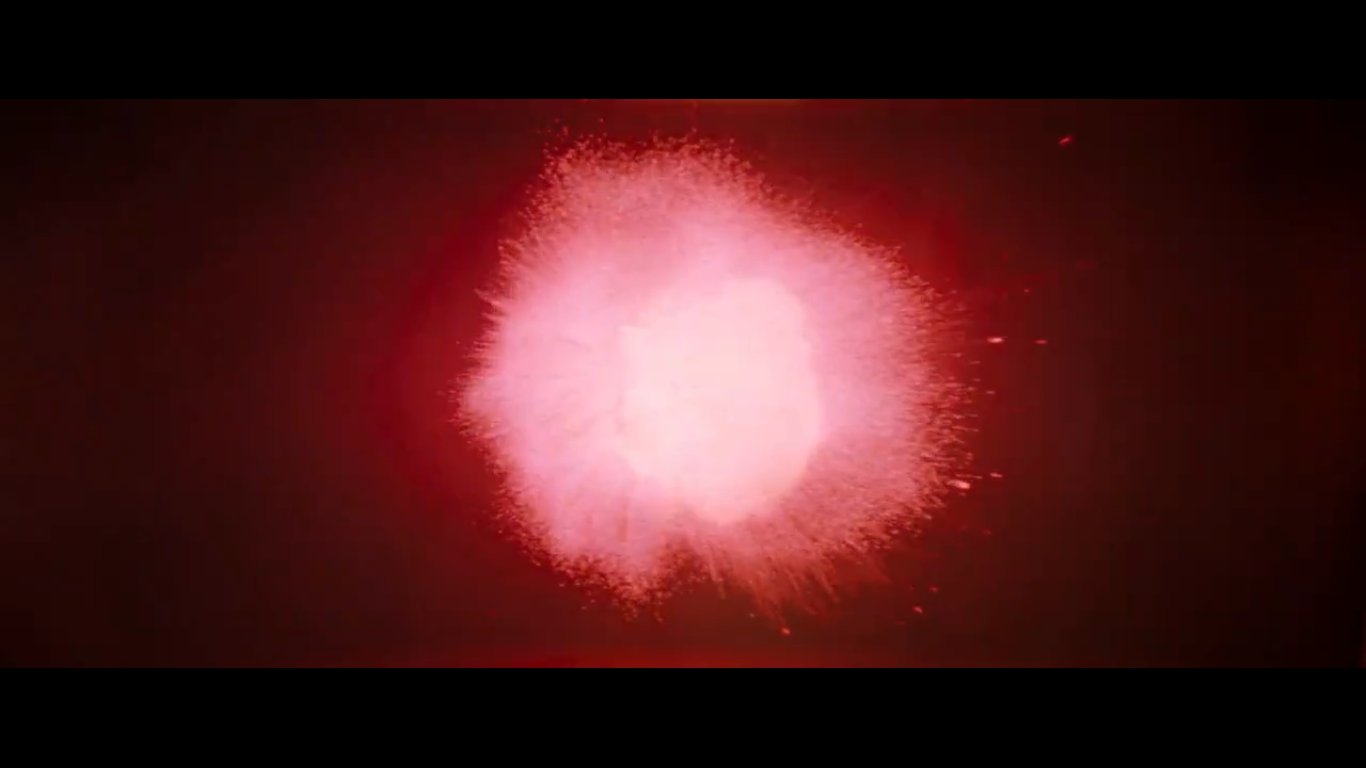
21:41 There's a shot that was taken out here that's present in the 2001 extended edition, in which baby Kal-El's spacecraft passes by the Phantom Zone portal with the faces of the villains staring out. A pointed reminder that, in imprisoning them, Jor-El actually spared them.
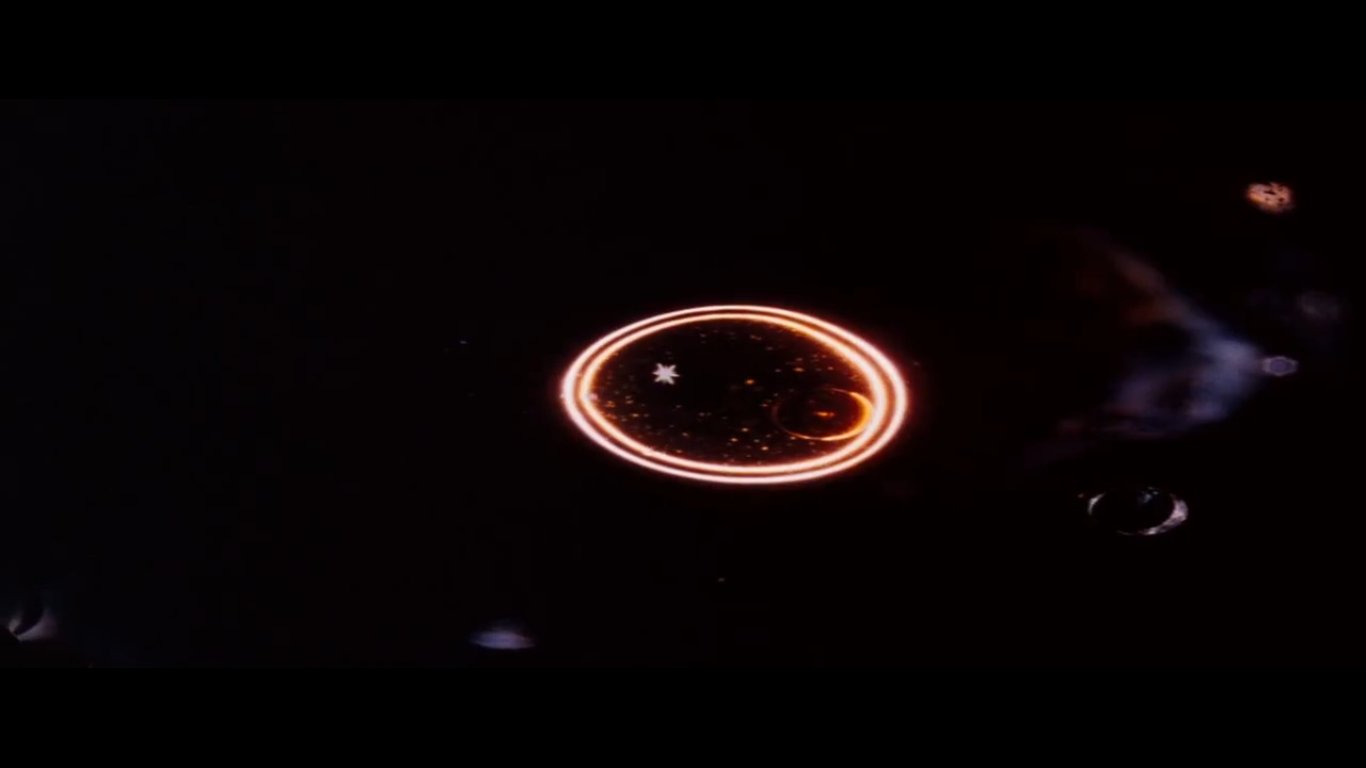
I think this is a cool detail, but, given that SUPERMAN II was shelved and the first one was retooled midway through production, it made sense to take this shot out. With the first movie no longer ending on a cliffhanger, there are only so many loose threads to leave dangling.
21:45 I always thought it was odd that Kal-El spent his lightspeed journey to Earth being Baby Mozart'ed with the dulcet tones of his father, bombarding him with the knowledge of the cosmos. For one thing, babies notoriously do not have long term memories, rendering it pointless.
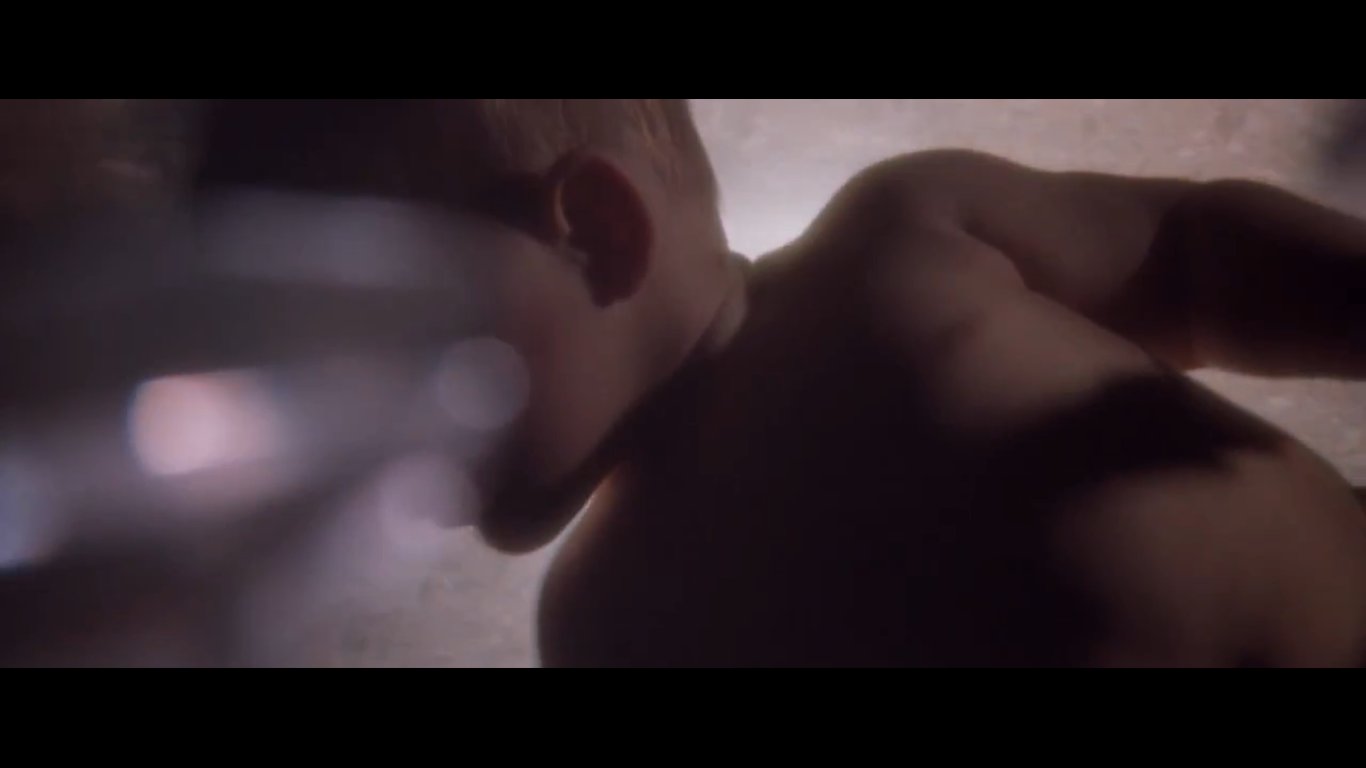
And even if Kryptonian babies are different, even if he'll eventually remember all of it, isn't that kind of irresponsible? Baby Kal-El is a ticking time bomb of advanced knowledge that a technologically inferior species such as ours is nowhere near equipped to handle. Oh well!
22:06 The macro photography in this sequence is stunning. It may not correspond to any real world cosmological phenomena, but it's a tactile and colorful way of illustrating the exotic and unknown reaches of space that baby Kal-El finds himself passing through on his voyage.

22:37 It's a nice visual storytelling touch that we periodically check in with the baby, and, at this point, he's being played by a visibly older actor. The movie otherwise isn't spoonfeeding us here--no title cards, no references in Brando's narration to the passage of time.
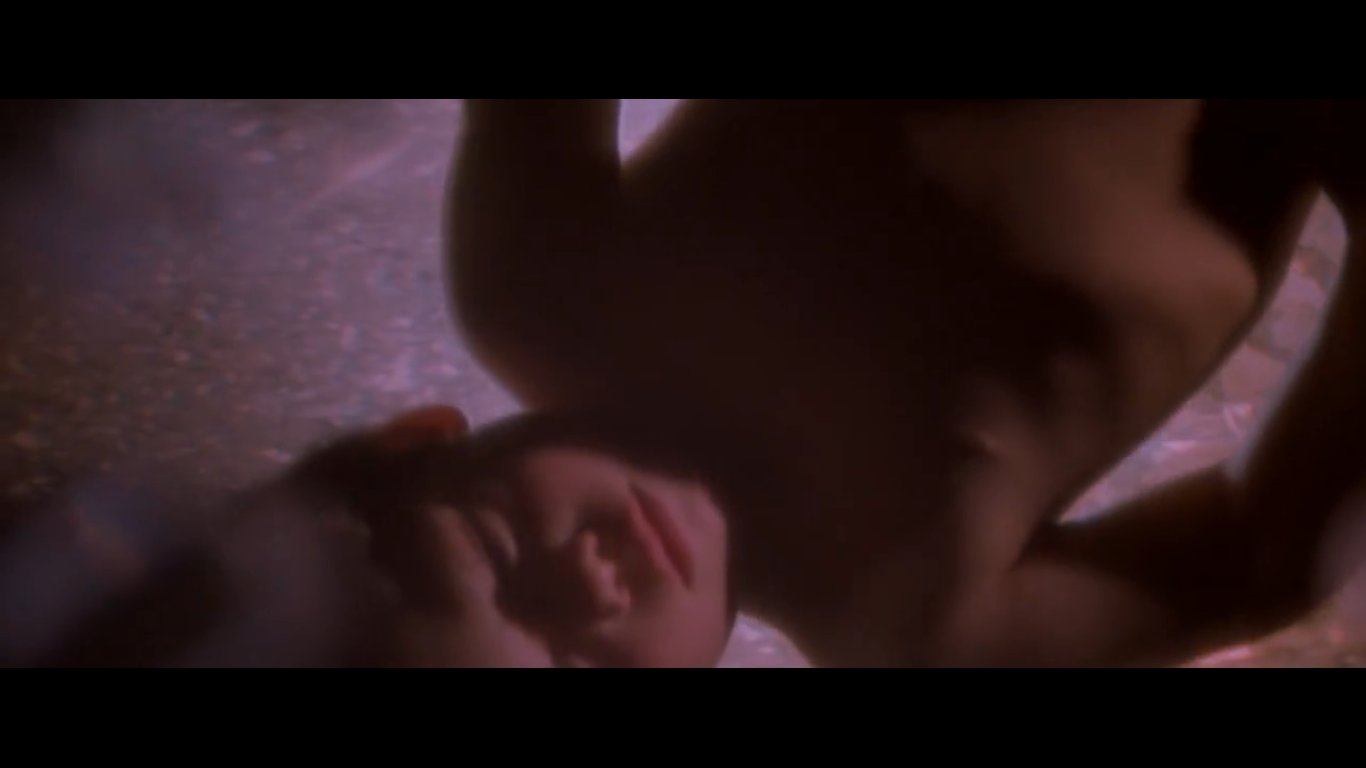
23:18 I like that the ship doesn't just coincidentally end up in Smallville. It changes direction mid-fall, indicating either that Jor-El knew exactly where he was sending it, down to the precise surface coordinates (doubtful), or that some kind of A.I. is choosing on the fly.

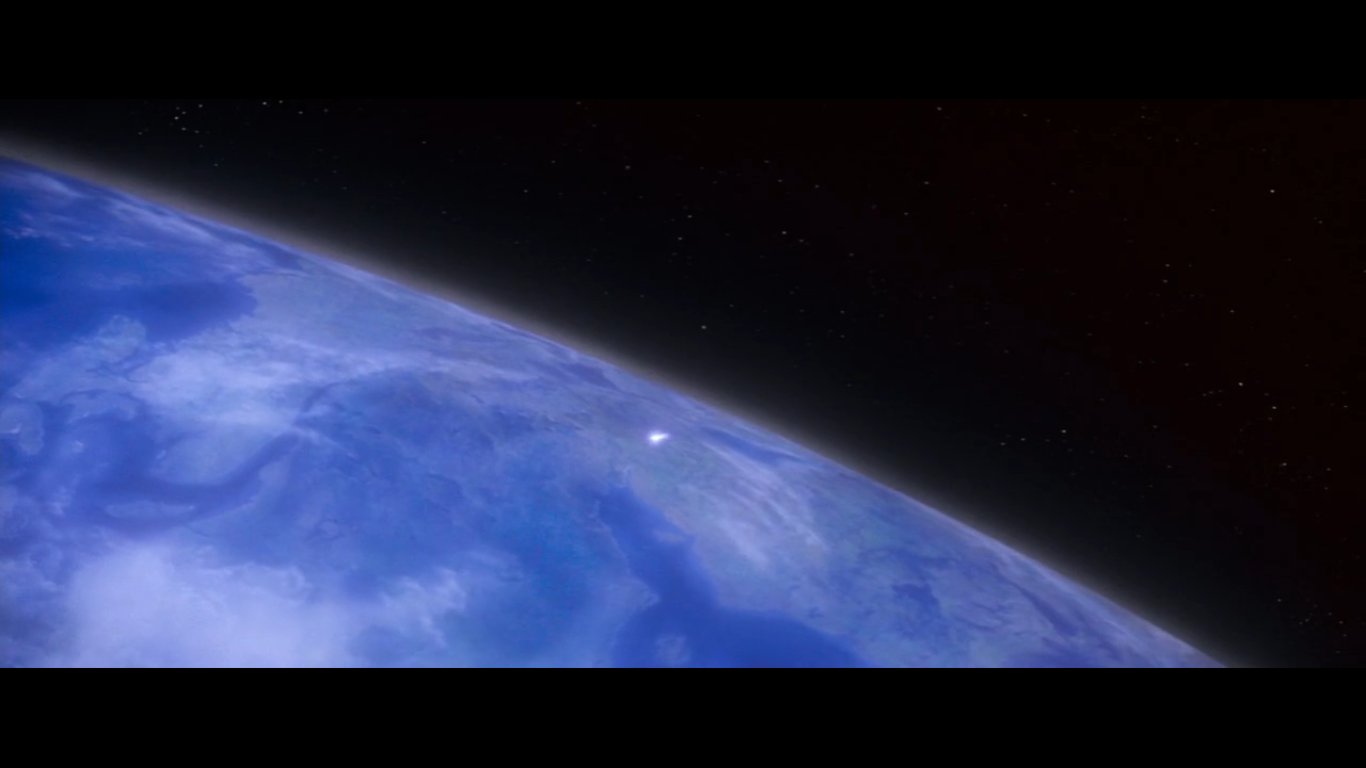
Sometimes, soft science fiction can drop in little bits of hard science fiction when you're not looking. This might be one example. Another (less tenuous) example would be in Star Wars (Lucas, 1977), when Luke and Han climb into the gun turrets and the gravity changes direction.

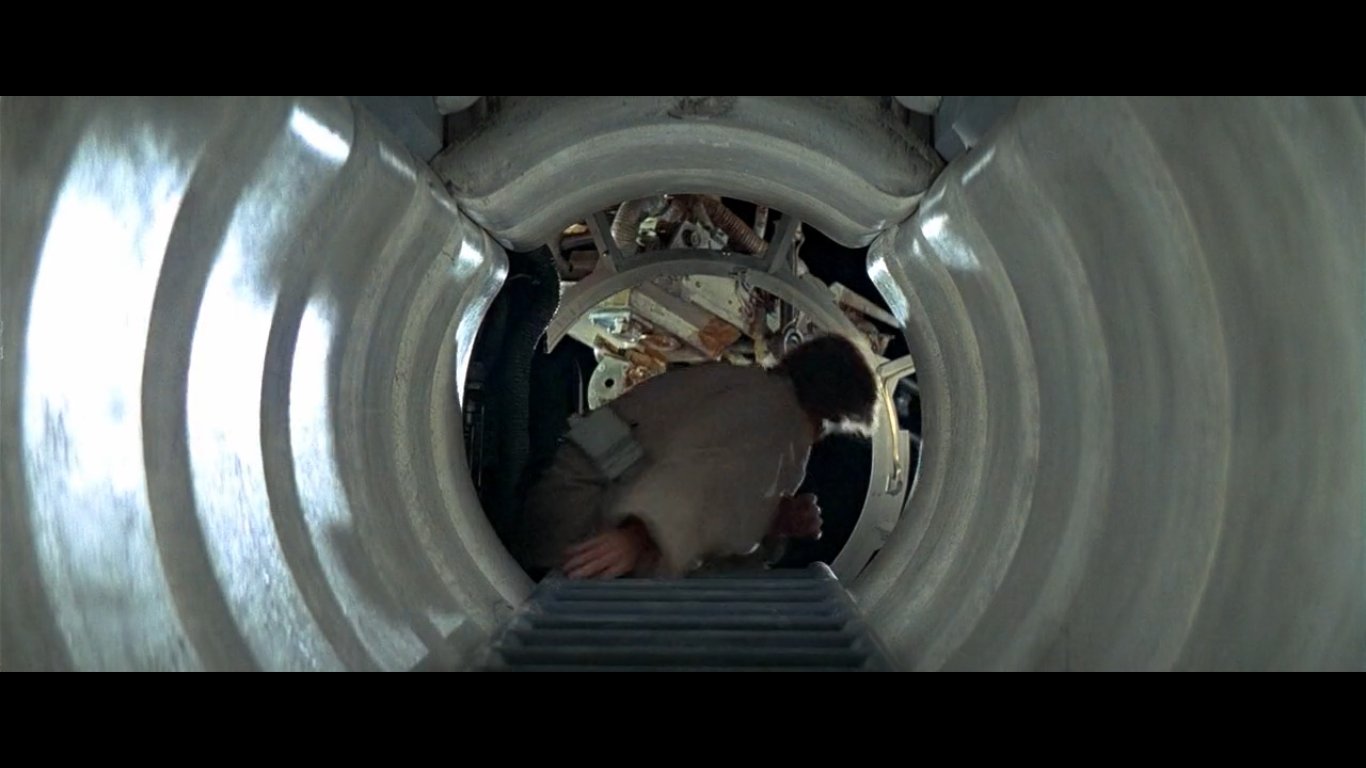
23:48 Everyone knows Smallville is in Kansas--that's Superman lore 101. But, prior to John Byrne's Man of Steel comic miniseries in 1986, Clark's home state was never officially specified. That said, the license plates on the Kents' pickup truck are Kansas plates circa 1970(!).
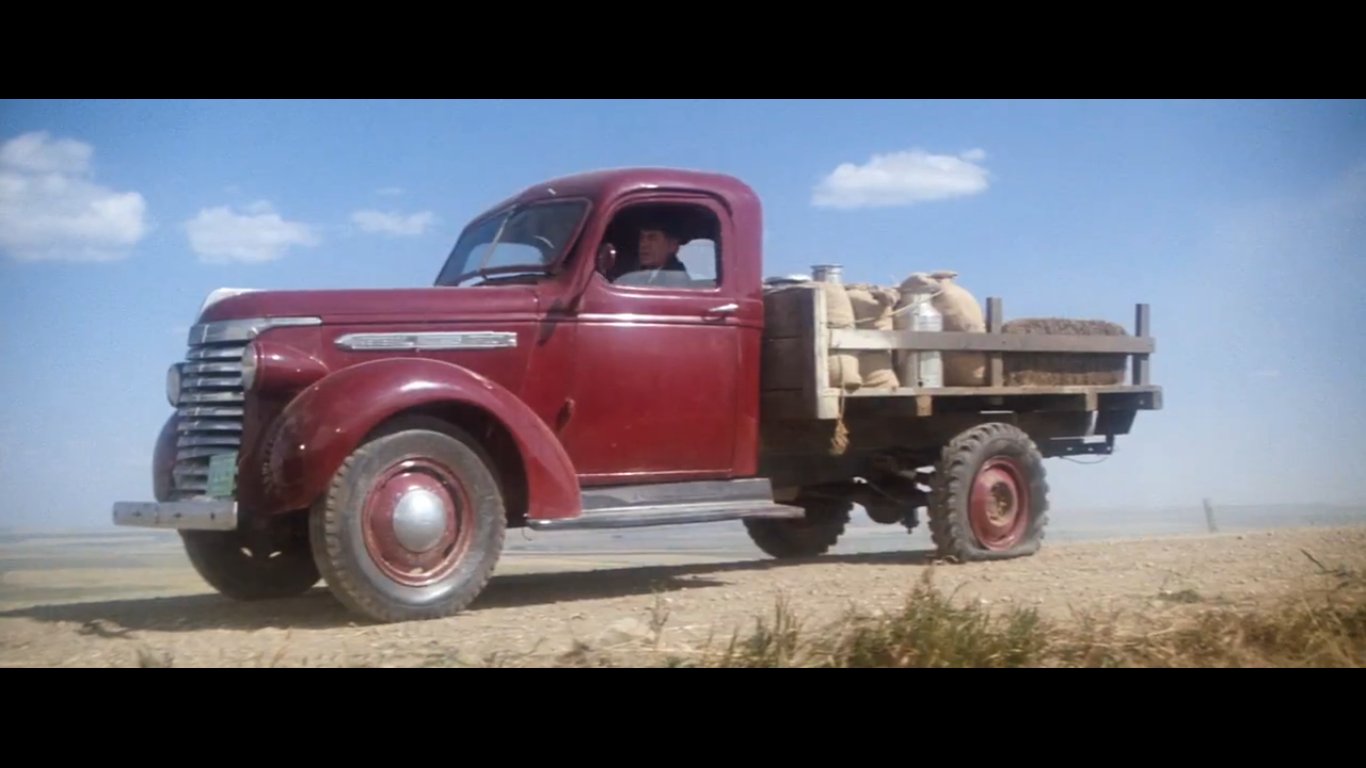
24:04 Geoffrey Unsworth's cinematography in this movie is excellent across the board, but this shot--of the Kents staring in awe at something just offscreen, with the hazy landscape of blue skies and wheatfields behind them, is like something out of prime Steven Spielberg.

26:17 The moment the truck starts to fall on Jon Kent and baby Kal-El catches it and hoists it up could be played any number of ways. It could be played for laughs. (Especially with the Jim Halpert-esque reaction shot of the Kents glancing back at the spaceship in the field.)

It could be played for horror. This baby could be a monster in human form. They don't know where he came from, what he's capable of, what his intentions are. Obviously, the movie chooses neither of those options and goes for a sort of muted awe, but that choice was never a given.
26:24 Presumably, whatever uncertainty the Kents have about their new baby, they've made peace with during this time jump. But it can't be overstated, just how little they know about young Clark, or how little he knows about himself, during these first 18 years of his life.

27:21 This isn't dwelt on too much, but this is the first implication that Clark's incredible strength is more of a curse than anything else--always a football team assistant, never a player. Letting the jerks push him around in front of the pretty girl, lest he blow his cover.
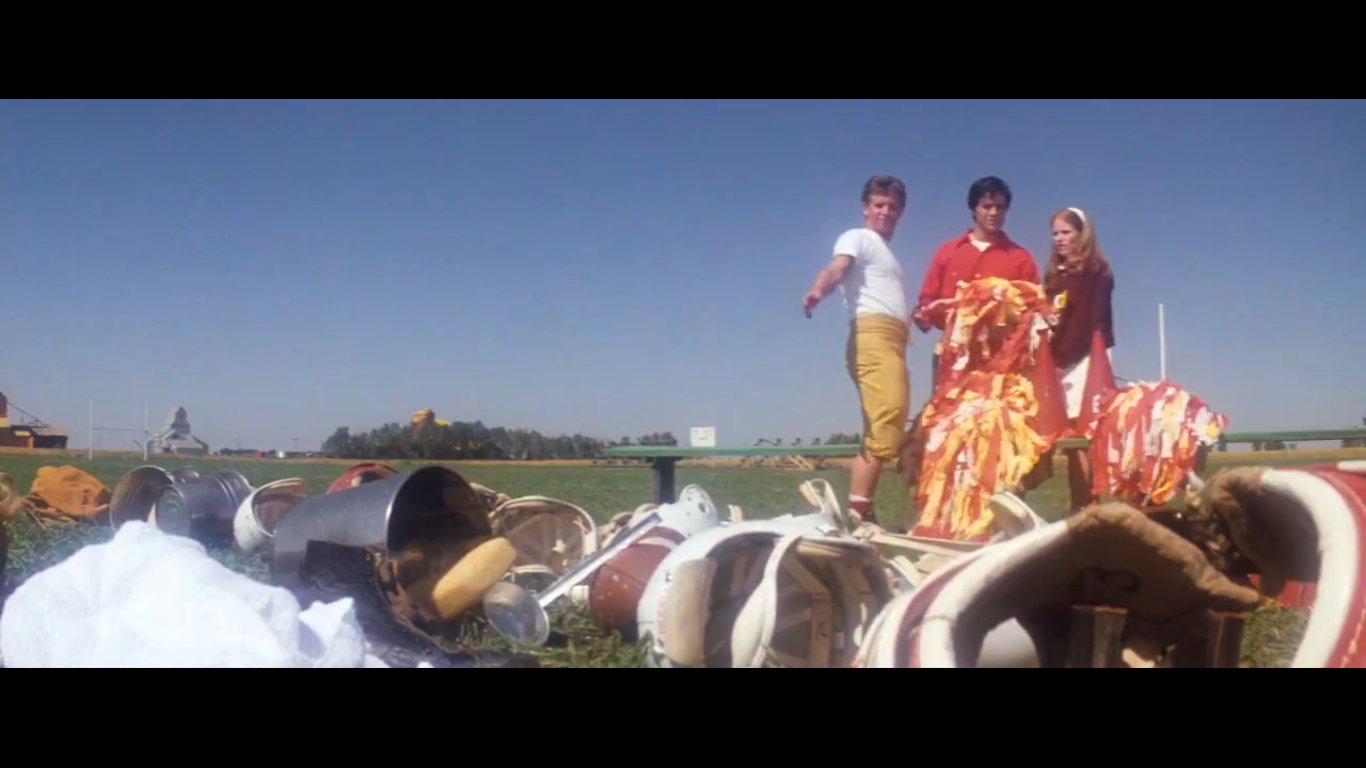
27:51 This is getting a little ahead here, but, if Clark is 30-ish at the time he arrives in Metropolis (which he appears to be at that point in the movie) and if the time that happens is the mid-1970s (which it appears to be), then this scene takes place in the early 1960s.

A lot of people have pointed out that the teen culture depicted in this scene seems much closer to the mid-1950s, but remember that this is the middle of nowhere, and the 1960s as we popularly understand it did not instantaneously happen just because the decade rolled over.
28:24 A part of this scene that didn't make it out of the cutting room reveals that the girl on the train is a young Lois Lane. In my opinion, they were wise to remove it. It's a little too cute, a self-referential elbow in the ribs, better suited for a Star Wars prequel.
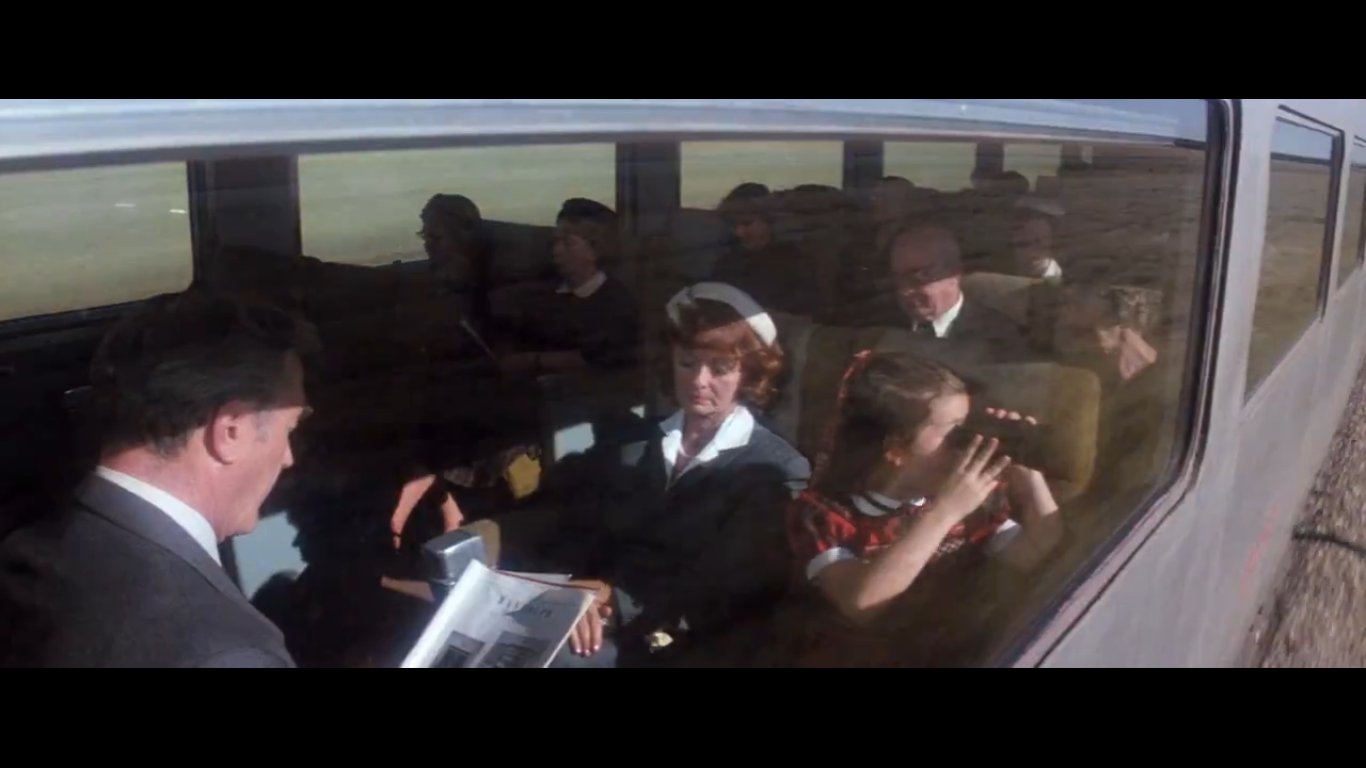
29:04 This shot of Clark booking it down the road is one of the most ingenious special effects in the movie--they just dragged a bag of sand behind a motorcycle. It's an absurdly simple solution, like how they did the gunshot to the head in Full Metal Jacket (Kubrick, 1987).

30:13 This conversation between Jon and Clark is magnificently written and performed, but it wouldn't be nearly as effective if we hadn't already seen the evidence of Clark's frustration with keeping his powers a secret--his fantasies of acting out. That stuff had to be there.
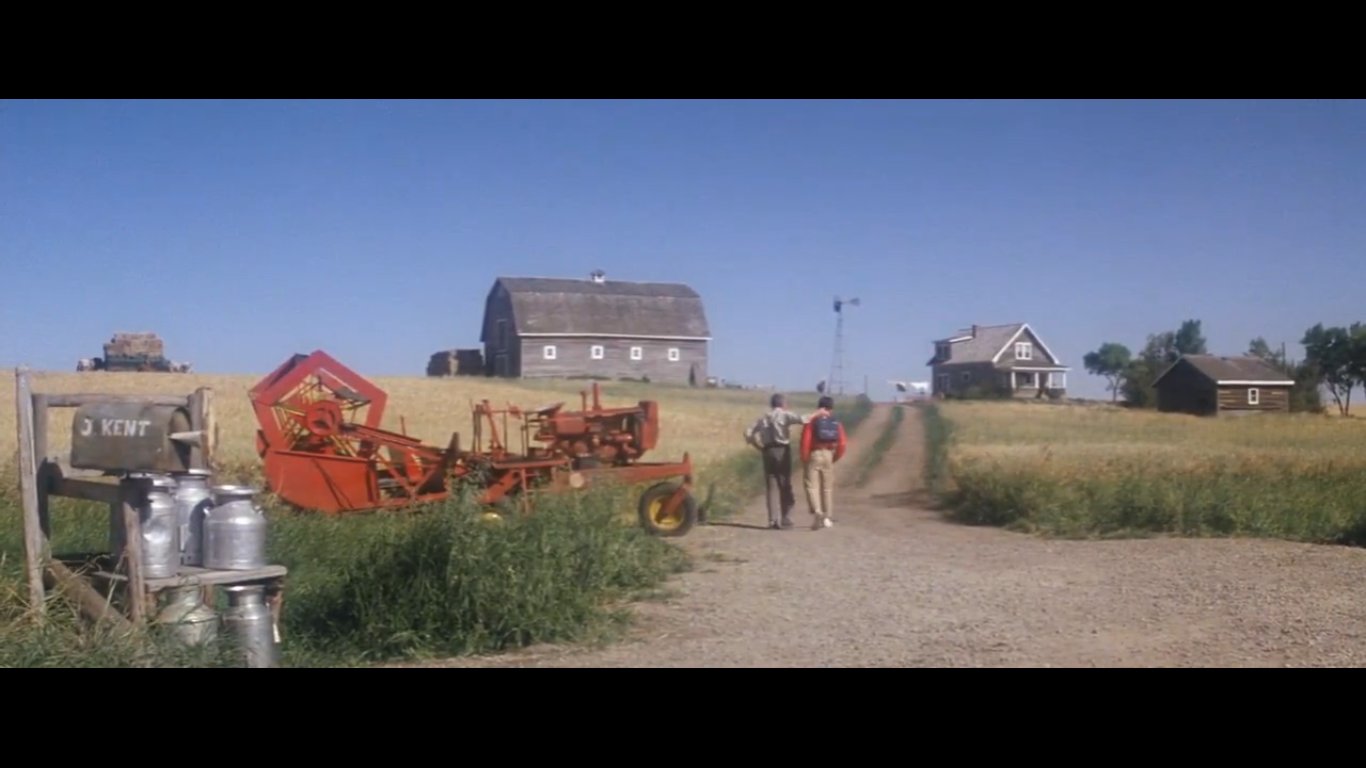
A lot of modern superhero movies don't get this. They try to relay the interiority of their characters through conversations like this one. But, because there's no groundwork for it, it ends up feeling perfunctory. They mimic this approach without understanding why it works.
30:18 This is a lengthy shot, but it doesn't call attention to itself. A lot of long takes are very flashy, a chance for the director to show off, but whether it works or not is down to whether or not it's an appropriate choice for the emotional effect of the scene. Here, it is.
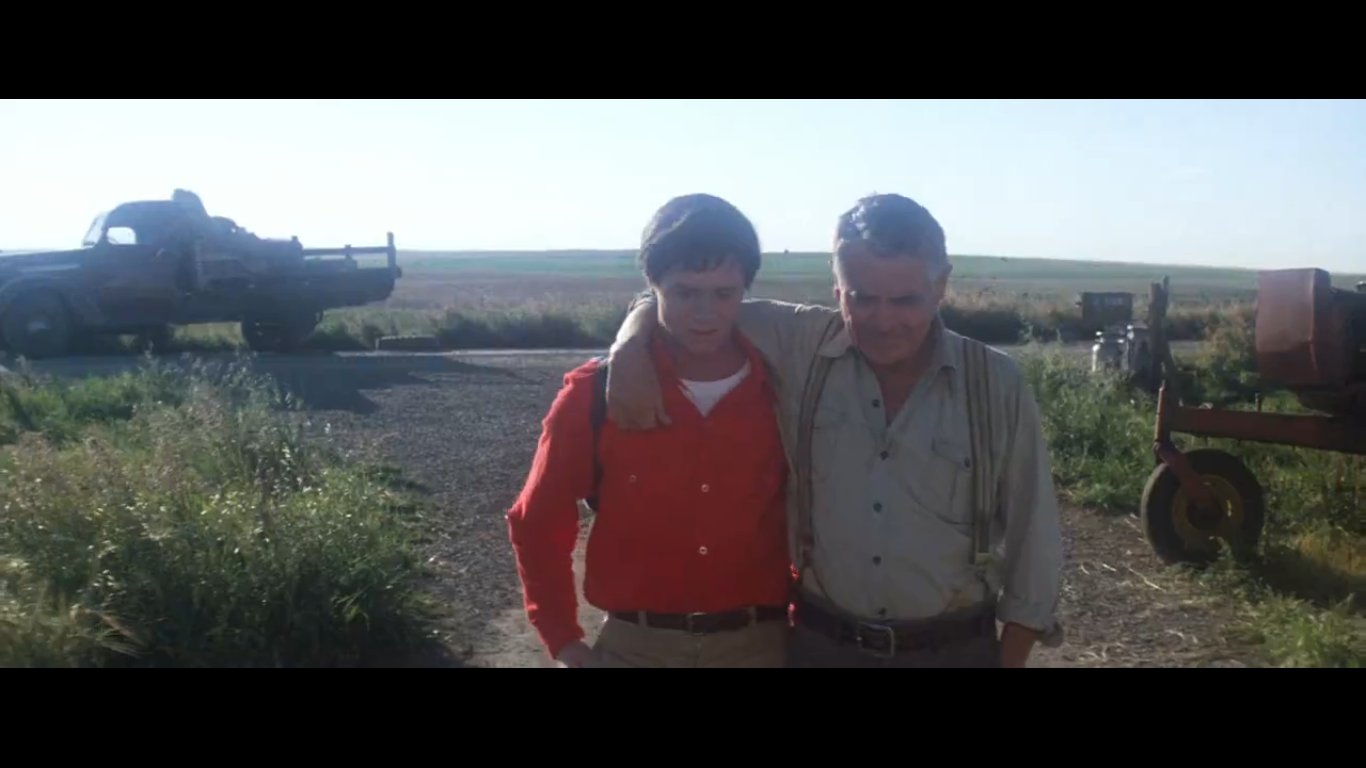
Unsworth didn't set up any lights for this shot. He used a white card and natural sunlight.
I know I keep harping on modern superhero movies, but their actors are usually lit as neutrally as possible so that they can animate any backdrop they want later on. It never looks good.
31:14 Francis Ford Coppola once accused this of being a movie about nothing. Which is fine; he can have whatever opinion he wants. (Also, he's Francis Ford Coppola.) Having said that, Jon Kent's line here, about Clark being here for a reason, is setting up an important theme.
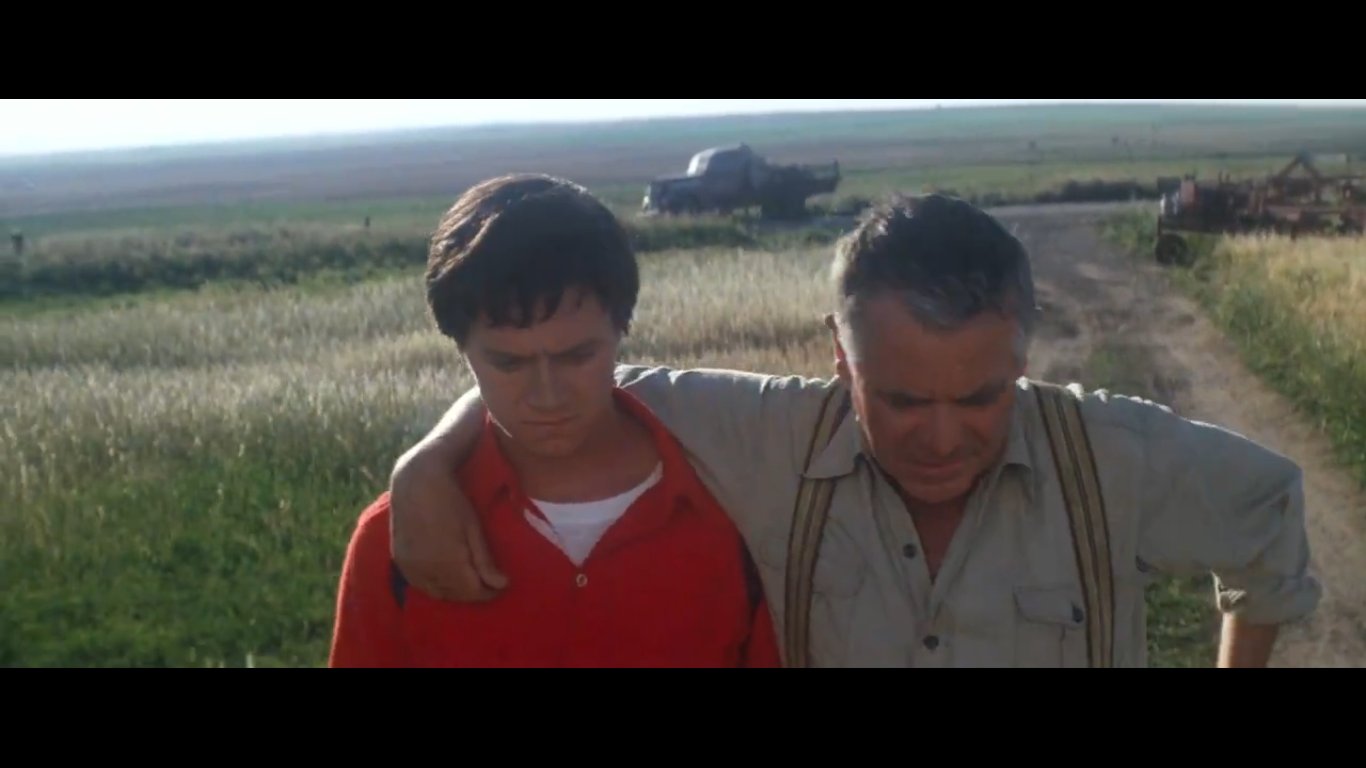
Themes are nothing if a movie sets them up and doesn't do anything with them, but this one does. It's very much a movie about what someone decides to do when they can do absolutely anything, and why they make the choices that they make. And, in this case, it isn't subtle.
31:26 And... cut.

That was a one minute and seven second shot of two men walking down a driveway, just having a conversation about the important things in life. This, in a movie known primarily for its action sequences and special effects. And you know what? It's damn riveting.
31:51 Not to be a smart aleck, but this might be the best way of working around the problem of Jon Kent's death--the problem being, if Clark has super hearing, super speed, and instantaneous reflexes, why wasn't he able to rescue him? The answer: he was distracted by a dog.
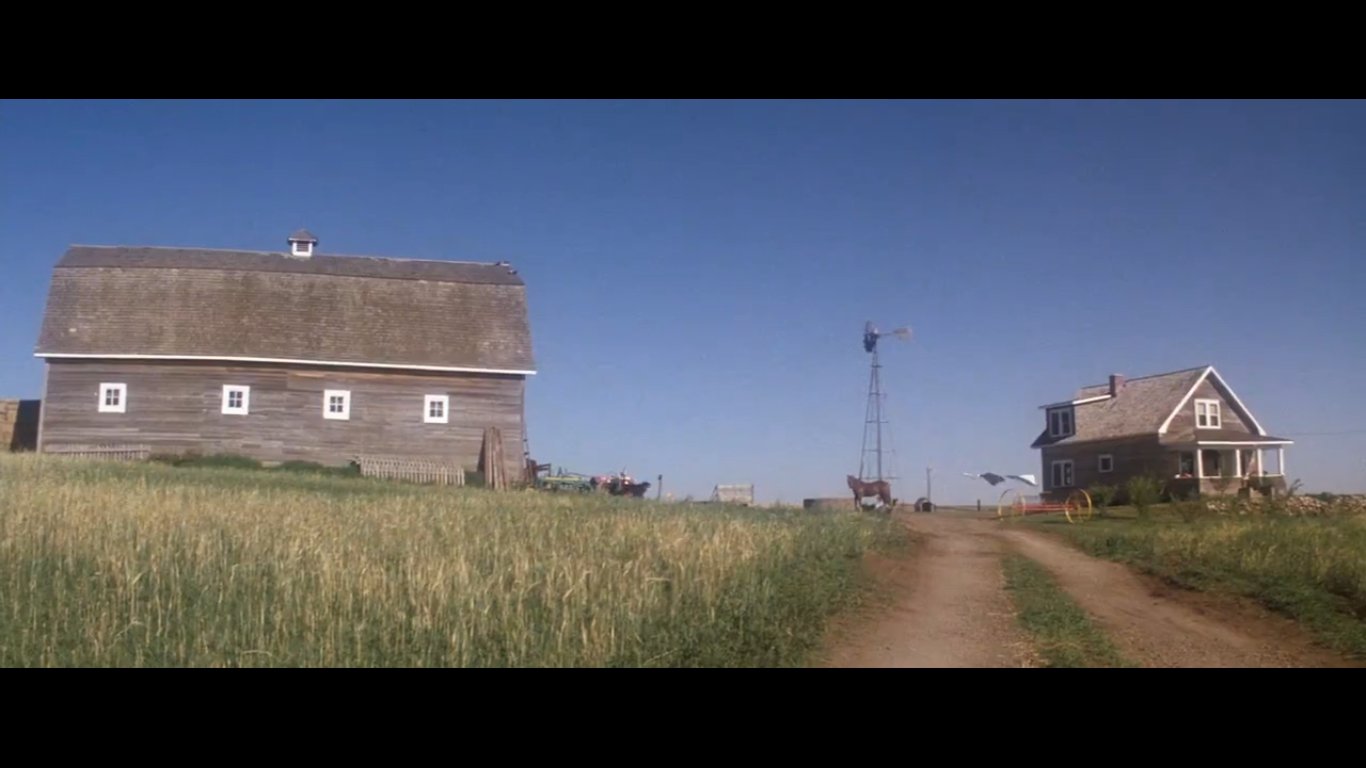
33:18 "All those things I can do, all those powers, and I couldn't even save him." There you go. That's all it takes. Jeff East's haunted performance (with an assist from Christopher Reeve dubbing his voice in) shows just how much this moment will crystallize his adult identity.

34:06 I would have to watch the music-only cut of the movie to know for sure, but there's an underlying noise here (not just the radio interference) to imply the crystal "calling" Clark out to the barn, and I can't tell if it's a sound effect or part of the instrumentation.

34:32 Ah, the majestic middle American wheatfields of Calgary.
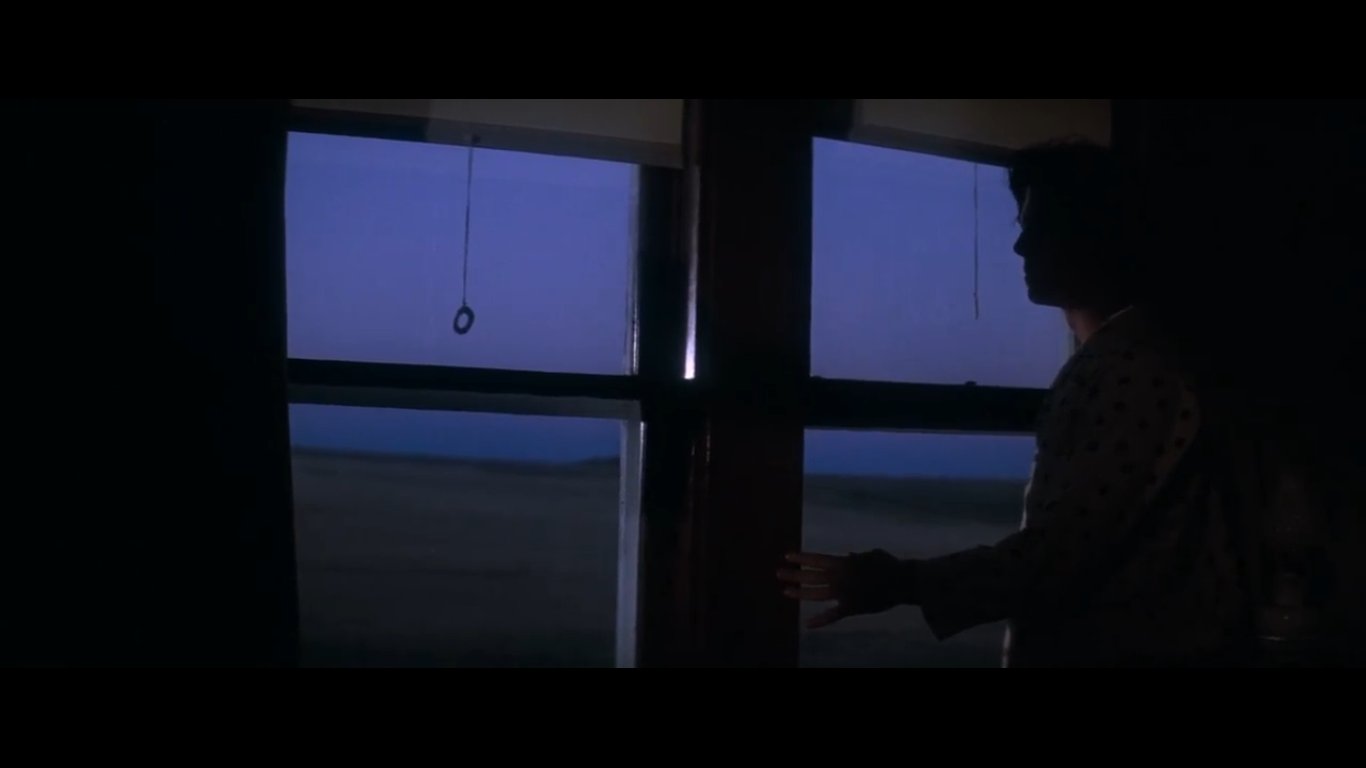
The sound effect of the crystal is definitely a part of the sound effects here, growing louder as Clark enters the barn and gets closer to it. It's a great narrative device for conveying information without dialogue.
35:24 Here's something you miss in the cropped version: the Kents' horses. (My history with this movie displayed in 4:3 can be found here.) A touch of verisimilitude for a movie that never has any actual farming in it.
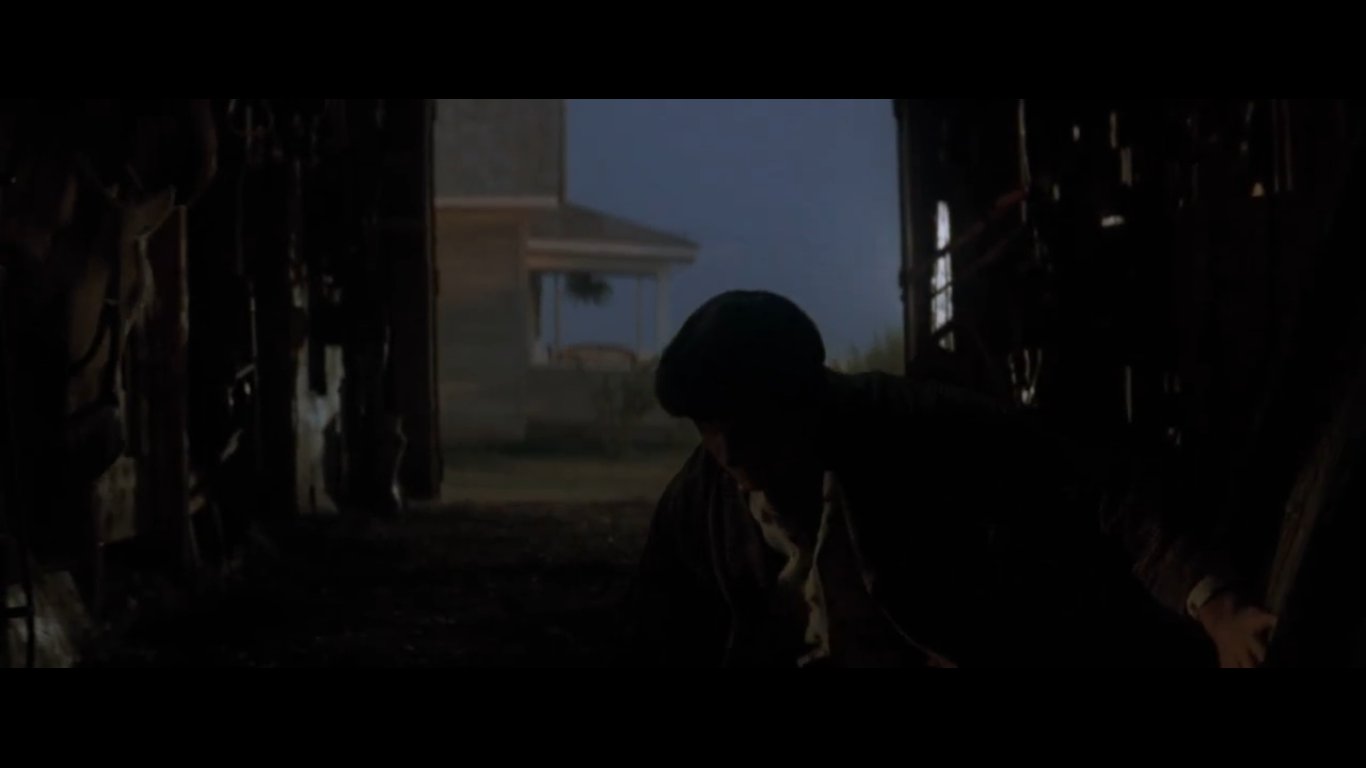
36:03 The real skill of cinematography has nothing to do with capturing pretty pictures. It's about arranging, lighting, and shooting the best possible combination of visual elements to convey the story information necessary at any given moment, with a consistent style.
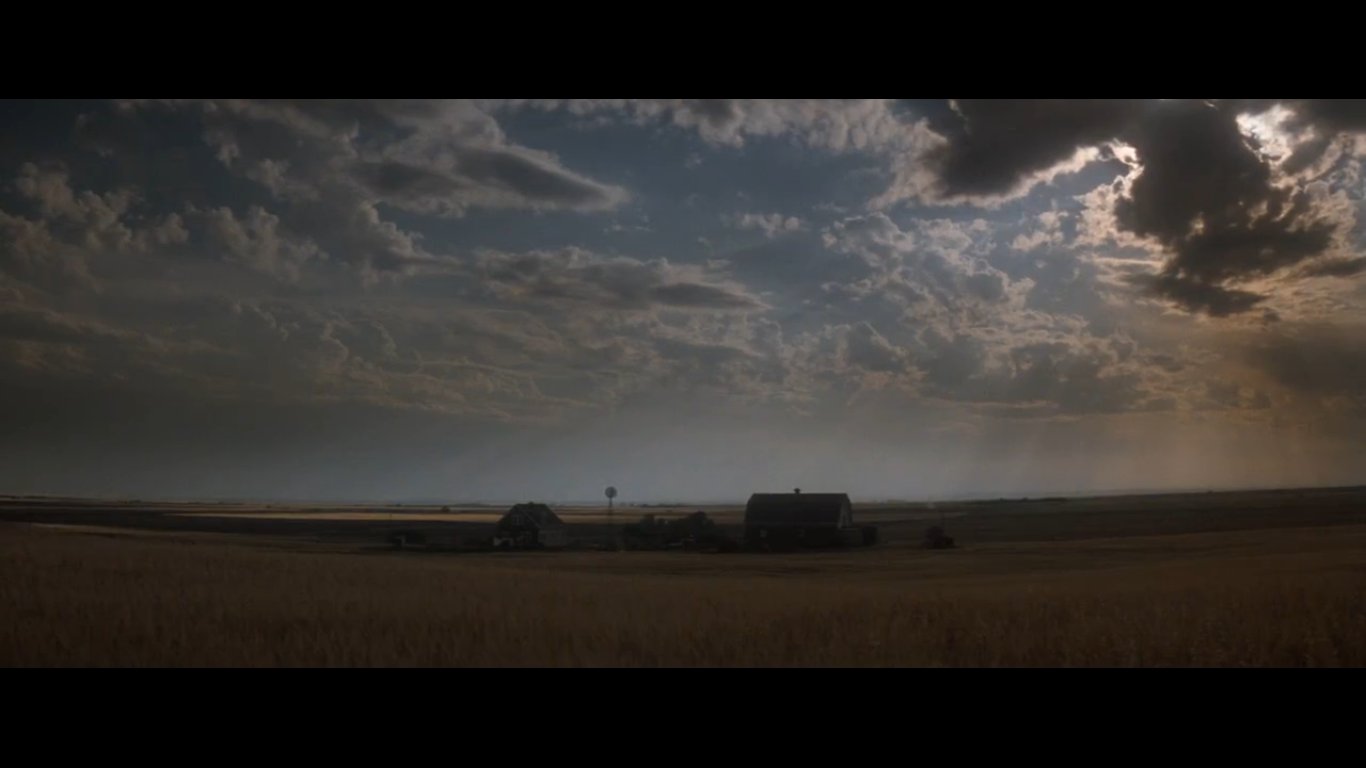
That said, Geoffrey Unsworth could capture the hell out of some pretty pictures. Look at this establishing shot. Can you believe we get to live on this planet?
36:13 This shot makes me grateful that the rest of the movie doesn't get too out of hand with the product placement.

36:21 This actor is Phyllis Thaxter, the mother-in-law of producer Ilya Salkind. She appeared in TV shows such as The Twilight Zone and Alfred Hitchcock Presents, as well as many movies since the 1940s. She has one of those wonderful lived-in faces that's made for the big screen.

36:30 Another casualty of the cropped version of the movie is this rare cereal box, with the same artwork printed on both sides!
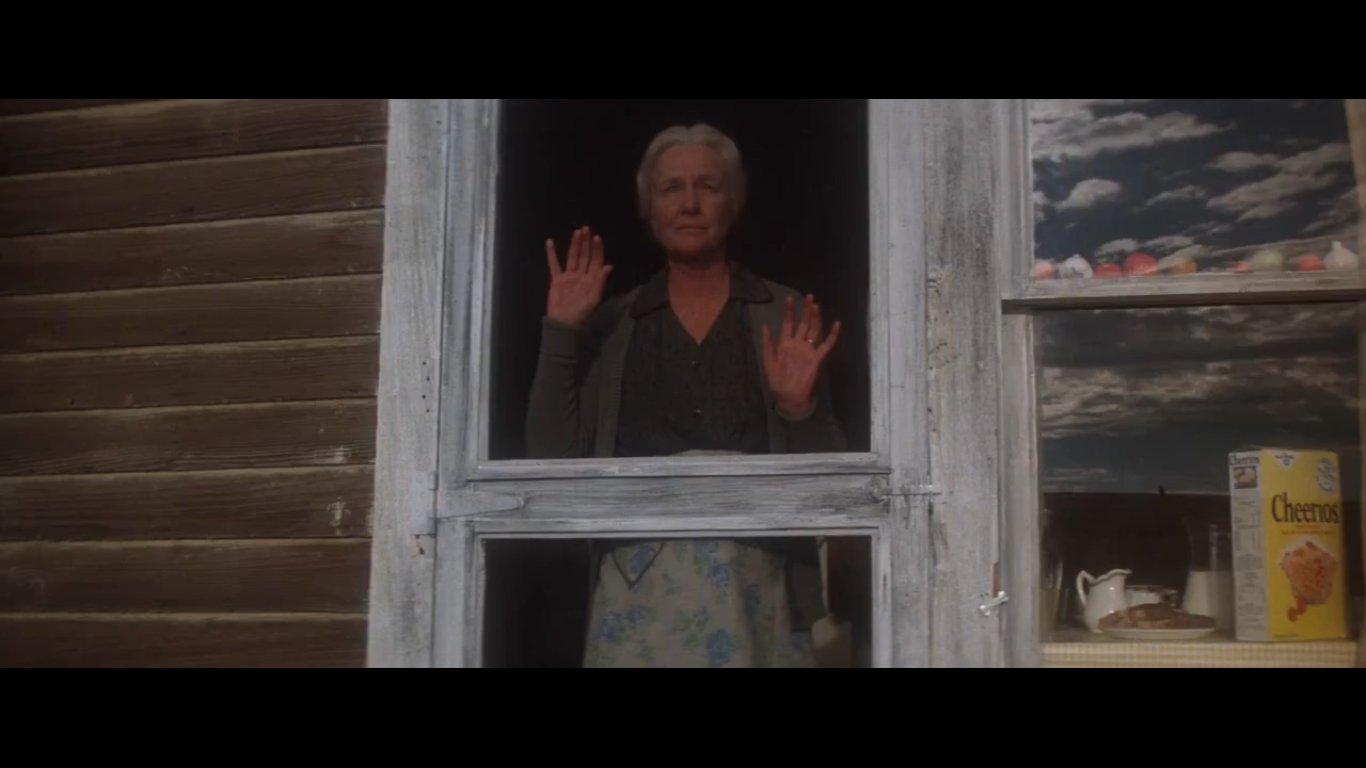
36:34 We get a lot of shot-reverse shots of Martha looking to the horizon to where Clark is standing, which allows this great moment to breathe.
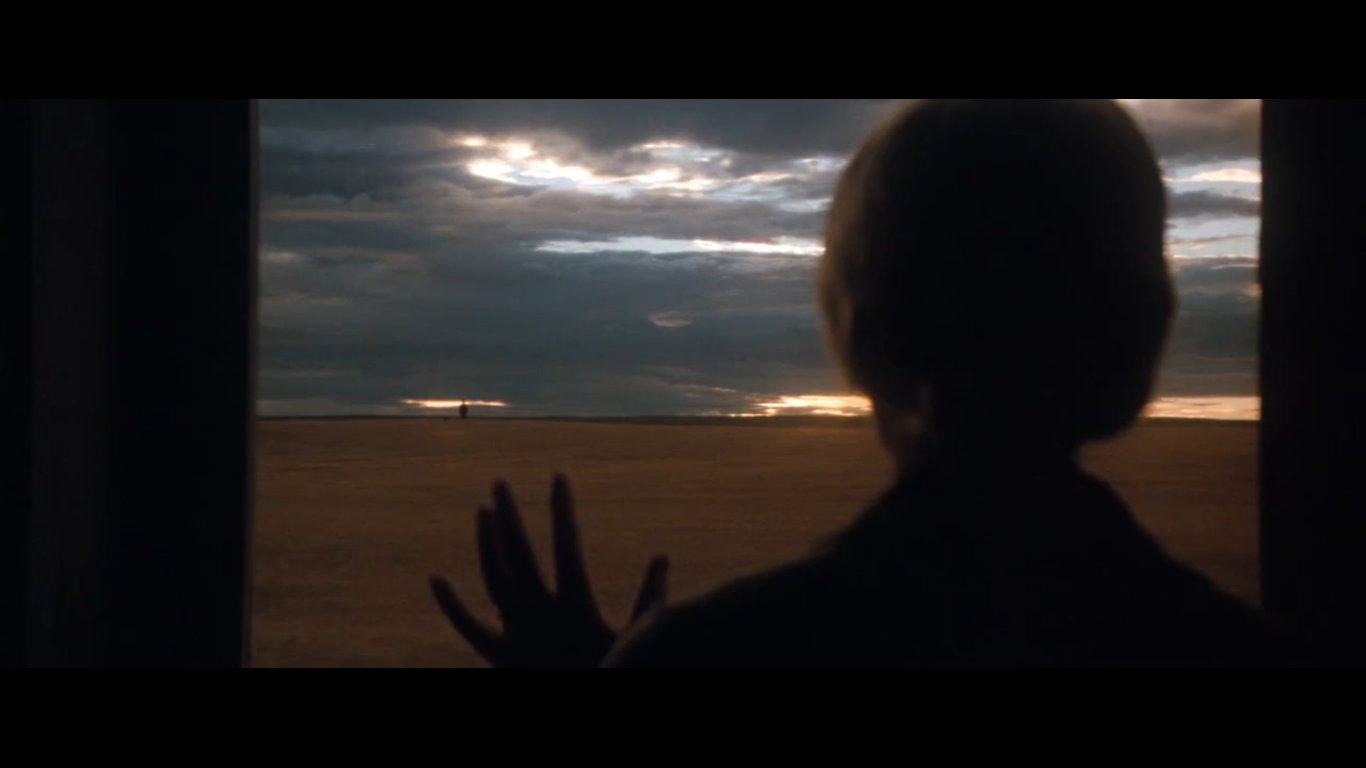
39:27 Here, we go from aerial photography of (presumably) the actual arctic--probably stock footage--to a magnificent set built on the 007 Stage at Pinewood Studios in England. The cavernous size of this building and its massive water tank made it ideal for this scene.

This stage was built for the The Spy Who Loved Me (Gilbert, 1977), at the request of legendary James Bond production designer Ken Adam. The skies in these shots were painted on glass by visual effects supervisor Les Bowie. These matte paintings cover up the lighting rigs.
40:01 This is a bit of handmade set in the foreground here, and everything else you see is a painting lit from behind. The results are astounding.

40:15 I like that a big deal isn't made of this, but you can see his blankets from the spacecraft in here--red, blue, and yellow.
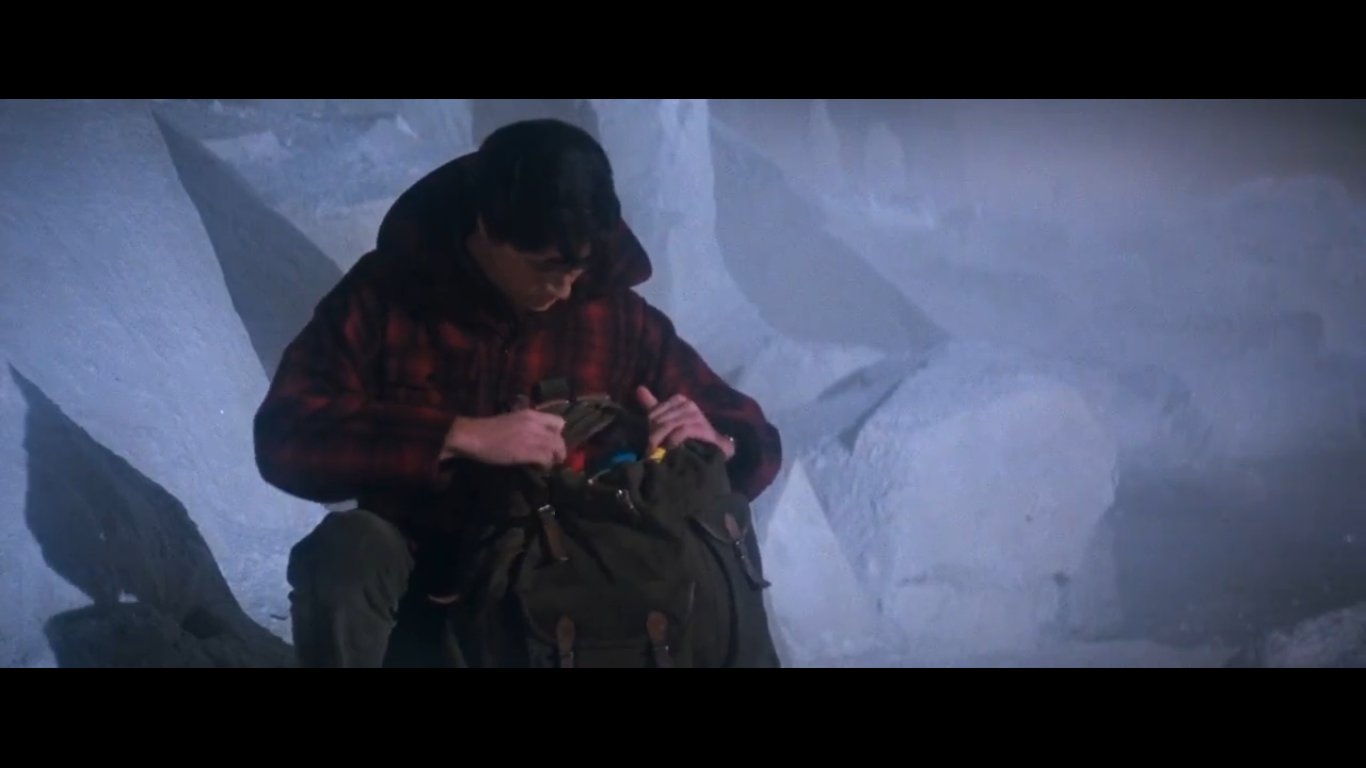
40:38 The editing here is clever. He goes to throw the crystal, but you never actually see him release it. You see the windup, and the crystal is out of frame when he presumably lets go of it. This is because the light in the crystal is powered by a cord running up his arm.


41:24 Great science fiction here, retroactively explaining the architecture of Krypton and its crystal technology. Not only do they build things out of crystals and store information in them, but they can literally grow things from them, as we're seeing with the Fortress.
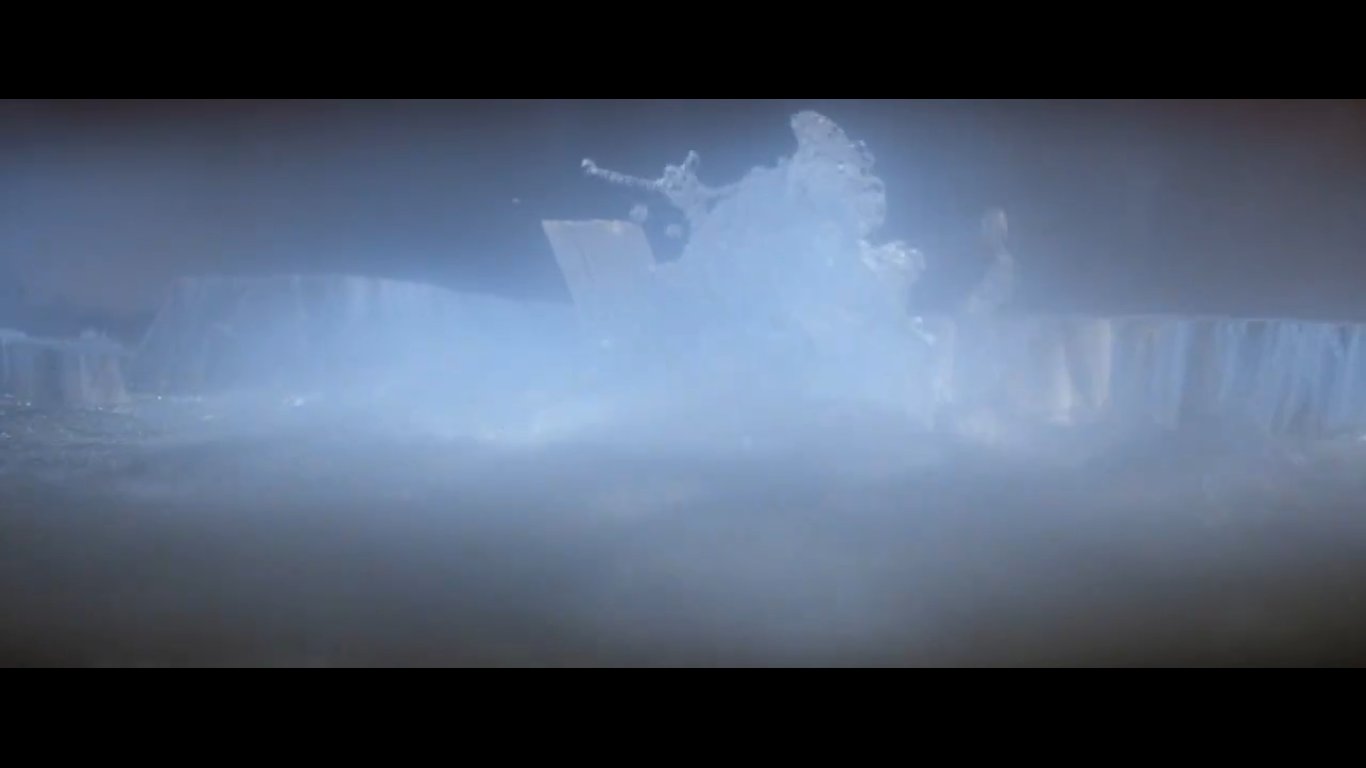
41:36 The effects in this sequence of shots are so cool. It's all water, fog, lights, and miniatures, mounted on hydraulic machines. Everything built by expert craftspeople in the service of an uncanny scene that looks like no other science fiction movie ever made.

42:43 More use of sound effects to imply some sort of extra-sensory instructions being given to Clark. Smart, elegant storytelling, completely unreliant on dialogue. (It's been over four minutes and multiple changes of scene and setting since the last time words were spoken.)

45:12 "Hey kid, you're from space, I'm your dad, and it's been thousands of years since I died." And the best question he can come up with is, "Who am I?"

Really, though, this is a great choice. Faced with the unknowable, what we crave most is the meaning of our own existence.
46:54 Another thing the movie doesn't make a big deal about, but Jor-El just casually dropped that this whole trippy, spacey educational program lasts for 12 years. Assuming Clark was 18 when he left Smallville, this would officially put him at 30 when he becomes Superman.
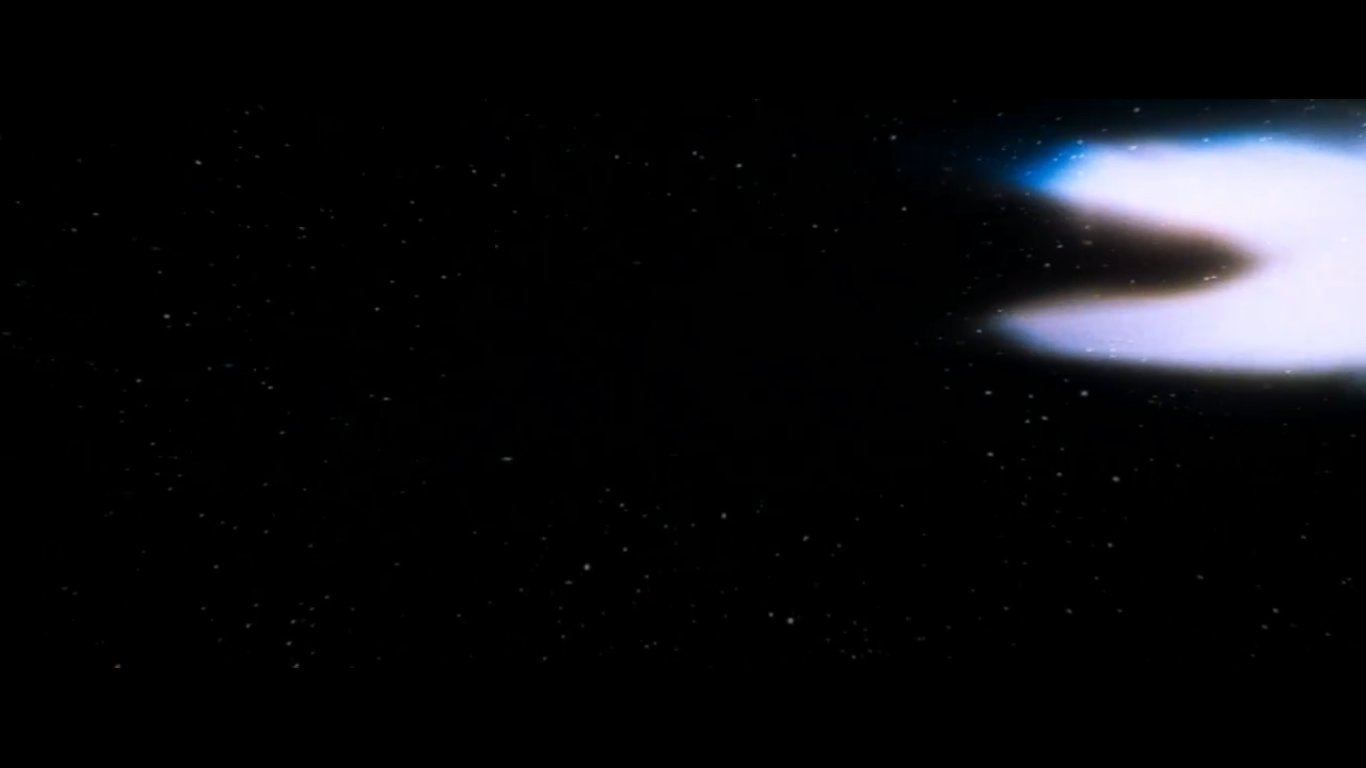
47:36 I don't care for Christ symbolism in Superman stories. It's too on the nose, too normative. For another thing, Superman's origin story tracks much more closely with that of Moses, as I suggest in this essay.

47:59 This is obviously a key moment: the first time we see the character as an adult, played by Christopher Reeve, his first time in costume, the first time he flies. It's wonderfully handled. I even like the accidental shadow over his face--one last bit of mystery to hold back.

48:03 According to director Richard Donner and creative consultant Tom Mankiewicz (also the uncredited screenwriter--see "Mank"), SUPERMAN is a three act story. Act I is Krypton, act II is Smallville, act III is Metropolis.

48:22 Part of the charm of this movie is that it doesn't even try to pretend that Metropolis isn't New York City. Here's the New York Daily News building, standing in for the Daily Planet. (Look for other famous features of the NYC landscape from here on out, if you like.)

SUPERMAN is in the pantheon of movies that preserve the image of pre-cleanup NYC. The notorious New York City blackout of July 13-14, 1977 occurred during the five weeks when SUPERMAN was filming there, as well as the period when David Berkowitz (the Son of Sam) was at large.
49:24 As combative as their dialogue is, the fact that Lois is parroting one of Mr. White's favorite pieces of advice suggests a mentor/protege relationship between the two. Another instance of this movie's sly "no big deal" approach to world building and character development.
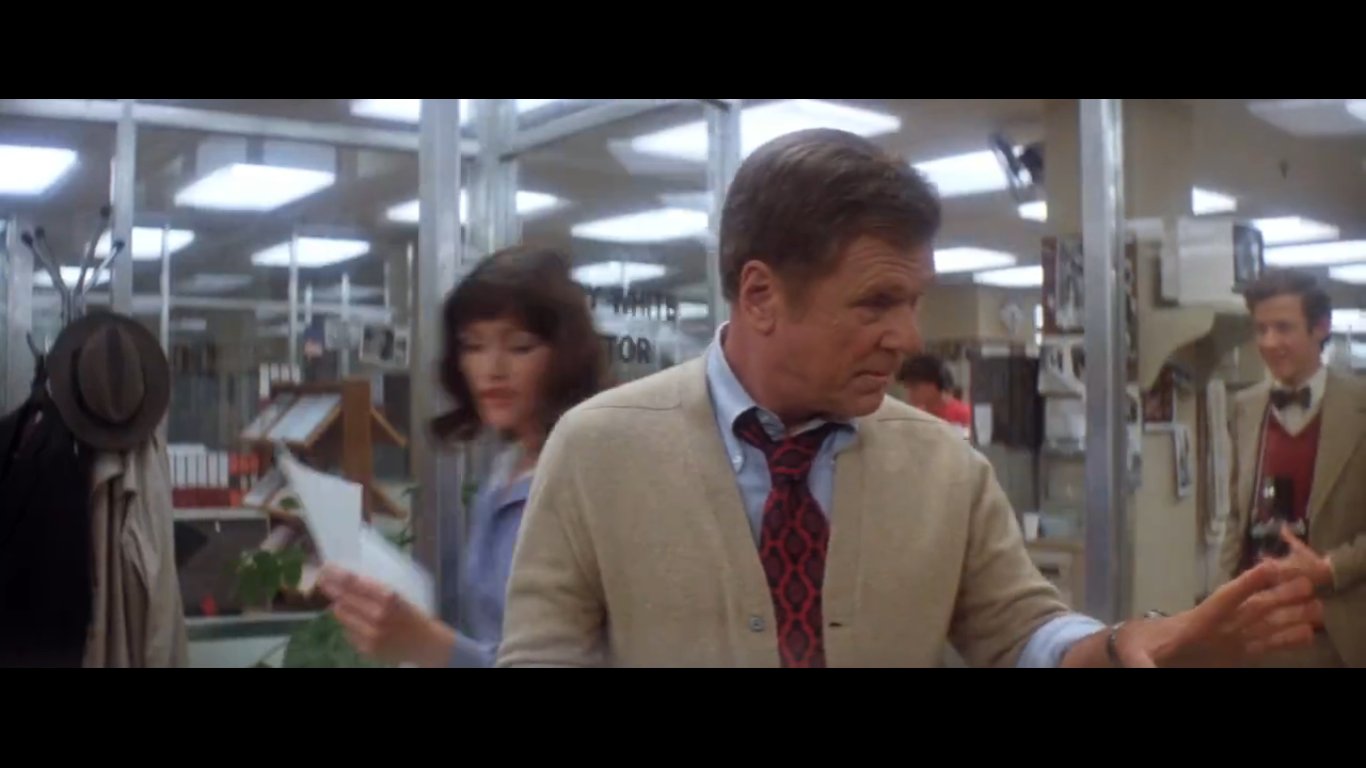
49:35 Nowadays, we'd see Clark in his big glasses and three piece suit and think of him as a classic man. But, in the 1970s, such a look would have recently fallen out of fashion. He'd have seemed out of touch next to all those loud colors and big ties at the Daily Planet.

51:29 "Actually, she's silver-haired." See, I'm not totally against talky scenes in superhero movies. But if you're going to write a bunch of dialogue, this is how you write dialogue.
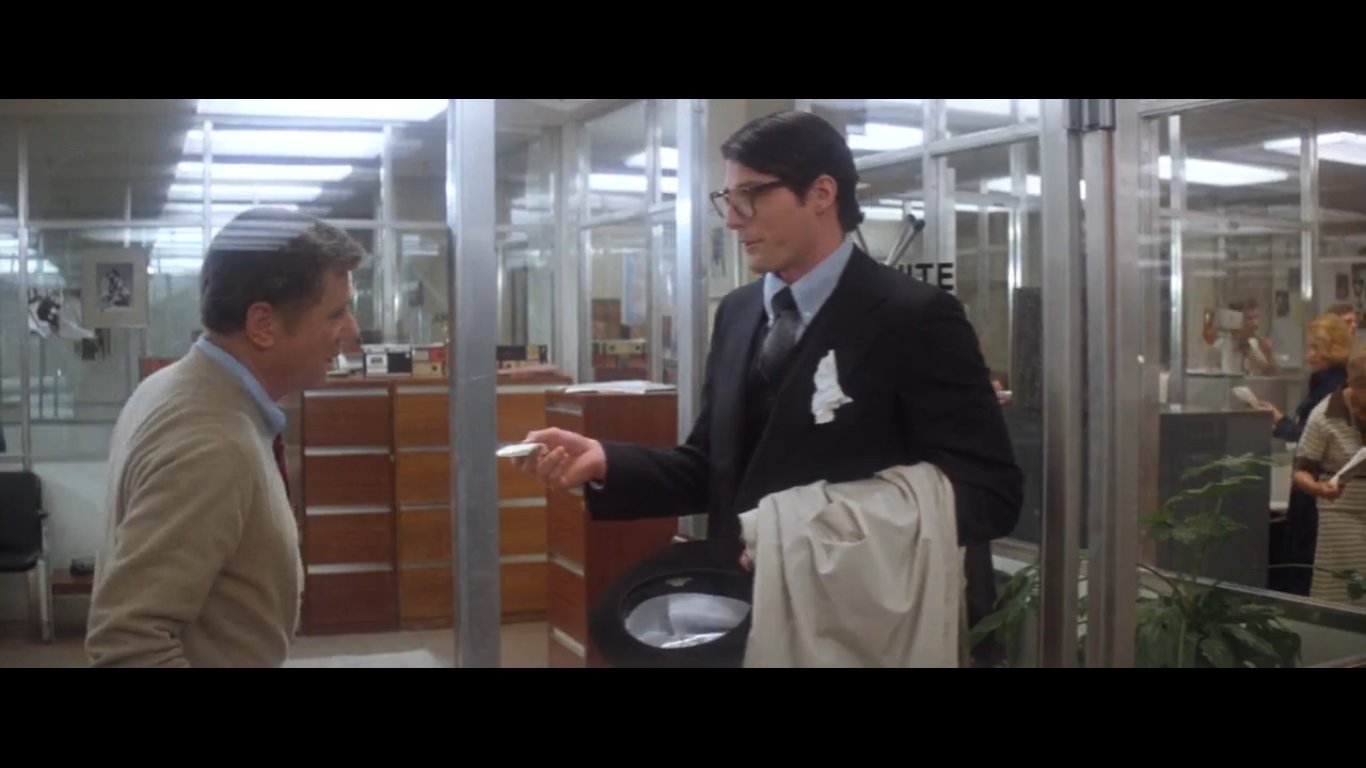
52:37 We are officially in the "romantic comedy" segment. Soon, we'll even get a meet-cute.
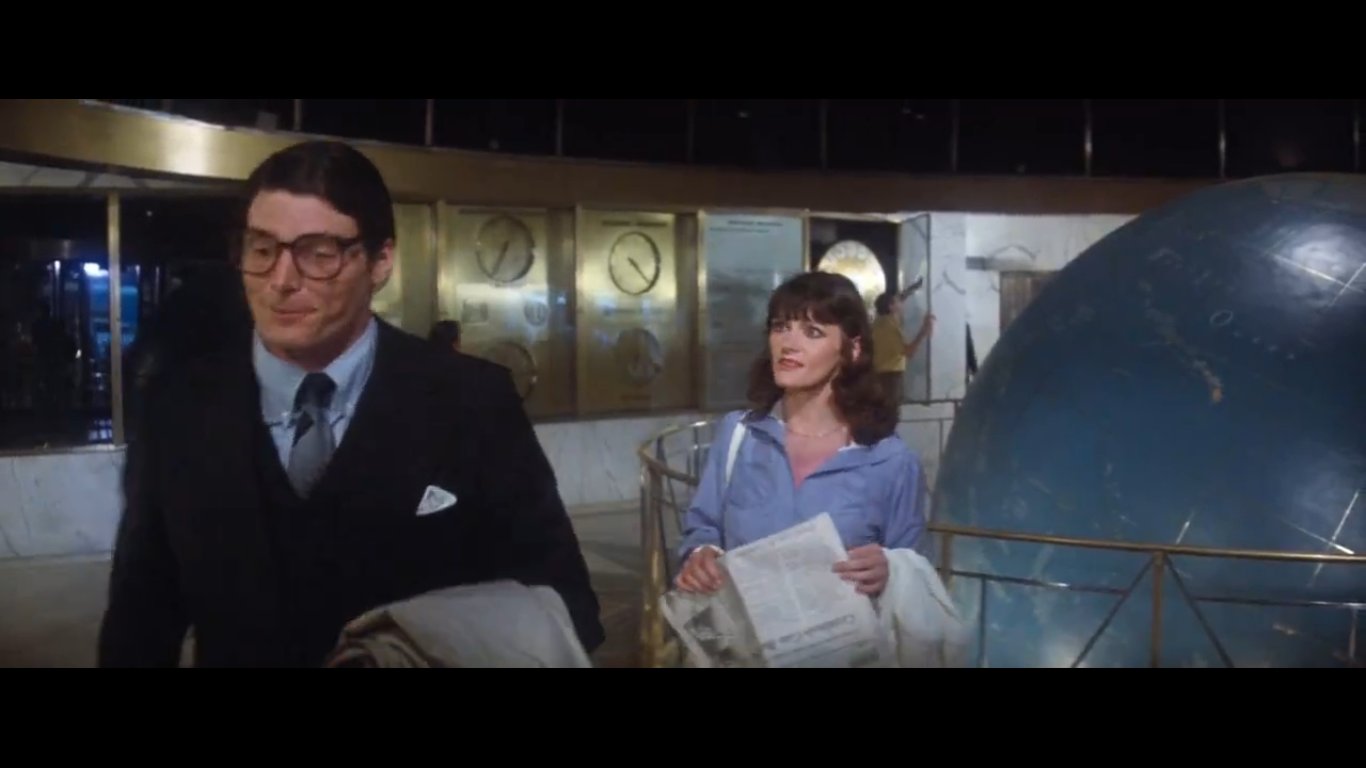
53:01 Rex Reed making such a wise choice of movie for a walk-on appearance almost makes up for his writing career.

55:24 I'm trying to hold off on talking about the music, but John Williams is laserlike in his ability to tell us exactly what kind of person this is.
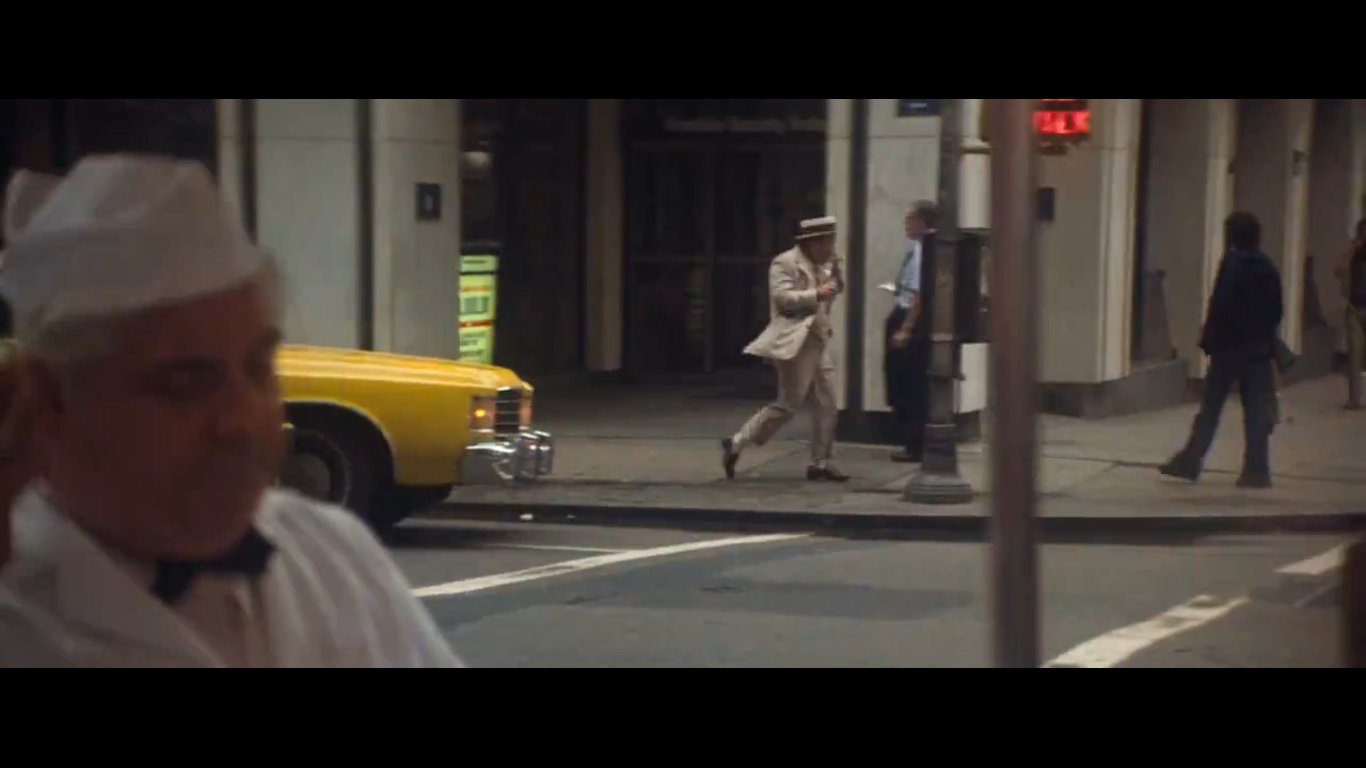
56:25 Richard Donner got his start directing episodes of TV shows like Kojak, Get Smart, and The Twilight Zone. ("Nightmare at 20,000 Feet," famous for William Shatner losing his mind on an airplane, was one of his.) This cop stuff shows his knack for shifting between genres.

1:00:15 We haven't seen the whole thing yet, and this is already a villainous lair worthy of Ken Adam. We're used to compounds built in caves or mountains, but we rarely get a good concept anymore--in this case, designed as a repurposed subway tunnel. John Barry strikes again.
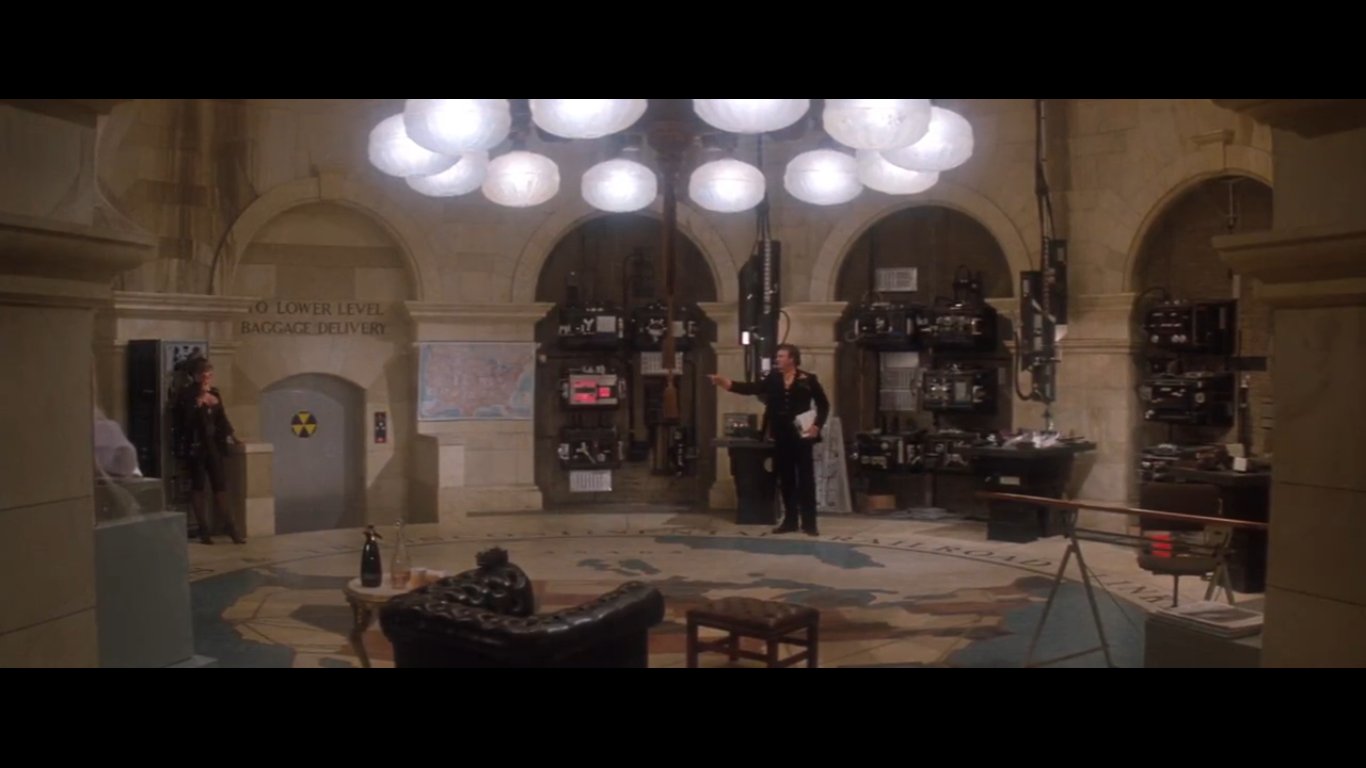
1:00:32 Some things in this movie went over my head as a kid, including the purpose of Valerie Perrine's plunging neckline.
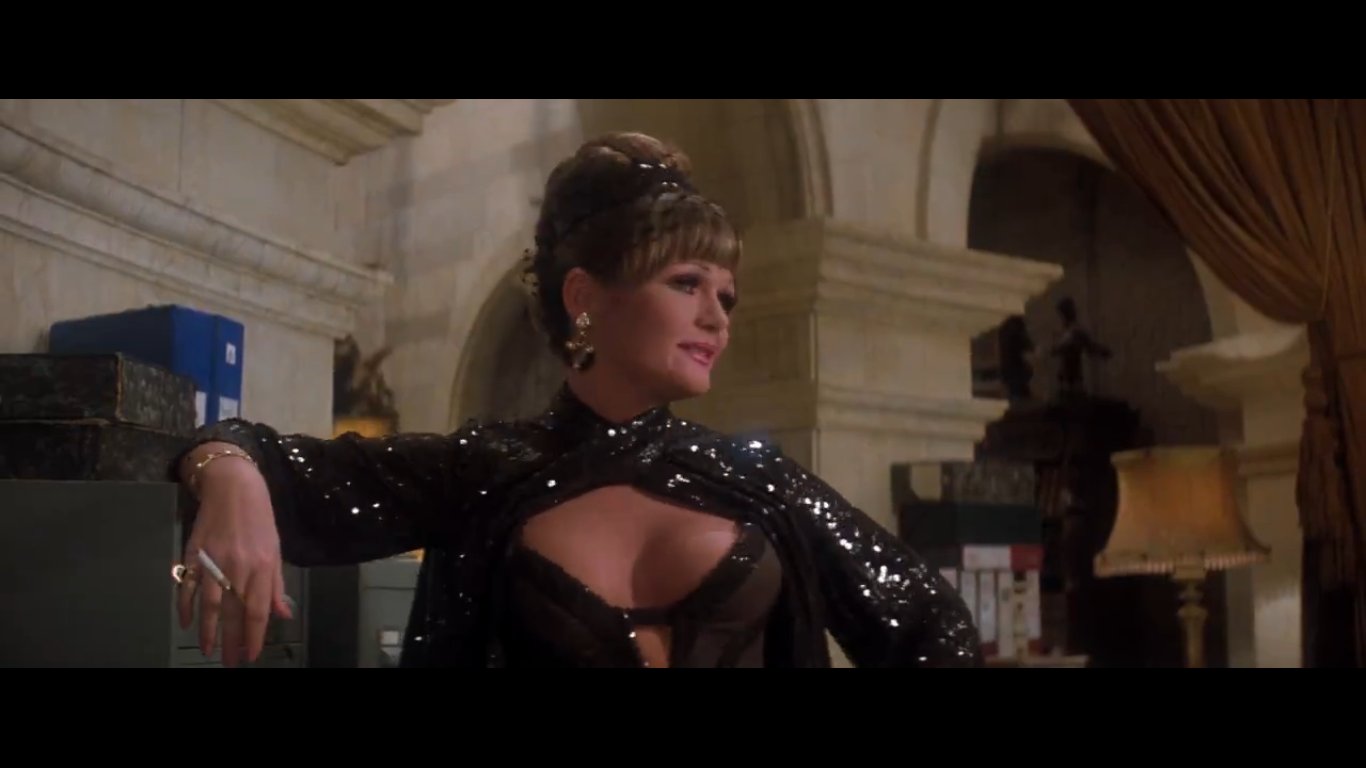
1:00:59 The size and scale of this set may not beat, say, the Fortress of Solitude, but it's still impressive. We used to build things for these movies.

1:03:38 Clark's commitment to the mild-mannered act isn't going to keep him from shooting his shot, and Lois Lane is not one to miss out on the big '70s neckties.
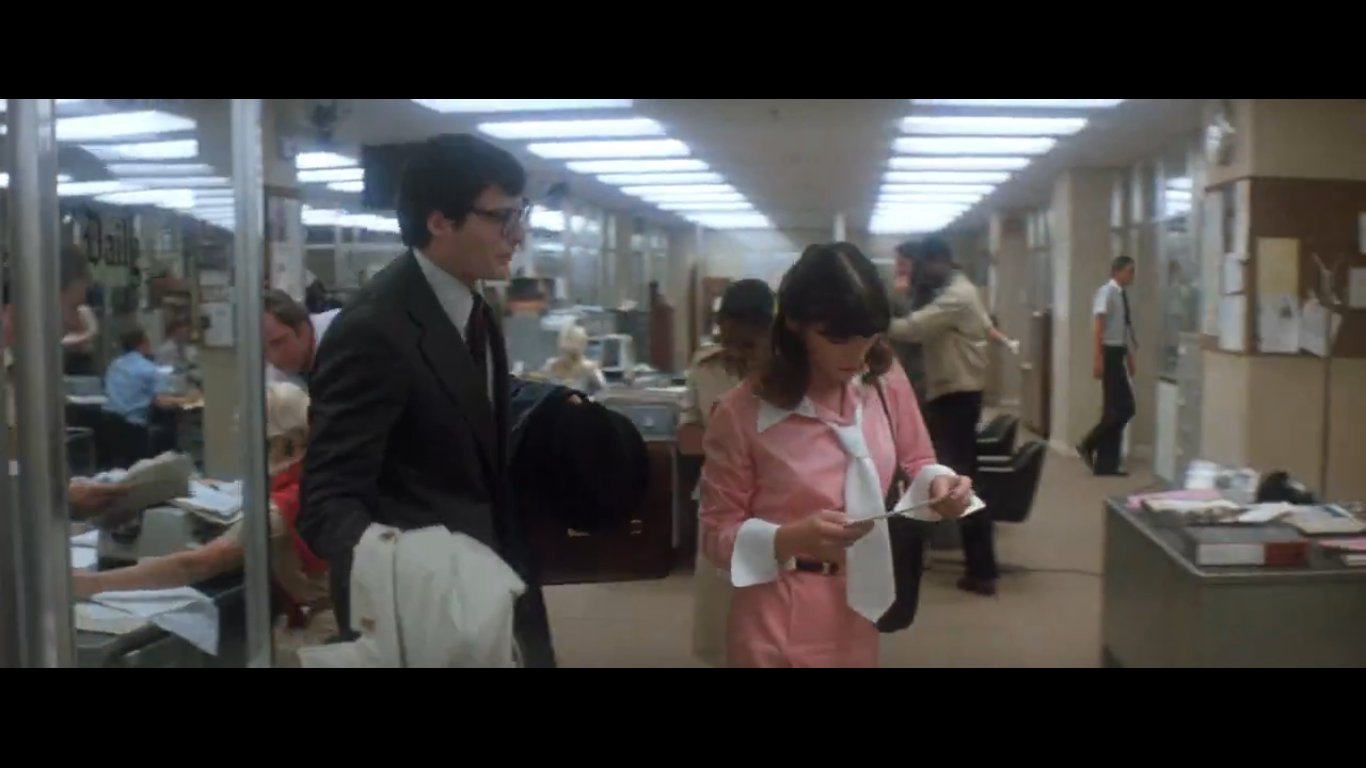
1:06:09 What are the odds that an accident this unlikely would happen to someone Superman personally knows?

1:06:50 Letting us see how long this drop is through Lois's eyes is crucial for establishing tension. A lot of action movies screw this up when putting their characters in peril.

1:08:01 And the hat that fell prior to 1:06:50 is just now landing, just to drive the point home.
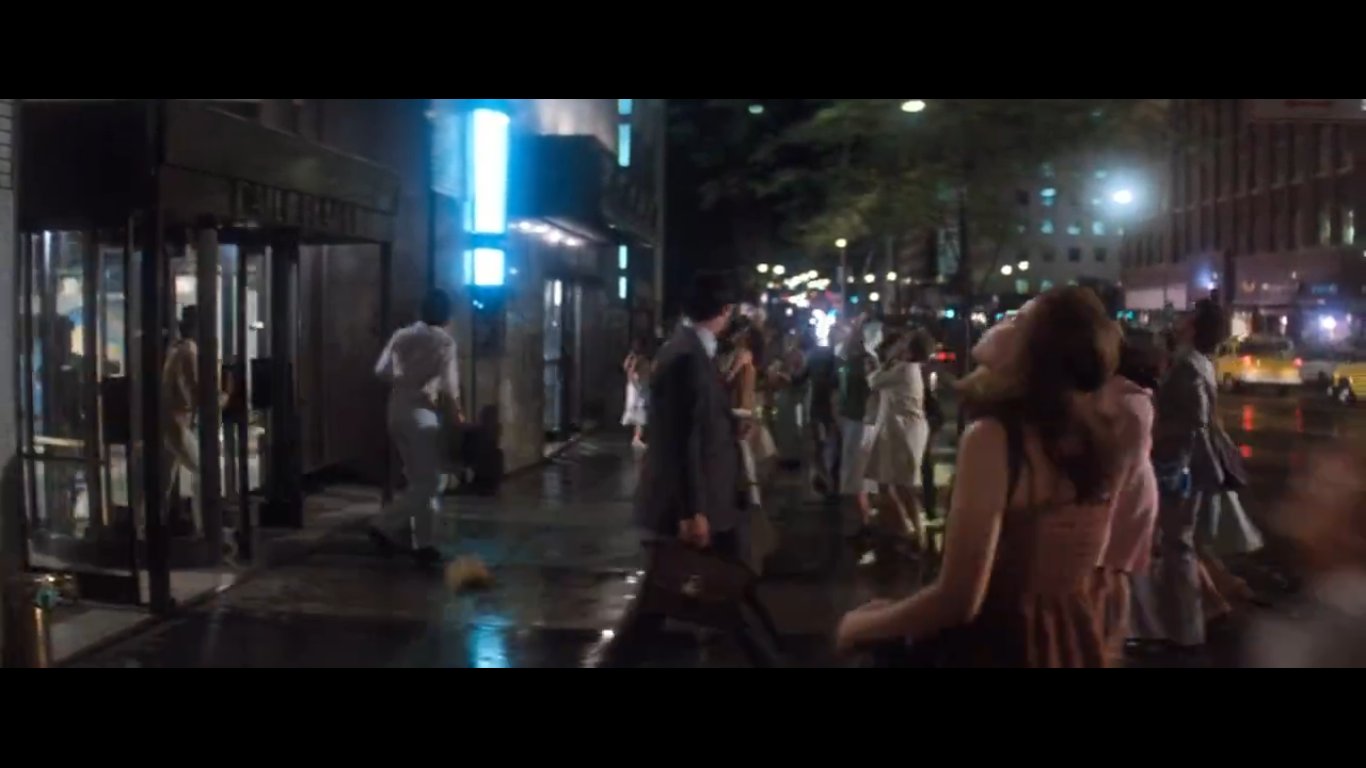
1:08:20 Here's a gag for anyone who wants to know how far back people have been making fun of Superman for changing inside a telephone booth.

Of course, the number of instances of the phone booth change in official Superman canon is slim, so who knows why it stuck?
1:09:12 If this is the romantic comedy segment, here's the meet-cute. I doubt it's ever been done better.
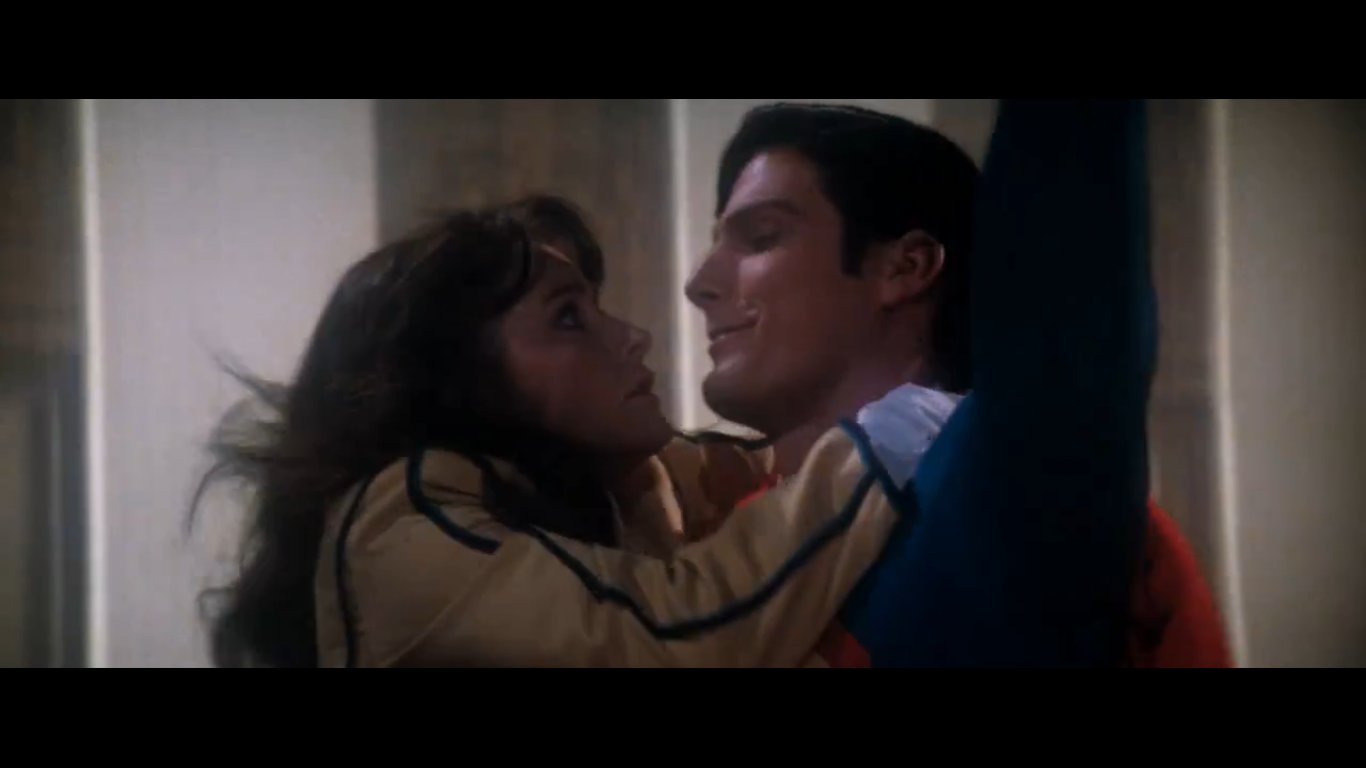
1:10:19 It can't be overstated, the fine line they walked with the costume, and how well it turned out. More here.
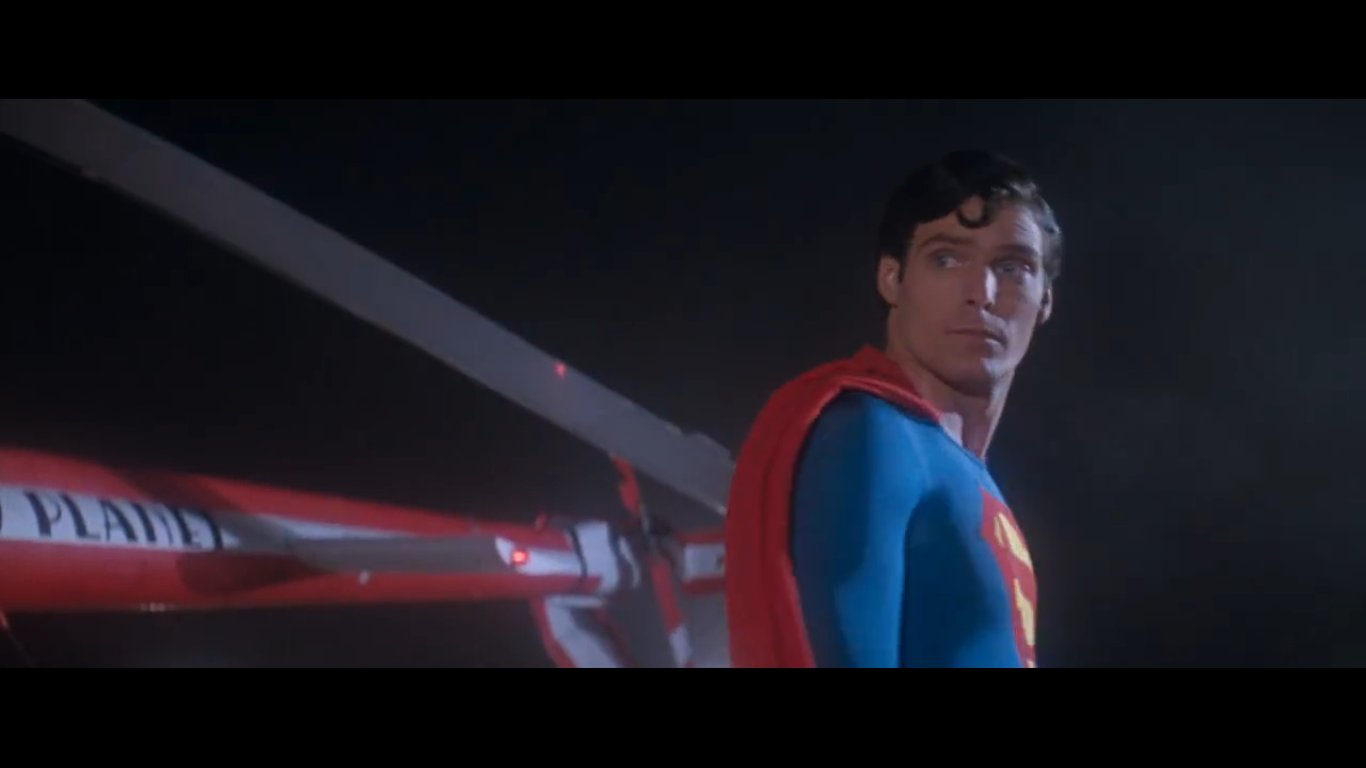
1:14:03 One of the smart things this movie does is recognize that Superman isn't cool. He's admirable, but he's a square; the quips he makes at the expense of the crooks he brings in are meant to land with a thud. The movie will have more fun with his super-squareness later on.
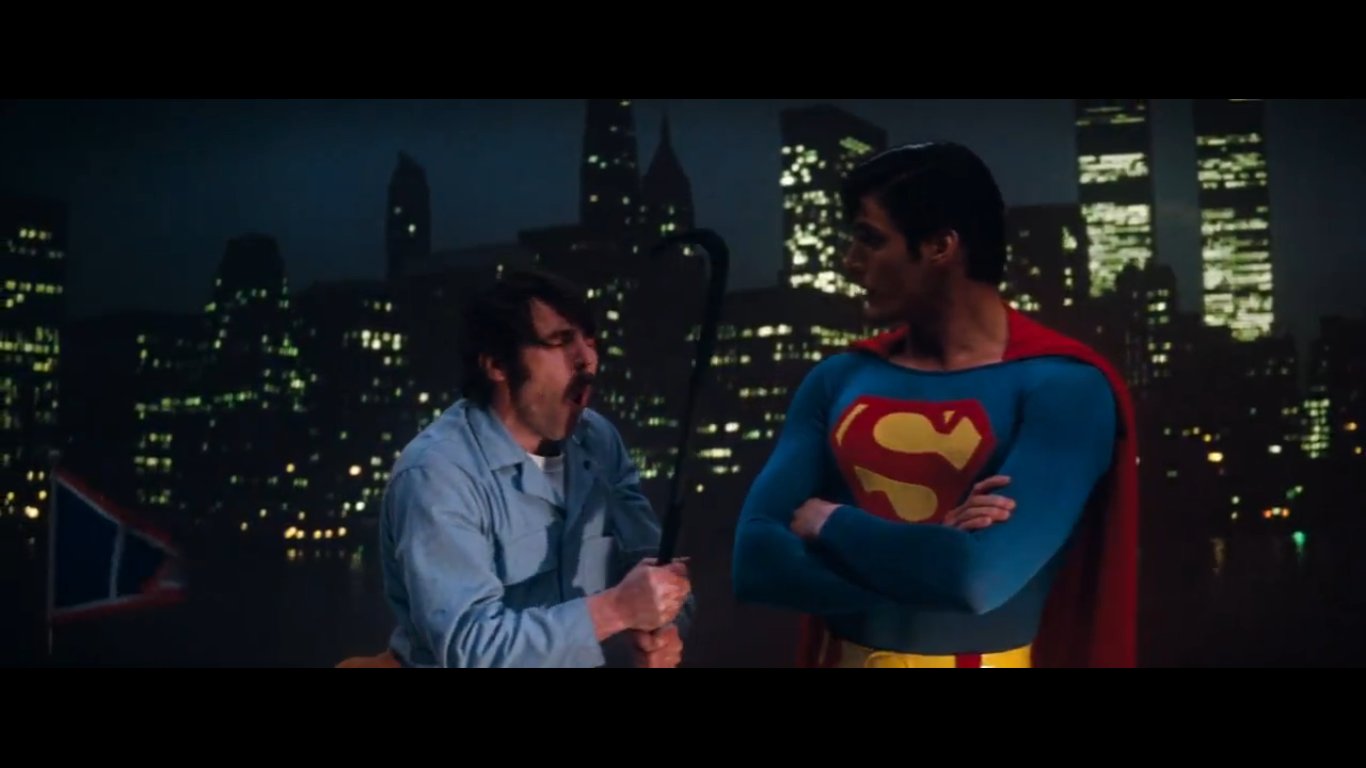
1:17:17 One of the reflections here is Richard Donner, who had a more prominent walk-on that didn't make it into the theatrical cut. Another example of cutting for rhythm.

1:18:29 John Williams contributed this neat slide guitar tune to complement Luthor's fake beach milieu.
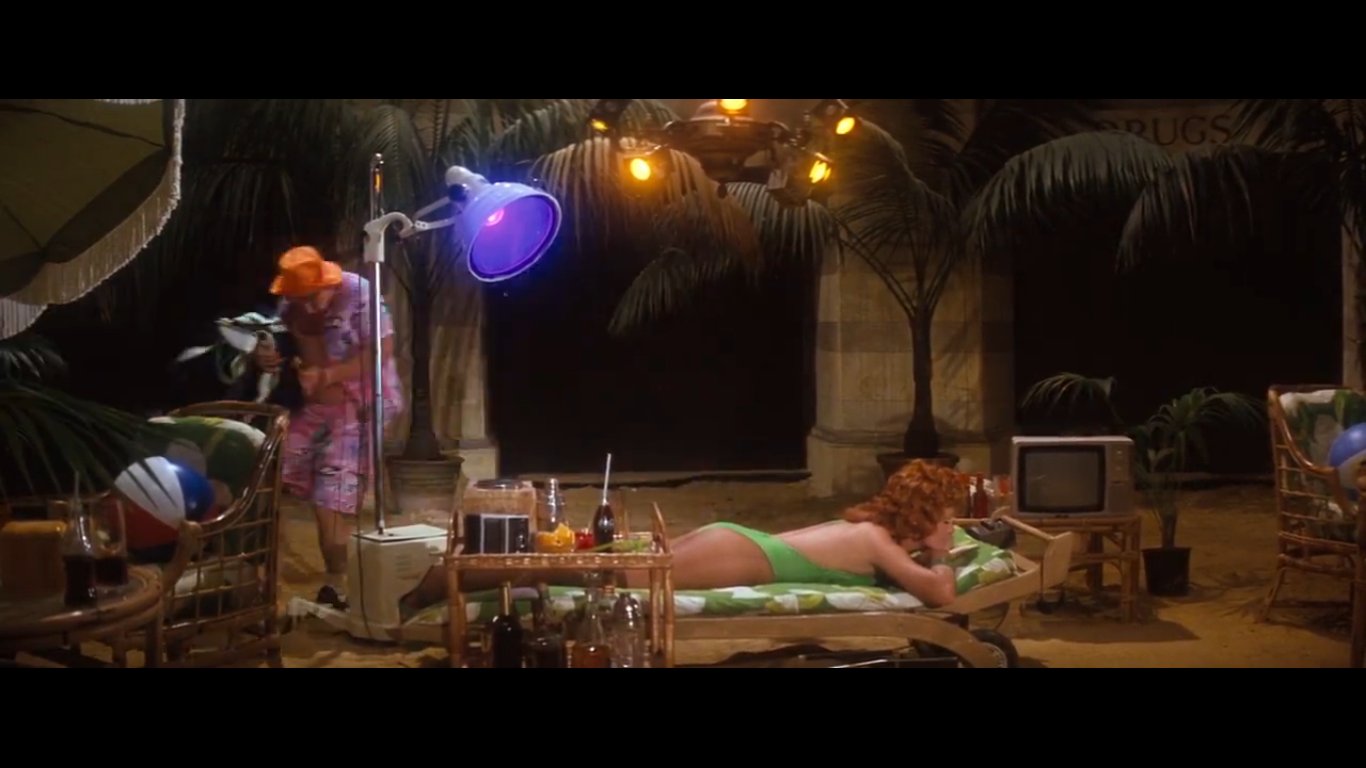
1:20:19 "...God talked to Moses." A nod to Superman's Old Testament origins? Maybe not. (The Christian symbolism in this movie is just a little too omnipresent.) That said, Jackie Cooper, a late replacement for Keenan Wynn, really digs into his small role as Perry White.
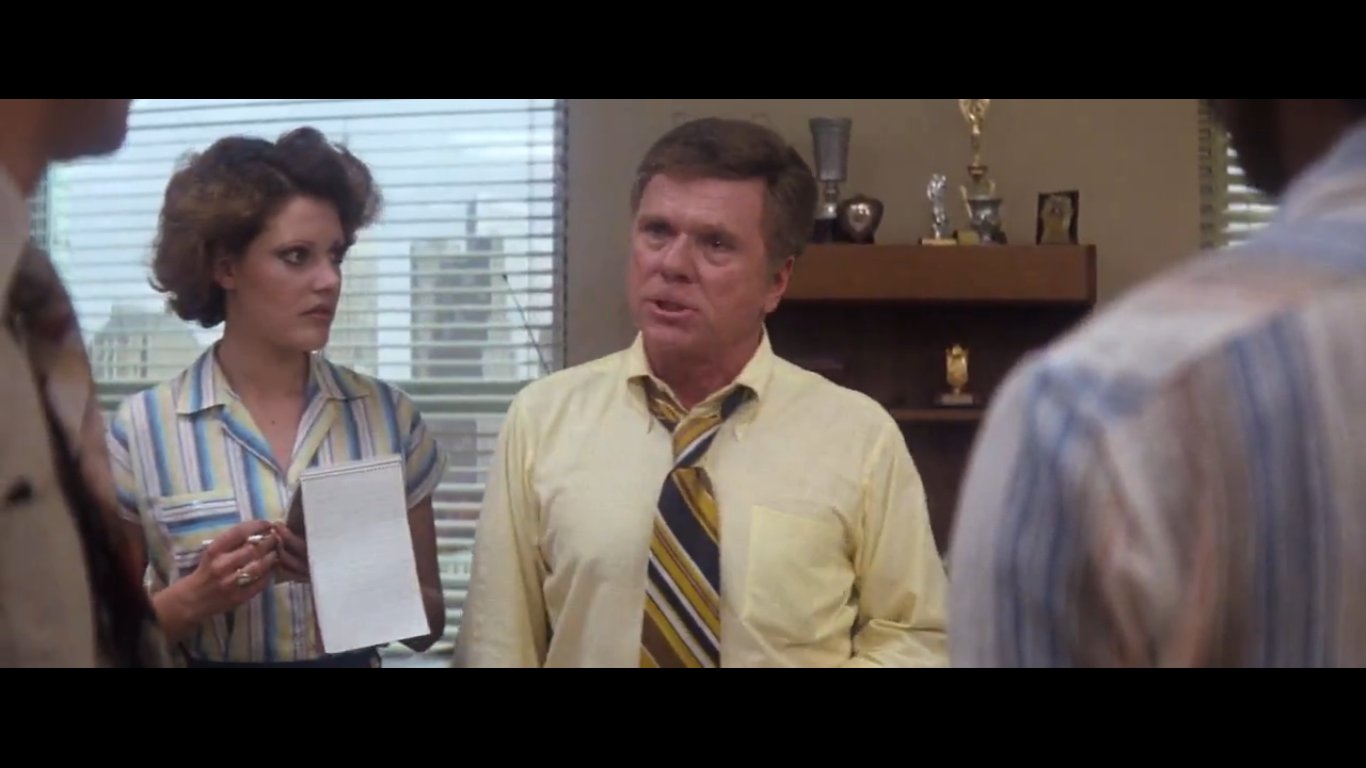
1:20:43 Margot Kidder said that she'd never felt more beautiful than when she was being lit by Geoffrey Unsworth. I believe it.
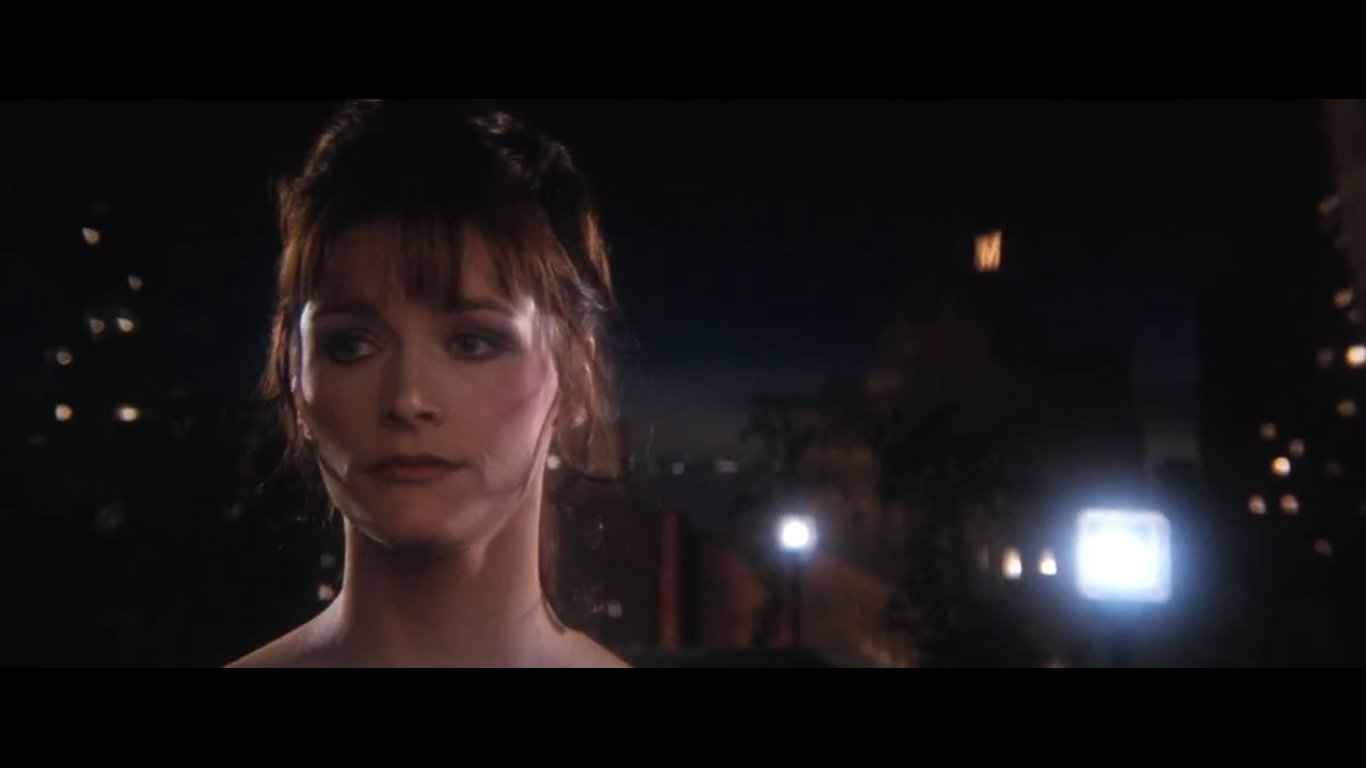
1:21:06 Christopher Reeve has an equal grace with the flying stunts and the earnestness of Superman's dialogue, both of which feature in this shot.
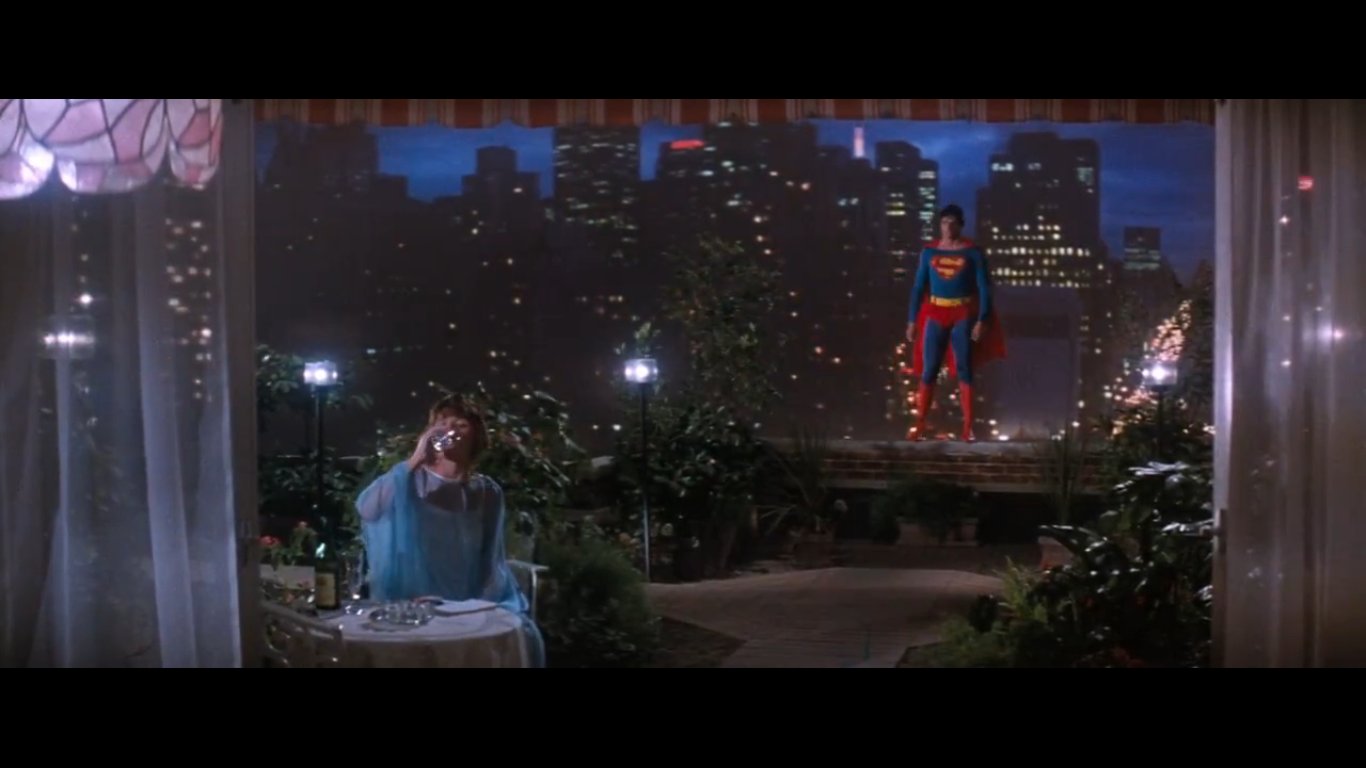
1:23:21 Another line this movie toes is how grown-up their flirtation should get. Seeing it through adult eyes, the point is coming across.

1:24:53 Lois Lane, handling first contact with the greatest of ease. All of Metropolis has pretty much rolled with everything so far.

1:25:21 Lois cracking up when Superman drops his famous "truth, justice, and the American way" line is exactly how you have fun with this material without making fun of it--understanding that Superman comes off a little silly, while still believing in his fundamental sincerity.

1:32:03 This is one of the most romantic, endlessly charming sequences in any movie. So much of it comes down to the believability of two performers who acted the whole thing out while strapped into complicated flight rigs that bit into their upper legs the whole time.
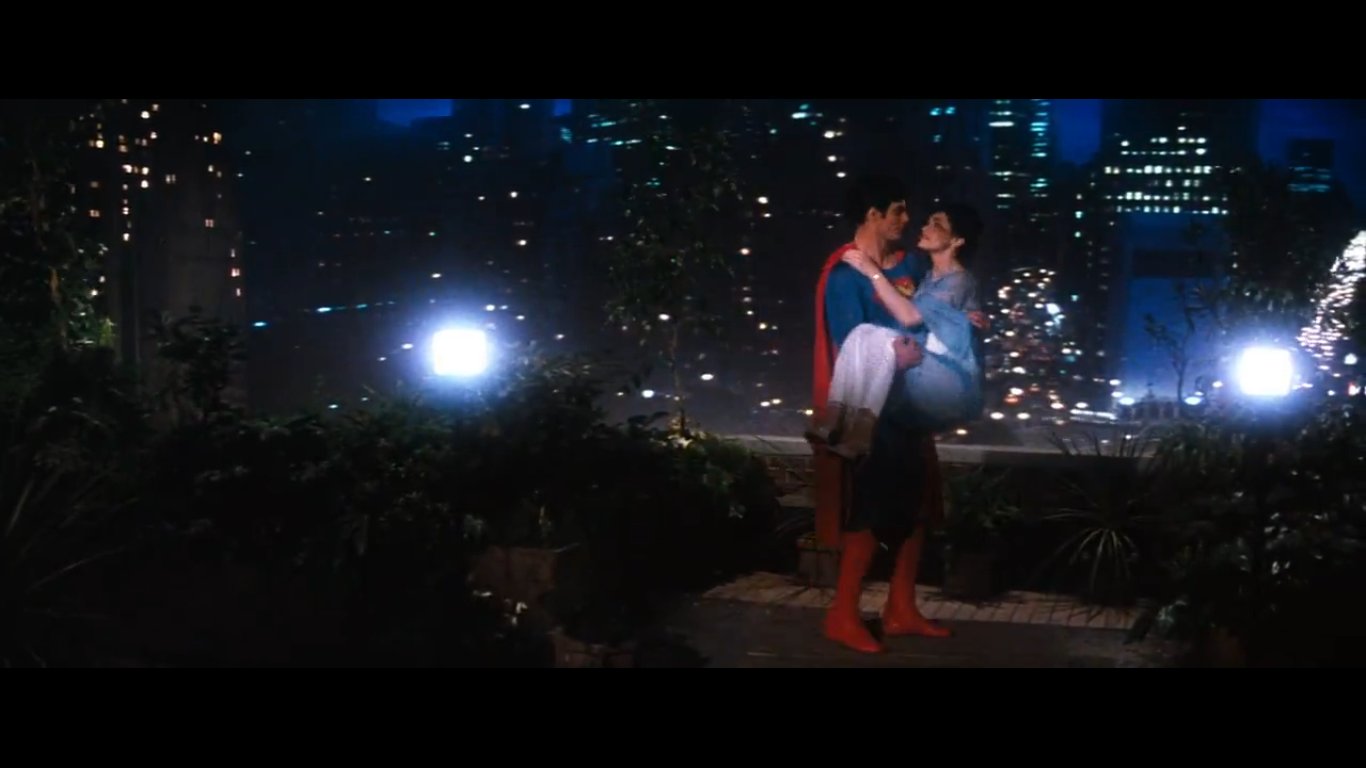
1:32:33 Buster Keaton would have called this an "impossible gag." Superman flies away. Then, without cutting--
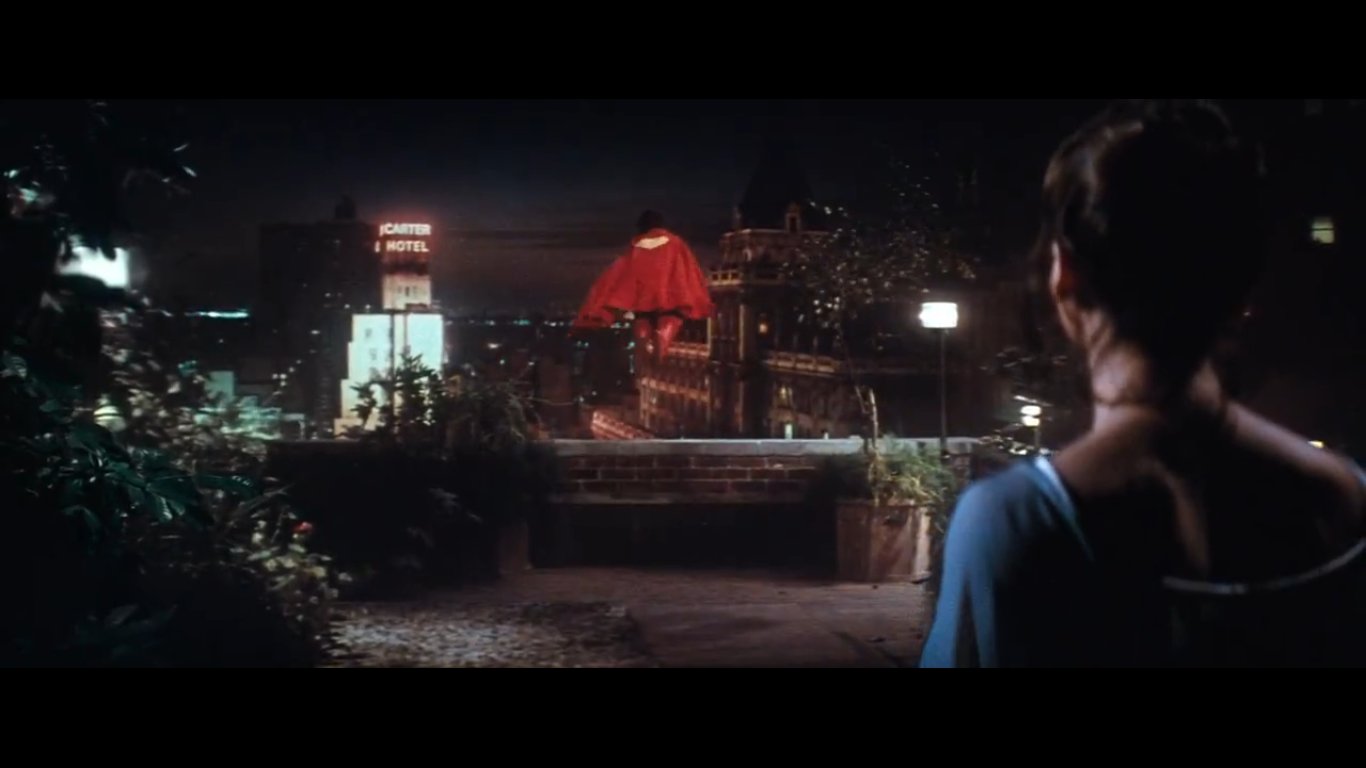
1:33:03 --Lois crosses over to the door of her apartment, where Clark is waiting for her. A grand illusion, decades before digital editing would have made it easy.
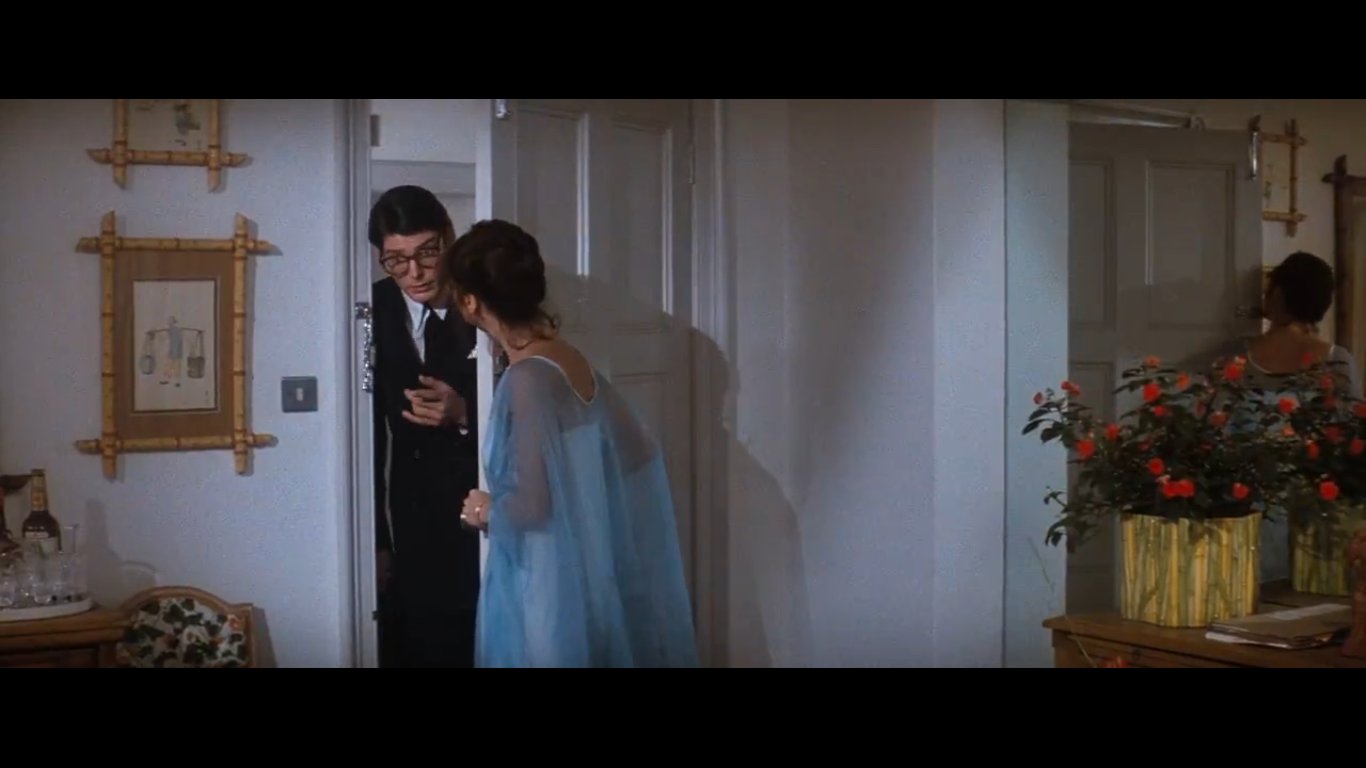
1:33:39 I won't belabor it, since it's a pretty famous one, but this shot is a demonstration of two things: the difference between Reeve's performance as Clark and as Superman, and how much the Clark Kent disguise is more than just a business suit and a pair of glasses.
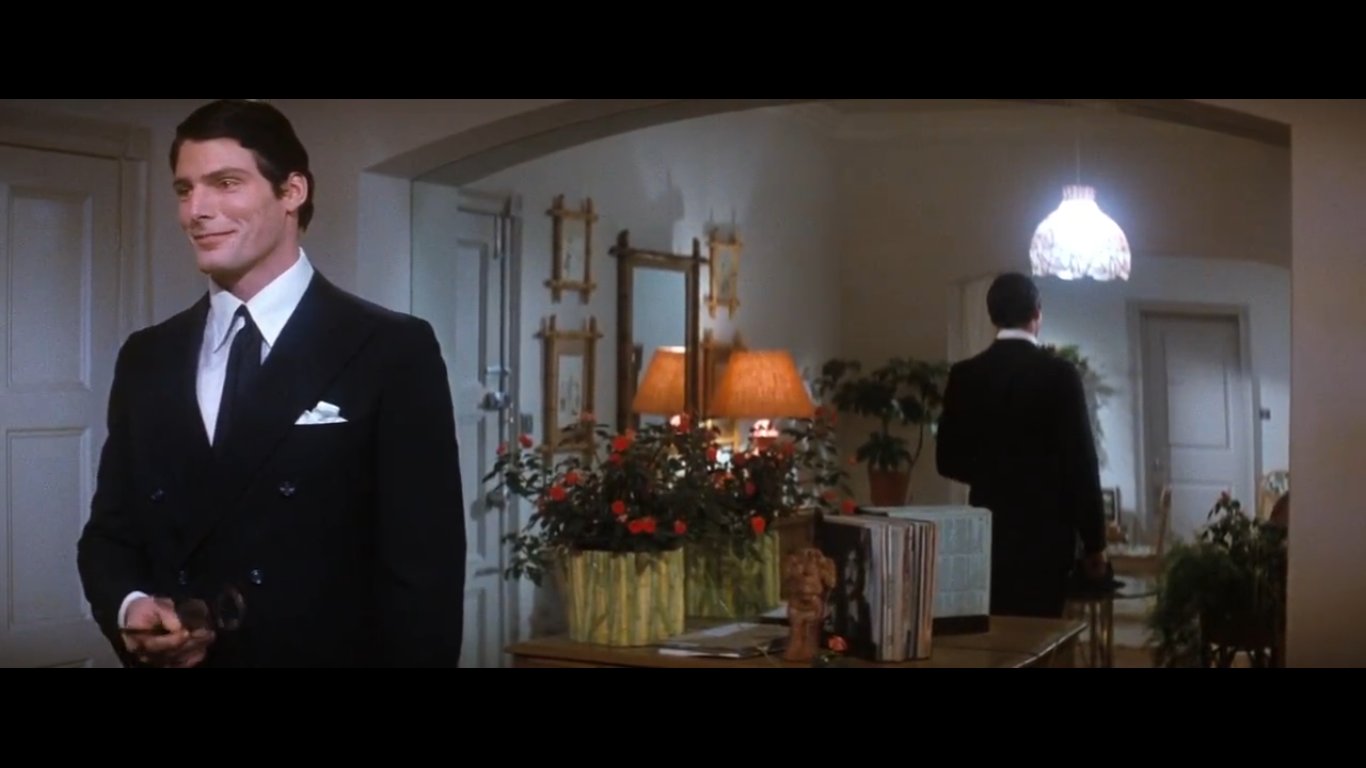
1:37:48 This movie can be terrifically funny, as when Miss Teschmacher slyly suggests a trip to Addis Ababa and Otis just... takes a moment.

1:38:25 The Guinness World Record for most consecutive car flips on film is held by Casino Royale (Campbell, 2006), at seven.

1:39:57 Ambulance services were rapidly expanding in the 1970s, and many TV shows and movies at the time featured ambulances as a way of normalizing them for skeptical Americans. The ambulance dramedy Mother, Juggs, & Speed (Yates, 1976) was also scripted by Tom Mankiewicz.

1:42:50 Marc McClure has something of a thankless role in this movie. Despite his prominence in the comics, Jimmy Olsen's part here is equivalent to a damsel in distress. McClure has brought his reliable everyman quality to many movies, including smaller roles such as this.
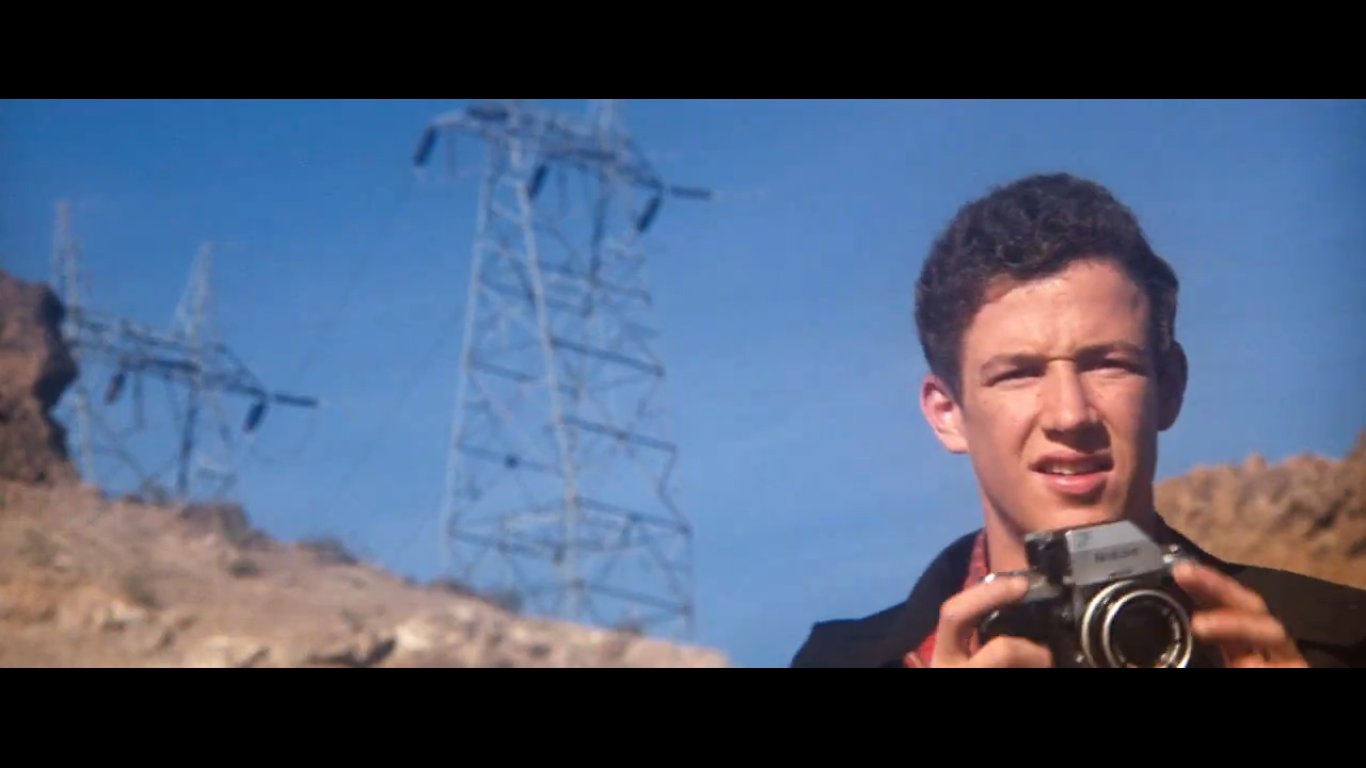
1:43:13 This actor is Chief Tug Smith, who appeared in a handful of roles as American Indian characters during this time. Little seems to be known about him except that he passed away in Tulsa, Oklahoma, which might be an indication that he was a member of the Osage Nation.
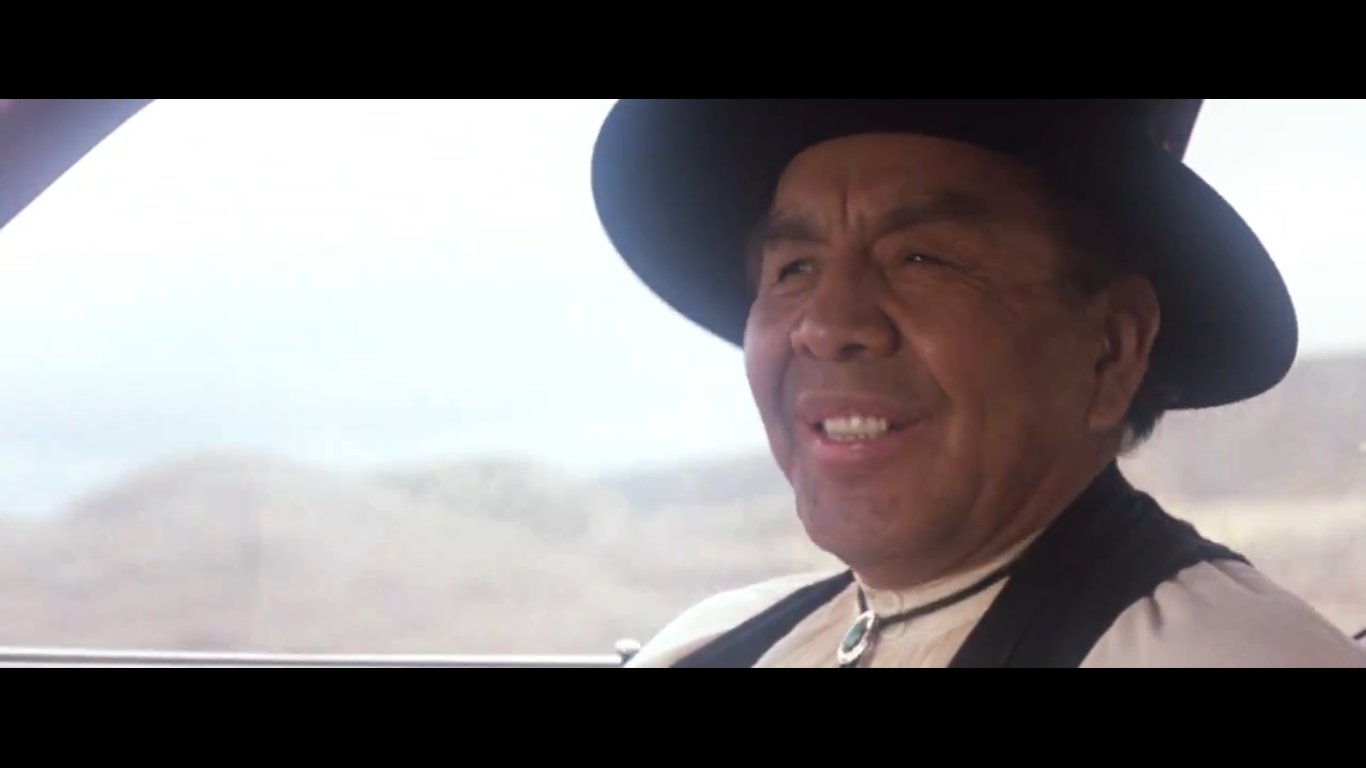
1:44:02 The implication of this dialogue and the preceding scene isn't just that "some unidentified clown out there is buying up thousands of acres of worthless desert at incredible prices." It's that indigenous people are the ones selling the land--an issue with lots to unpack.

Indigenous people struggle to re-establish control over colonized land that historically belongs to them. (As with the ongoing Land Back campaign.) The plot point of selling land by the thousands of acres is not impossible, but the movie is frustratingly indifferent as to why.
1:44:24 Oddly enough, Clark seems to be wearing prescription lenses in this shot.
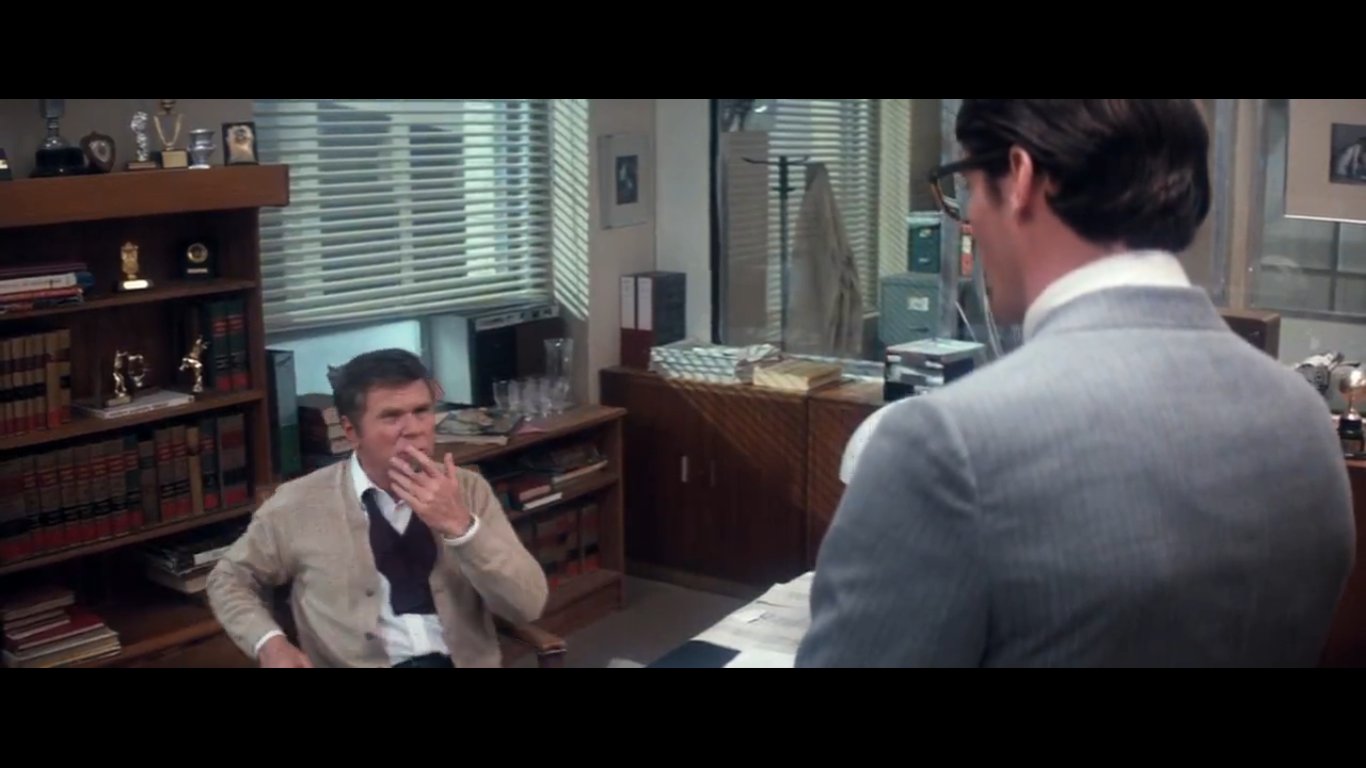
1:44:47 These cutaways to barking dogs are interesting from an editing standpoint--a montage in which otherwise unrelated shots are joined by the sole throughline of Luthor's supersonic alarm.
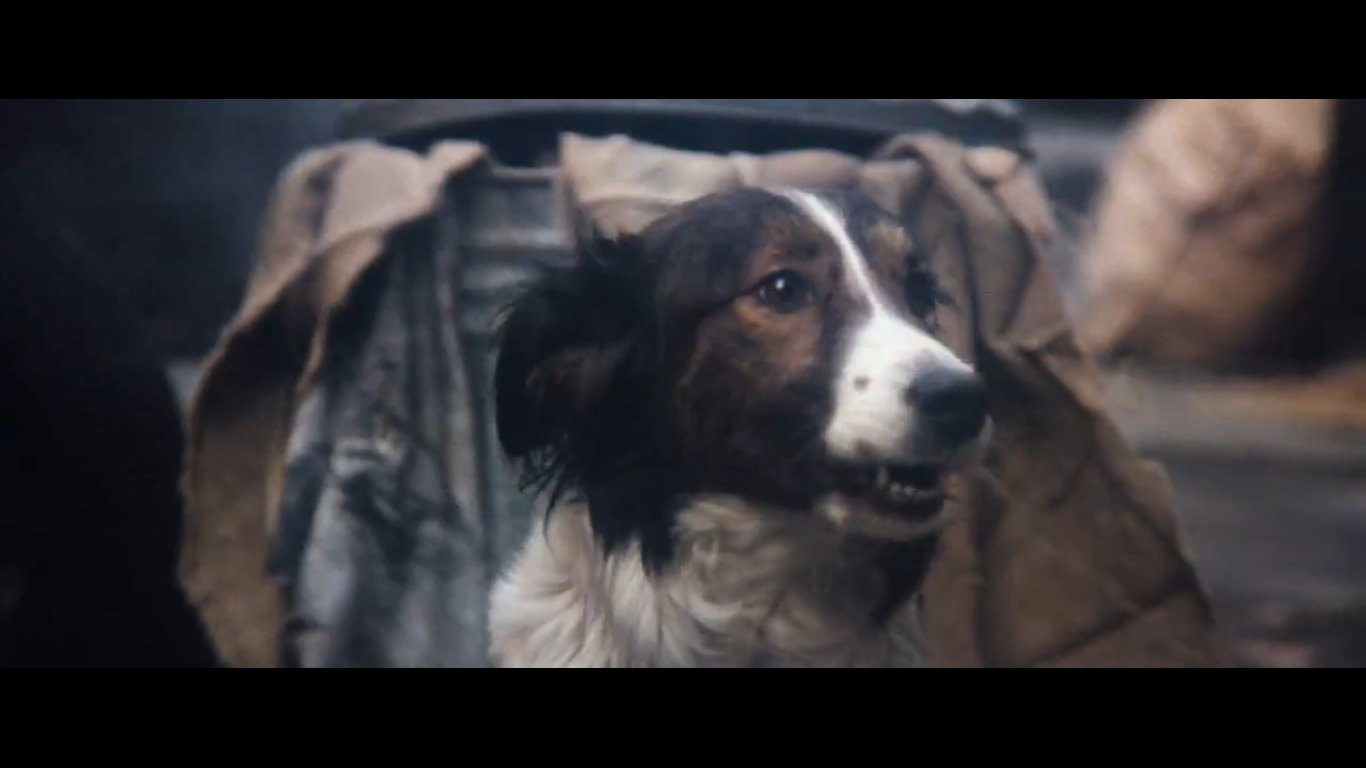
1:45:06 A few minutes of looking up "propane lithium compound" on the web turned up nothing about poison gas. Hooray, meaningless technobabble.
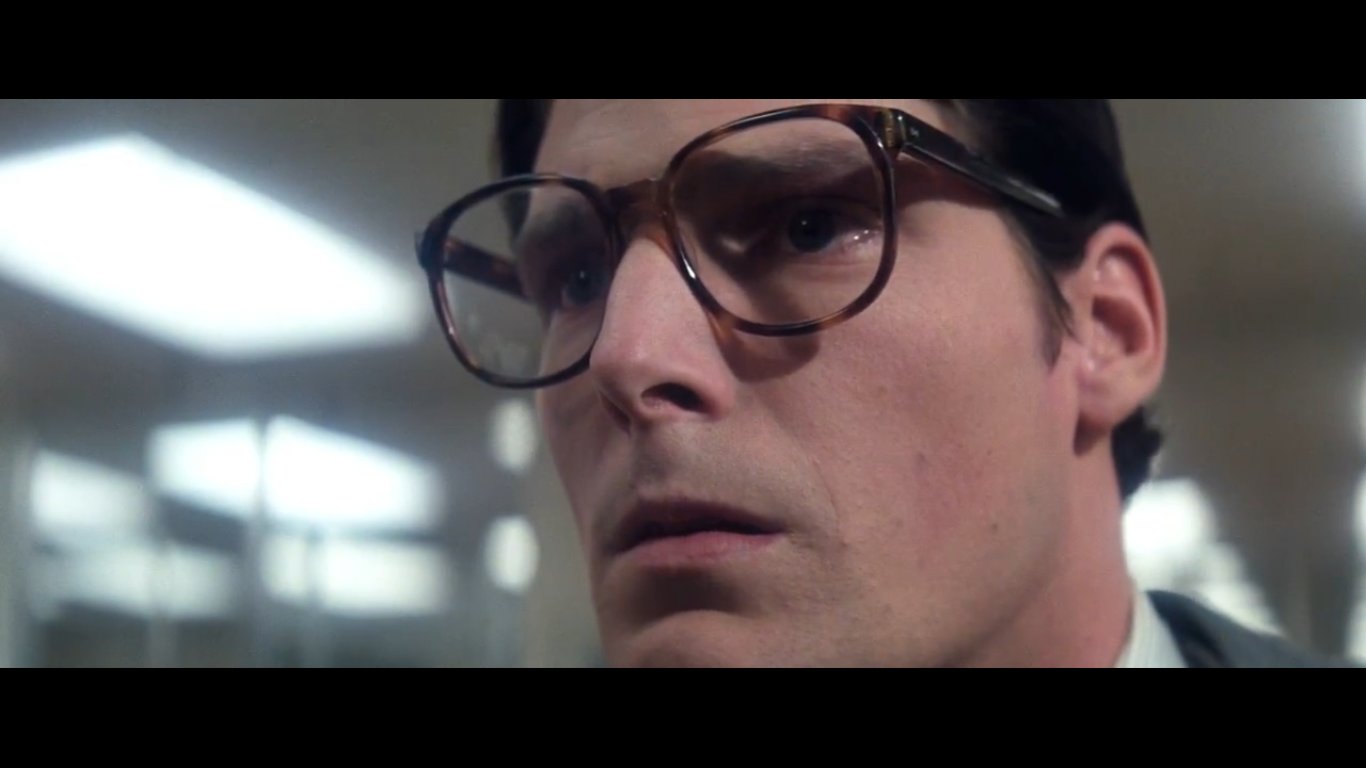
1:45:54 The logical explanation for this is that he's changing at superspeed, which would mean he's raining clothes upon the city.
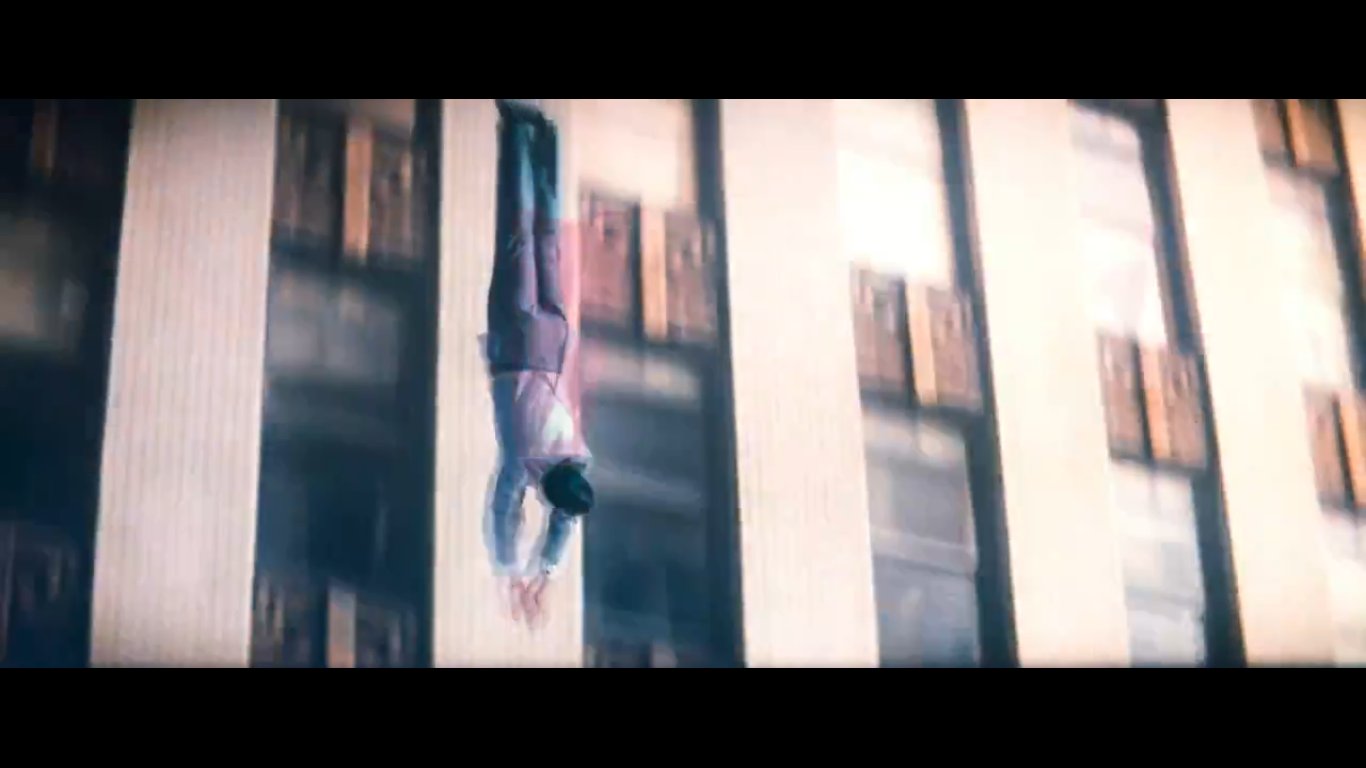
1:46:16 These shots of Superman buzzing by cars and buildings with people gawping at him and cheering him on are (to beat a dead horse) effective worldbuilding, establishing Metropolis as a place where regular people live, for whom a flying man is still a rare and uncanny sight.

1:47:10 There was originally a much longer sequence here, of Superman plodding his way through various security measures on his underground journey to Luthor's lair. The shots that remain were cleverly repurposed and reordered; you would never know they removed a whole scene.

1:48:10 Some Ozymandias "I did it 35 minutes ago" energy here-- Superman is preoccupied with learning the details of Luthor's plot, not knowing that the missiles are already in the air. It's not out of the question that this movie may have been an influence on Moore and Gibbons.

(Adrian may have done it "35 minutes ago," but Rorschach did it hours ago. There is no evil plan airtight enough to account for human behavior in all its chaos and unpredictability, as I discuss in this piece.
1:48:49 The contempt dripping from Superman's voice when he talks to Luthor makes me wonder: does he already know who Lex Luthor is? We know the cops are after him, but how much notoriety does Luthor already have in this world? Or is Superman just mad about the fake poison gas?

1:50:35 With a 007 alum writing the shooting script, it's unsurprising that Luthor is reminiscent of a Bond villain here--welcoming, cordial, all while describing the monstrous things he's done or intends to do. In fact, Luthor's plan isn't unlike that of Goldfinger's.
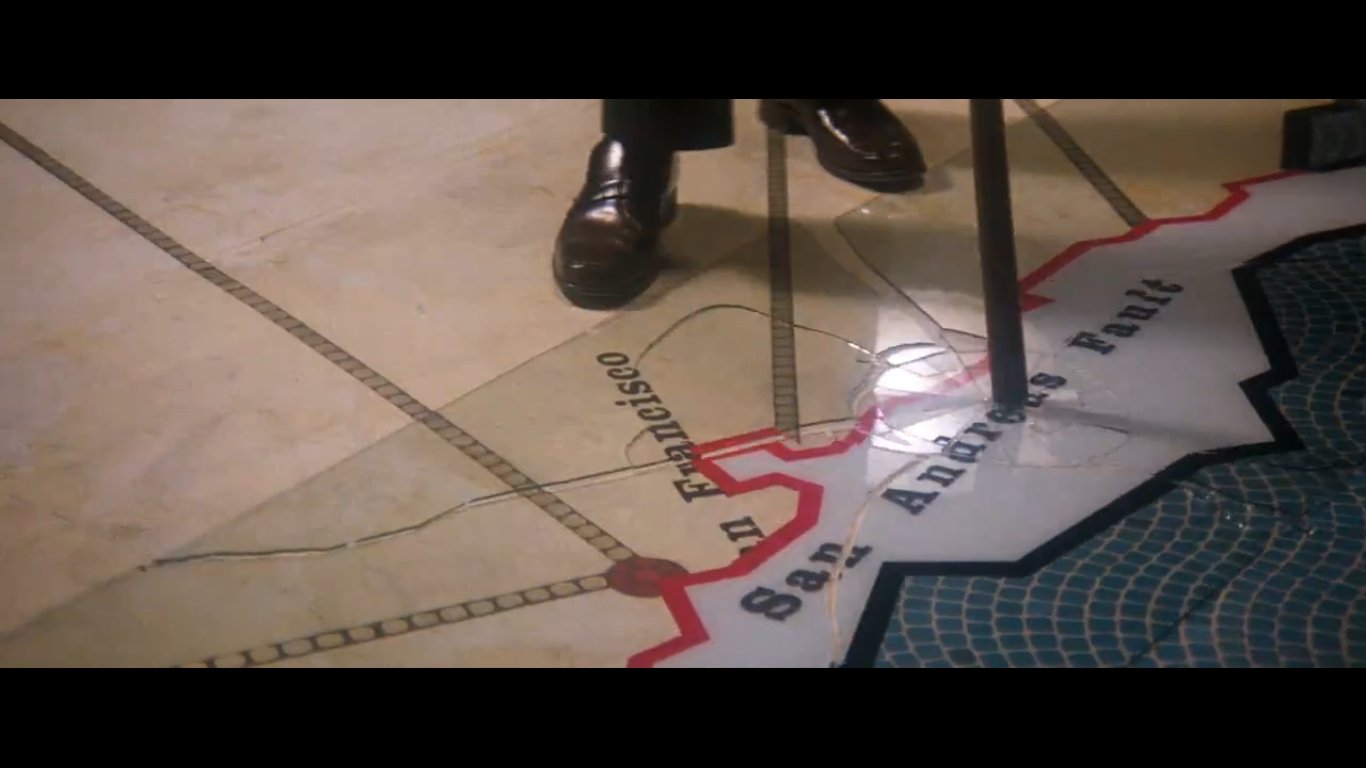
1:51:08 This actor in the foreground is John Ratzenberger, otherwise known as Cliff Clavin from TV's Cheers, Hamm from the Toy Story movies, and assorted roles in most other Pixar movies. Ratzenberger also appears as a NASA flight controller in SUPERMAN II (Lester, 1980).
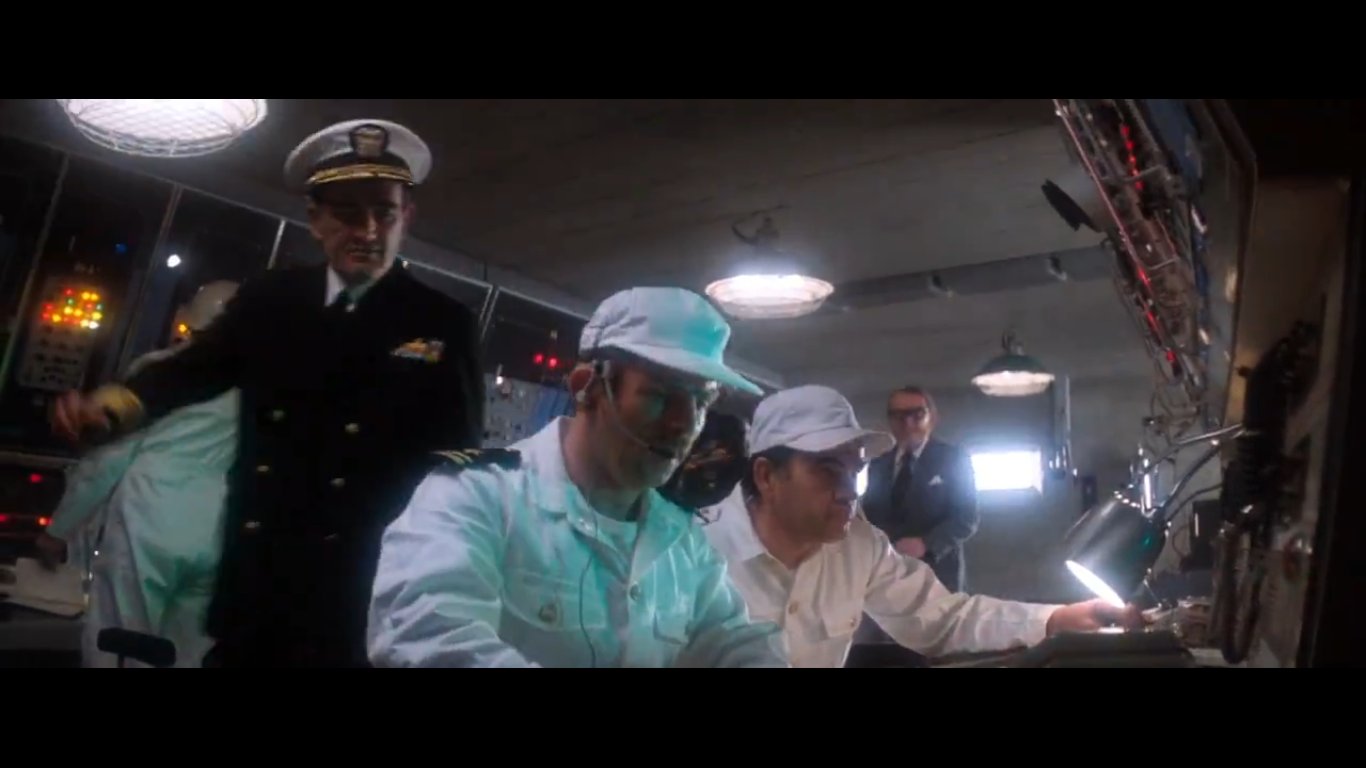
Ratzenberger also has a small role in The Empire Strikes Back (Kershner, 1980) as one of the rebel soldiers at Echo Base. Speaking strictly in terms of the money made by movies he's appeared in, Ratzenberger is technically one of the most bankable actors of all time.
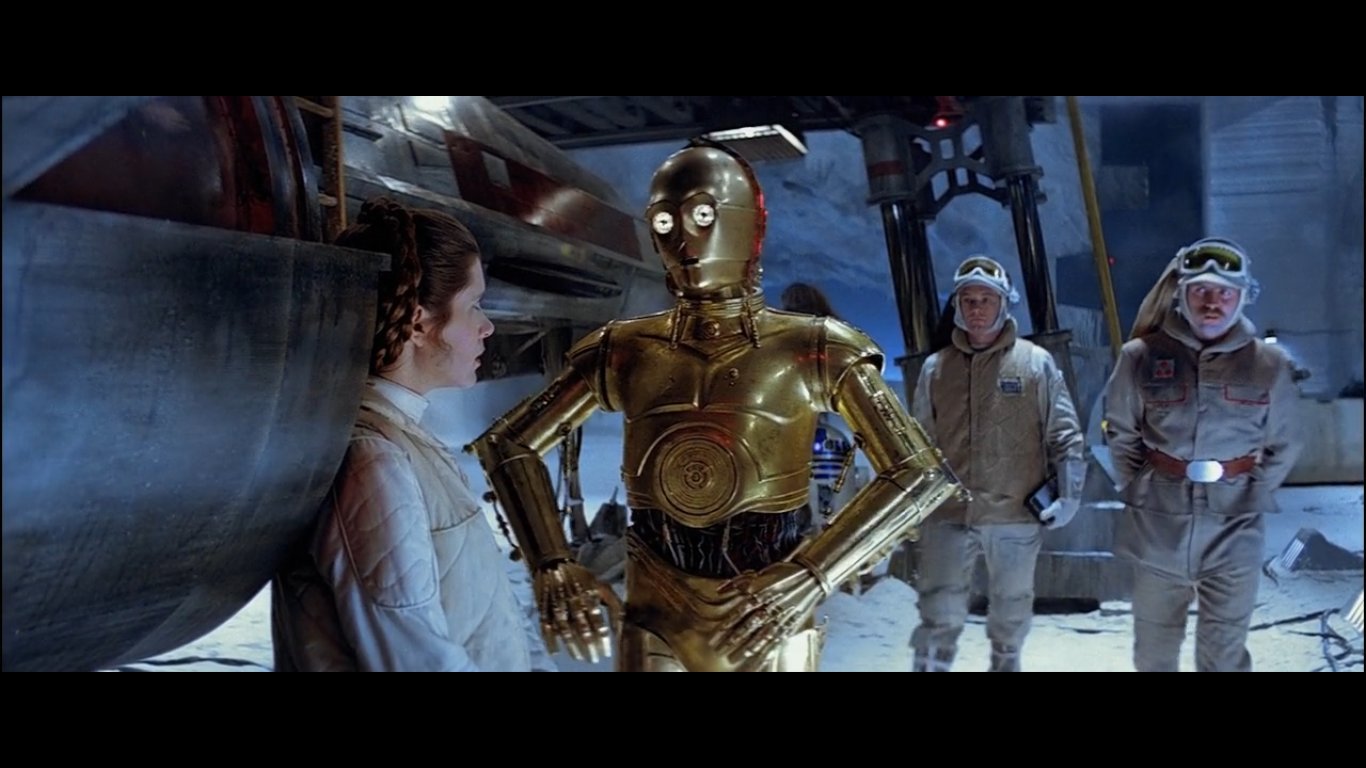
1:51:25 "They have the new B-20 low-level avoidance systems." Judging by a cursory web search, more technobabble. (The first result to appear is from this movie.) Additionally, it's silly enough that these missiles are armed, sillier yet that they've made them impossible to stop.
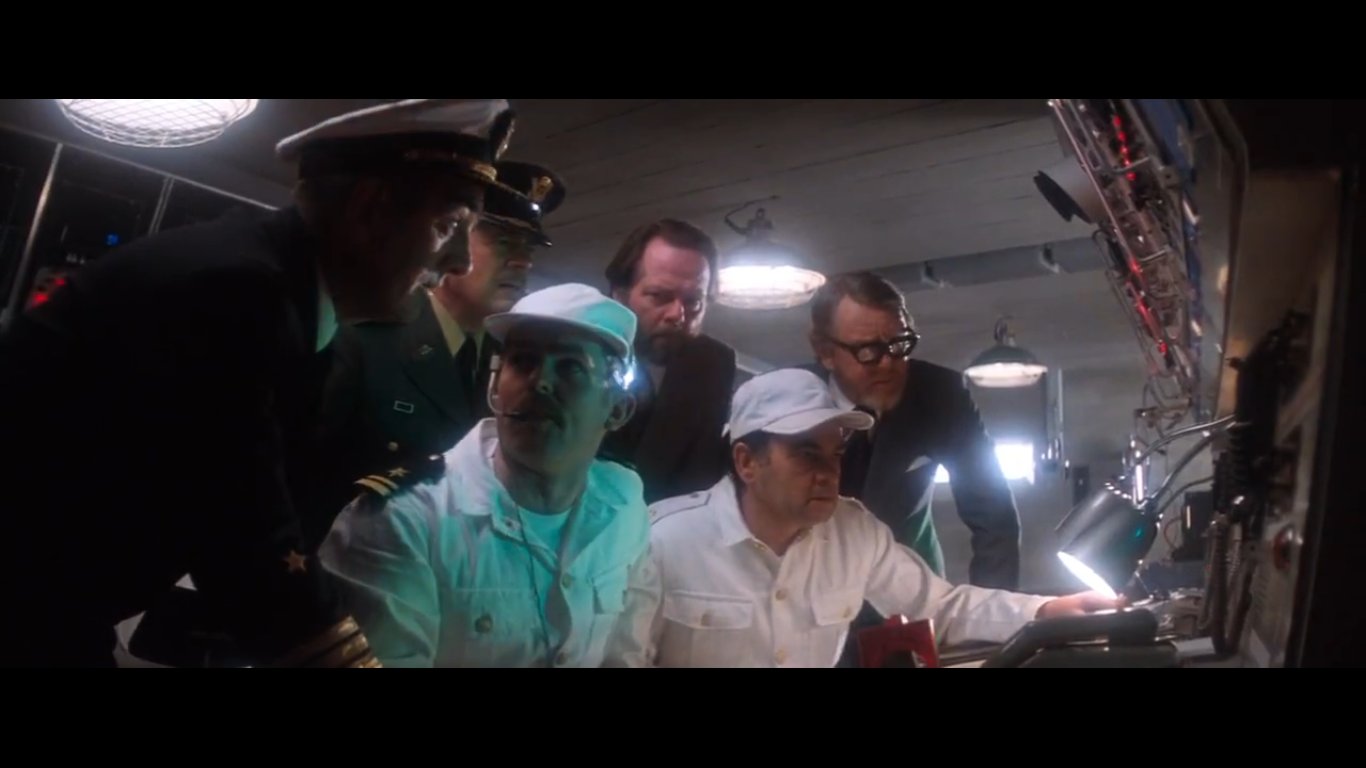
1:51:51 Here's Luthor's "I did it 35 minutes ago" moment. Would that we all paid as close attention as the greatest living Briton.
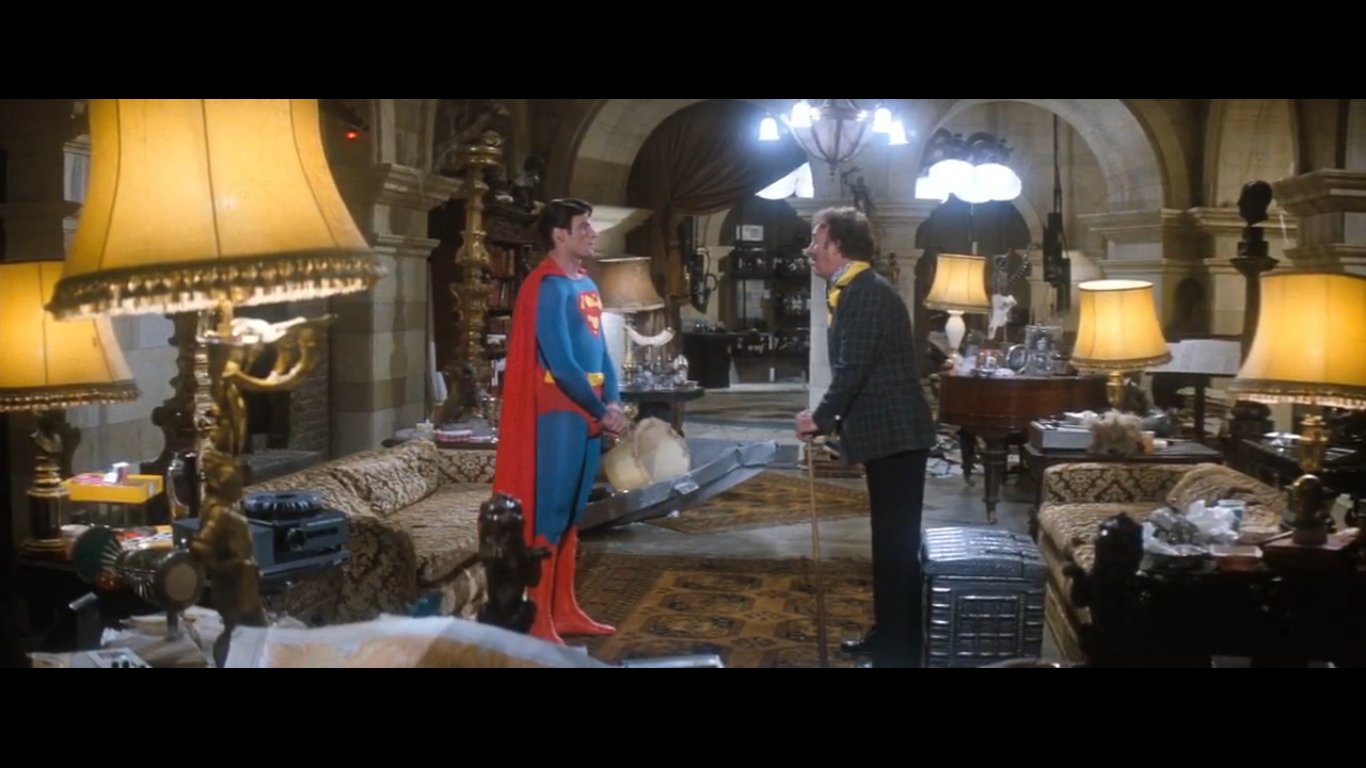
1:54:10 More Bond villainy, leaving the hero to die instead of sticking around to make sure. Notice how the frame highlights Miss Teschmacher.

1:54:50 Kryptonite is an ingenious plot device. It debuted in the 1940s radio serial as a means of incapacitating Superman so that his voice actor, the excellent Bud Collyer, could take some time off. Here, it gives the movie a budget-friendly way of making Superman beatable.
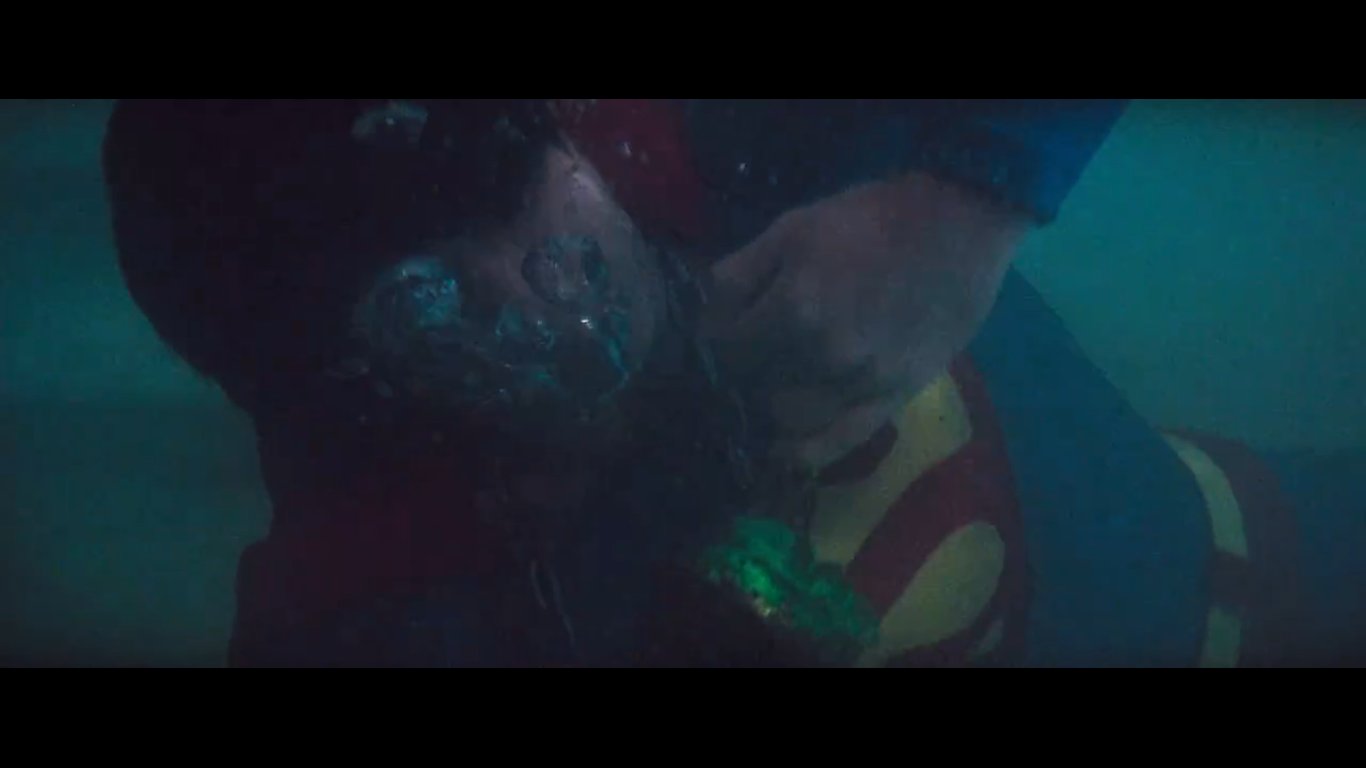
1:55:52 I always thought this was a clever touch. It's not out of the question that Superman would name Lois and Jimmy, but it seems more like Superman is blurting out the names of Clark's friends. It's unclear exactly what kryptonite does to him, but he seems delirious here.
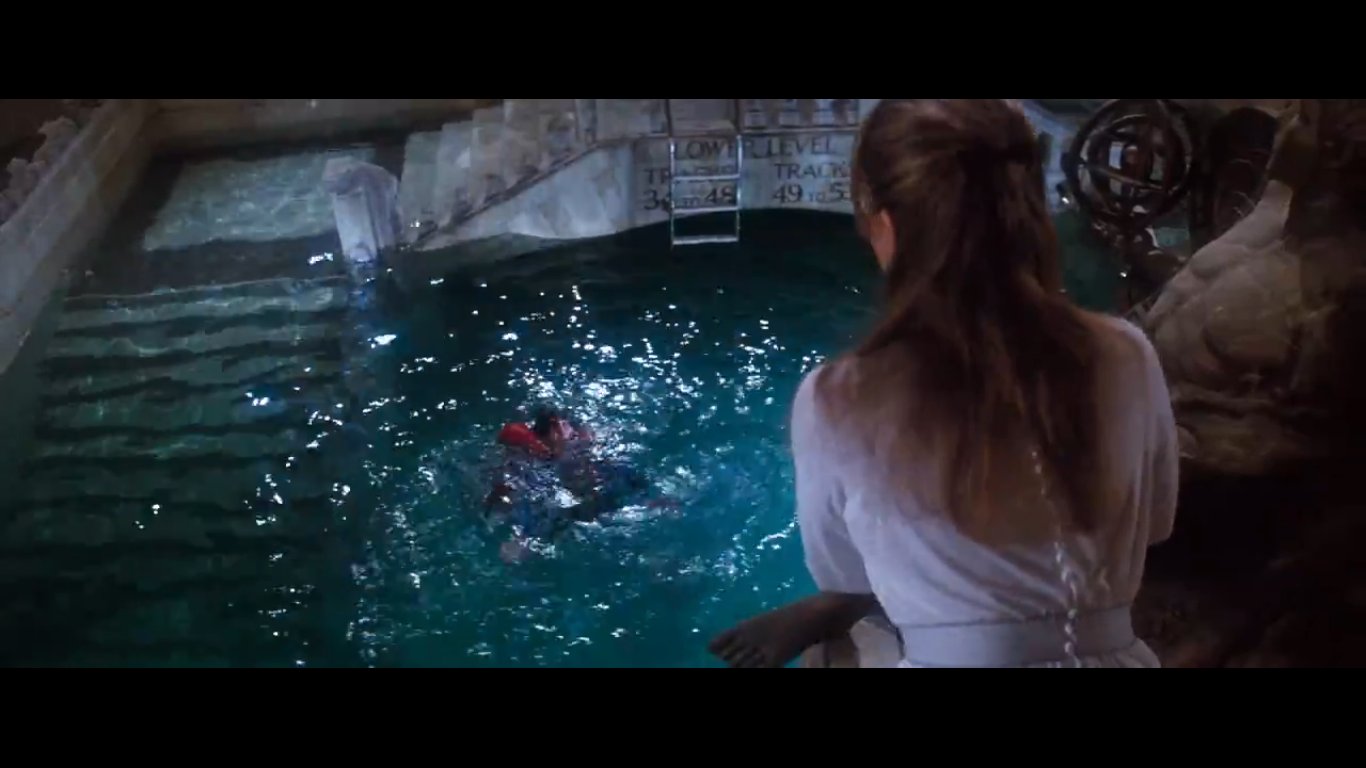
1:56:15 The implications of Miss Teschmacher's choice in this scene are discussed in the essay "The Marvelous Miss Teschmacher."
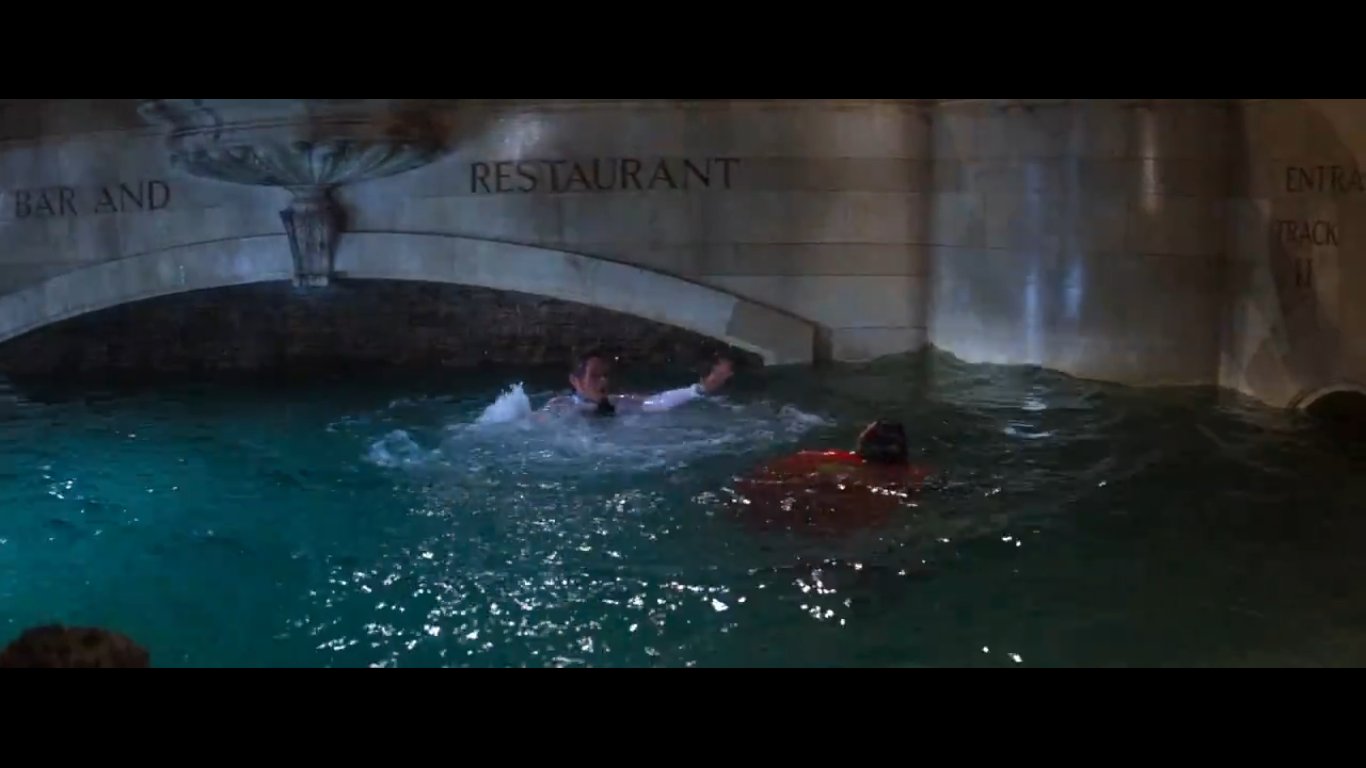
1:56:50 And thus, there's at least one unaccounted-for piece of kryptonite on Earth.
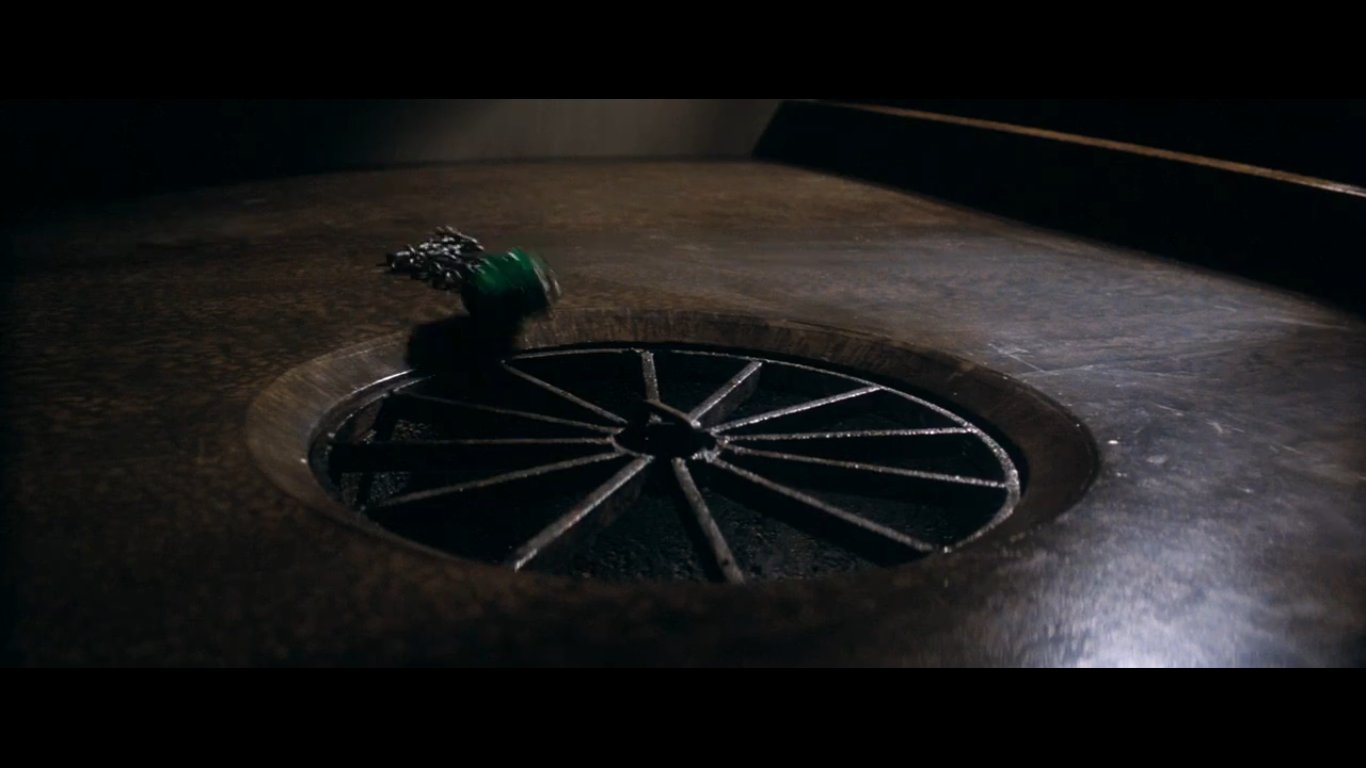
1:57:19 Superman tells Miss Teschmacher to get out of Dodge before Luthor figures out that she interfered with his plan. She doesn't appear in the movie again, so we can assume she made good her escape. (There was one more scene with her, deleted, that won't be missed.)

1:58:16 The combining of the shots in this sequence isn't airtight, but--as I argue in the special effects essay "Zoptical Illusions"--it might be better that they leave some work to the audience's imagination.

1:59:10 This is the last we're going to see of Luthor for a while. Who knows what he'll get up to as the following sequences play out? Does he sit around stewing in his lair? Does he try to get away? It's fun to think about--the unseen parallel thread of Luthor's downfall.

1:59:21 "15 seconds to impact. 15 seconds and counting." We'll see.
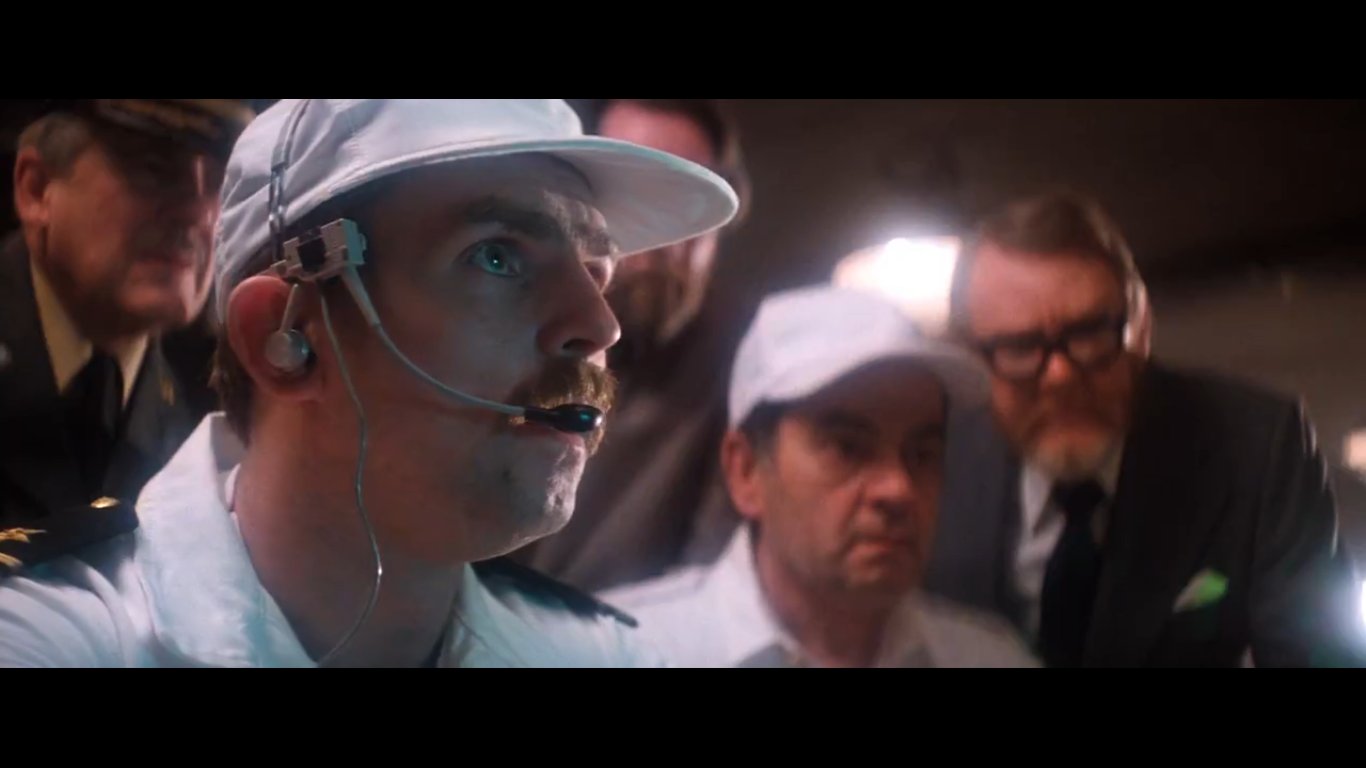
1:59:30 Lois is listening to "Give a Little Bit" by Supertramp, which was a hit in 1977.

1:59:38 17 seconds. Close enough!

2:00:01 This quaking gas station brings us into the "disaster movie" segment.
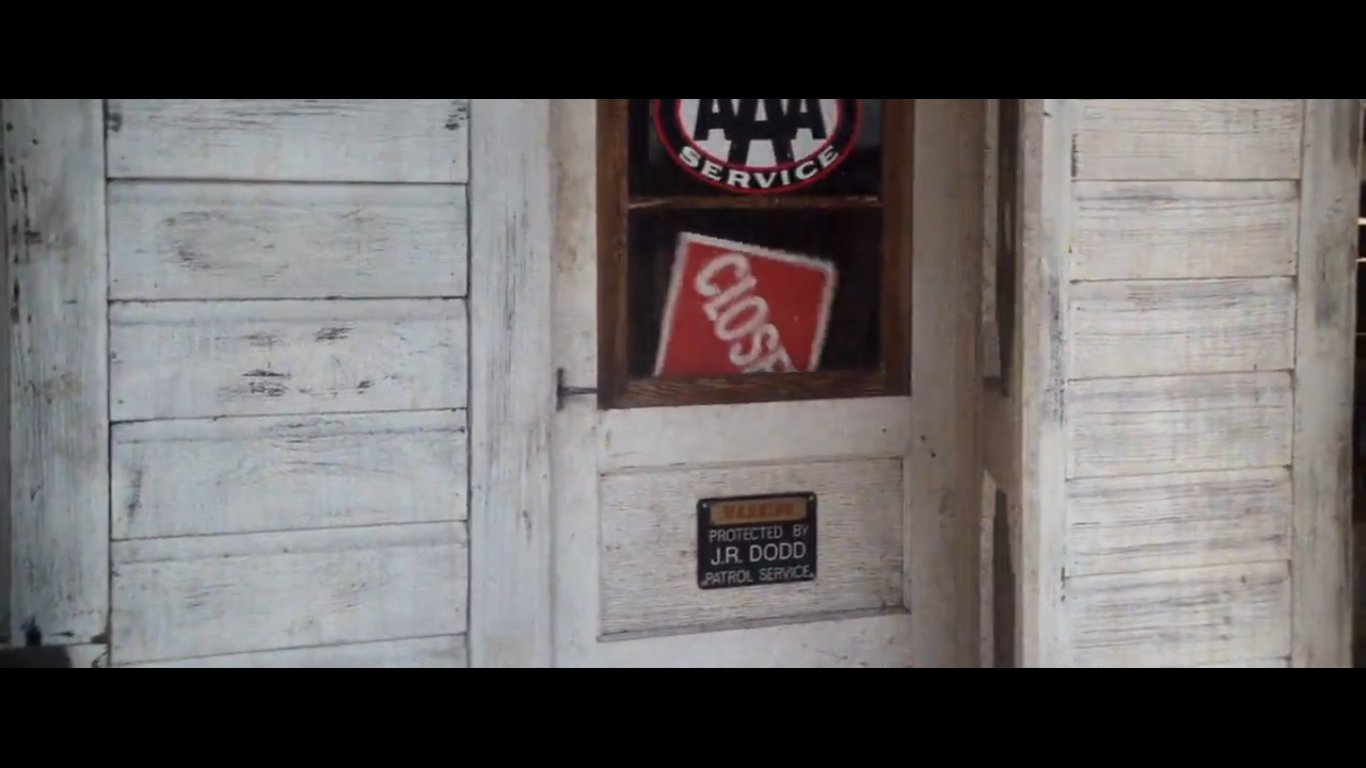
2:02:09 World-threatening peril is common in superhero stories, but too many of them forget about regular people. The better superhero stories tend to be the ones that put ordinary humans into the middle of things. It's more relatable, and it gives the hero people to rescue.
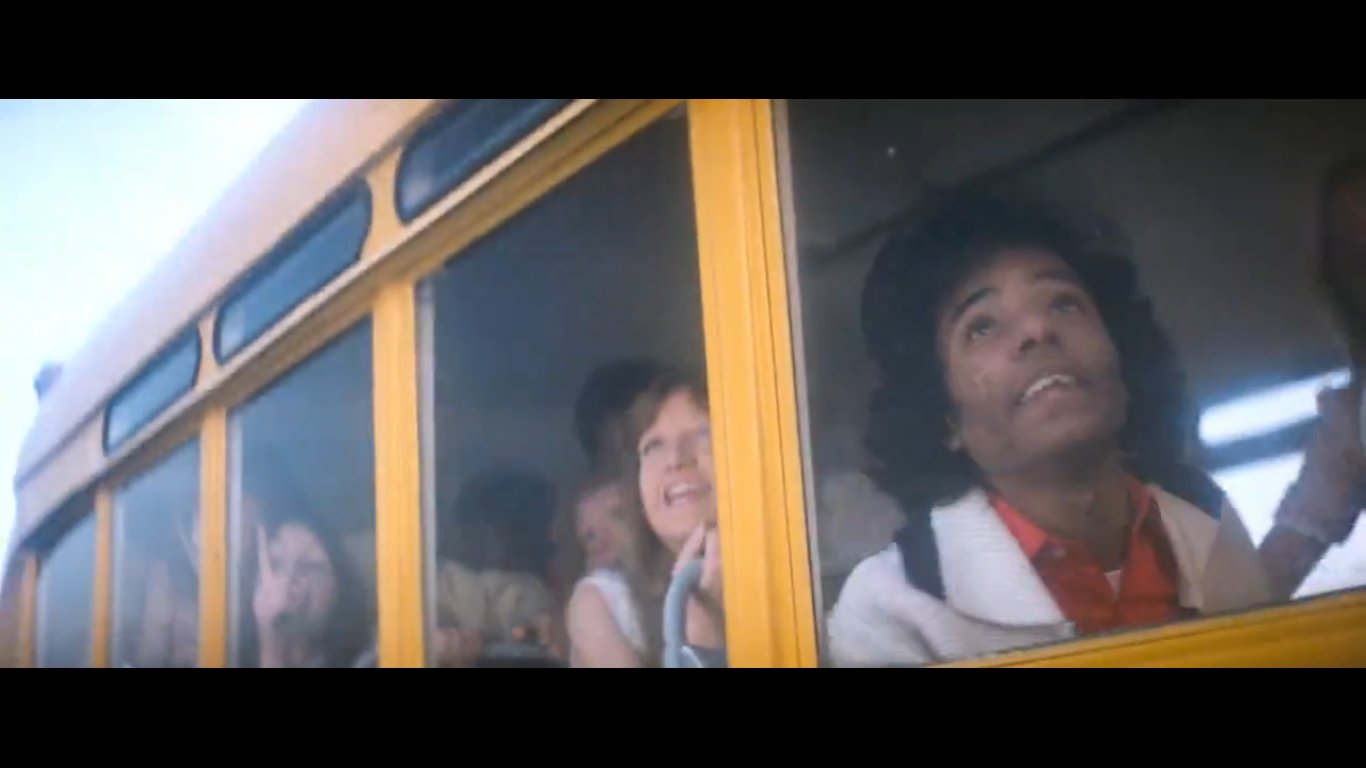
2:02:50 "Overcrank" refers to shooting footage at a faster rate than usual, so that it appears in slow motion when played back at the customary 24 frames per second. Overcrank is essential when shooting miniatures. It creates a sense of scale, especially when water is involved.
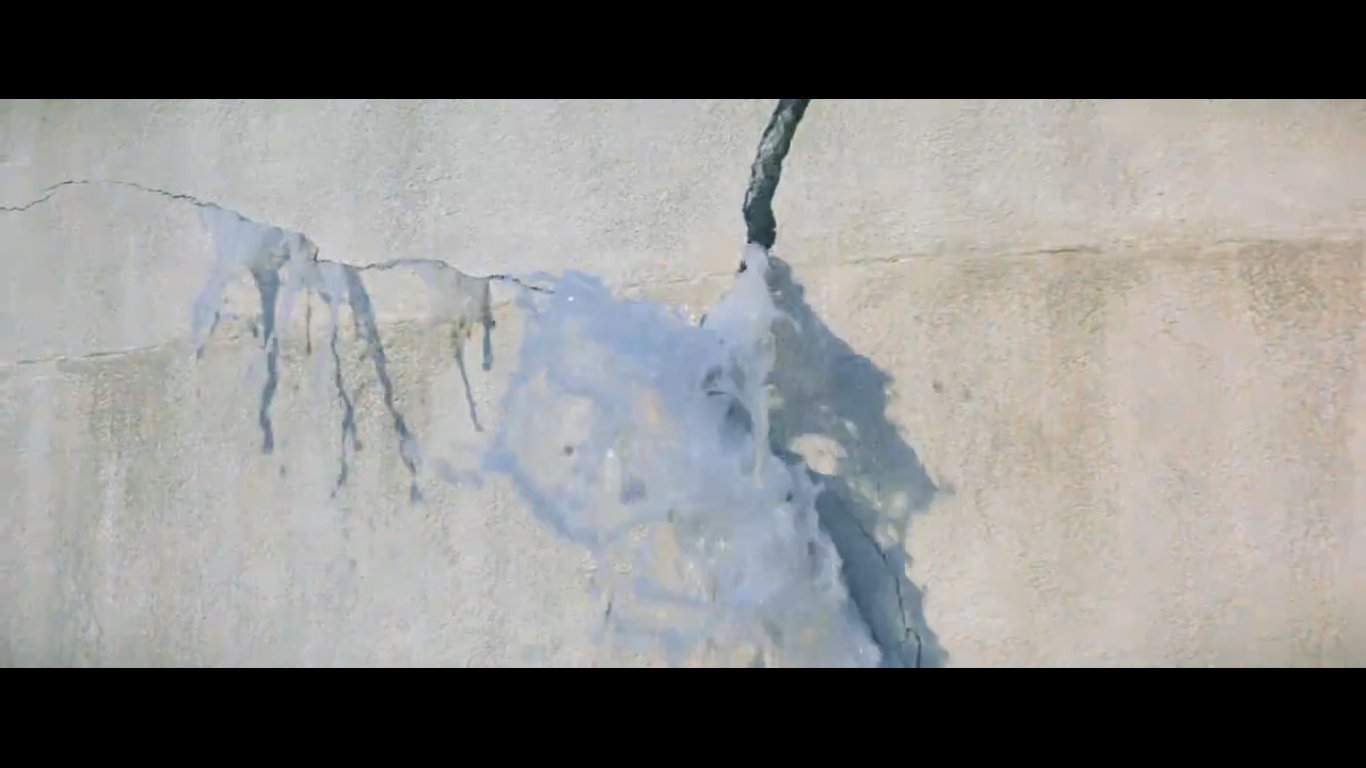
2:02:58 Jimmy has it in him to be a great journalist. Instead of running, he takes pictures from the best seat in the house as the dam breaks under his feet.

Then again, this is him coming into his own as the movie's damsel in distress. (Sorry, Lois. You've been usurped.)
2:03:06 Jimmy's lines for the next minute or so will be restricted to "AAGH," "EUUGH," "UNFH," and variations of the same. Lucky for him, Superman can hear those noises particularly well.
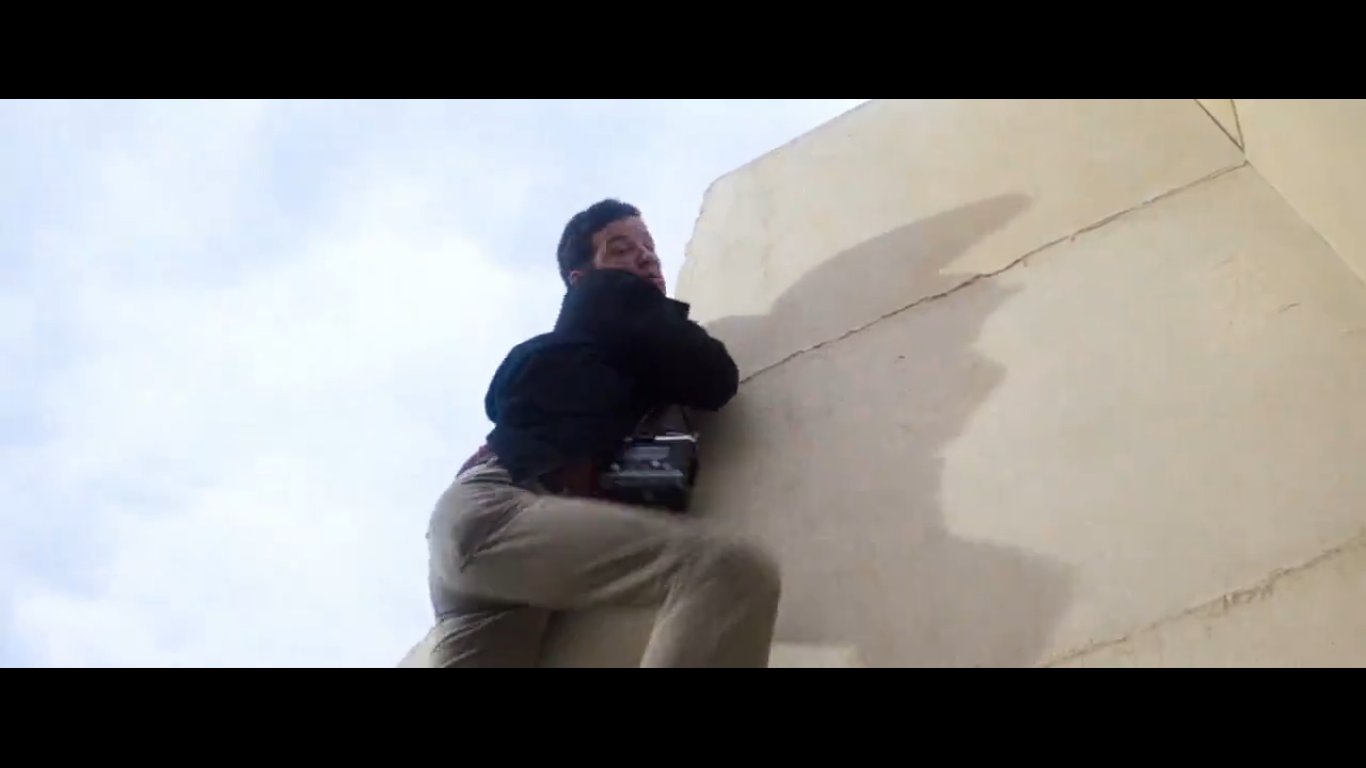
With Lois running out of gas, she may yet take the title back from Jimmy!
Bear in mind that the timeline is diverging here. Or, alternatively, this is being erased from the timeline and rewritten--it all depends on how you take your time travel. Either way, when Superman goes back in time, he arrives before this. Try not to think about it too hard.
2:06:47 Margot Kidder's stunt here, which she performed herself, entailed getting into the car (which was pre-crushed and inserted into the hole in the ground) and getting fake dirt and rocks dumped over her, which was probably pretty unpleasant and at least a little dangerous.

2:07:03 Some of these shots contain less than stellar miniature work. Fortunately, they pass quickly, and most of this sequence plays well.
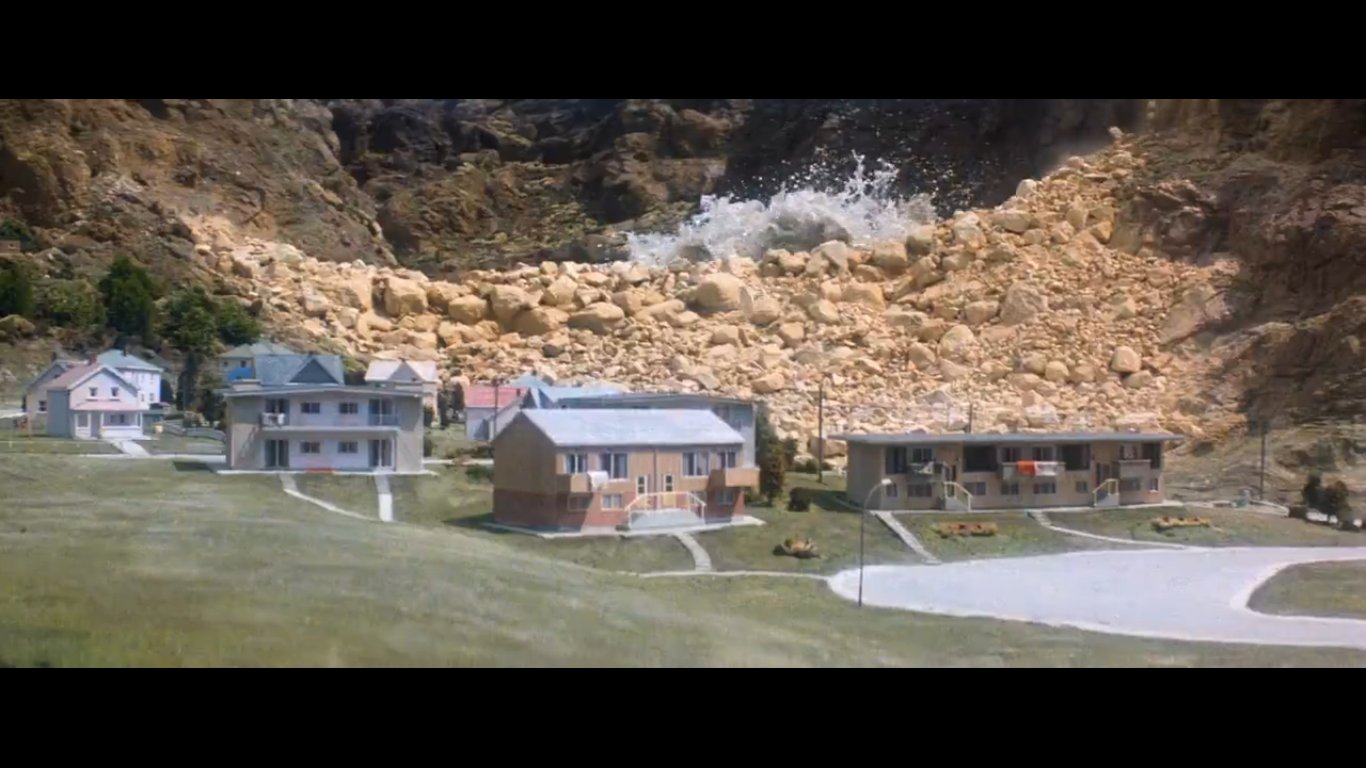
2:08:22 I revisit an earlier question: what are the odds that an accident this unlikely would happen to someone Superman personally knows?
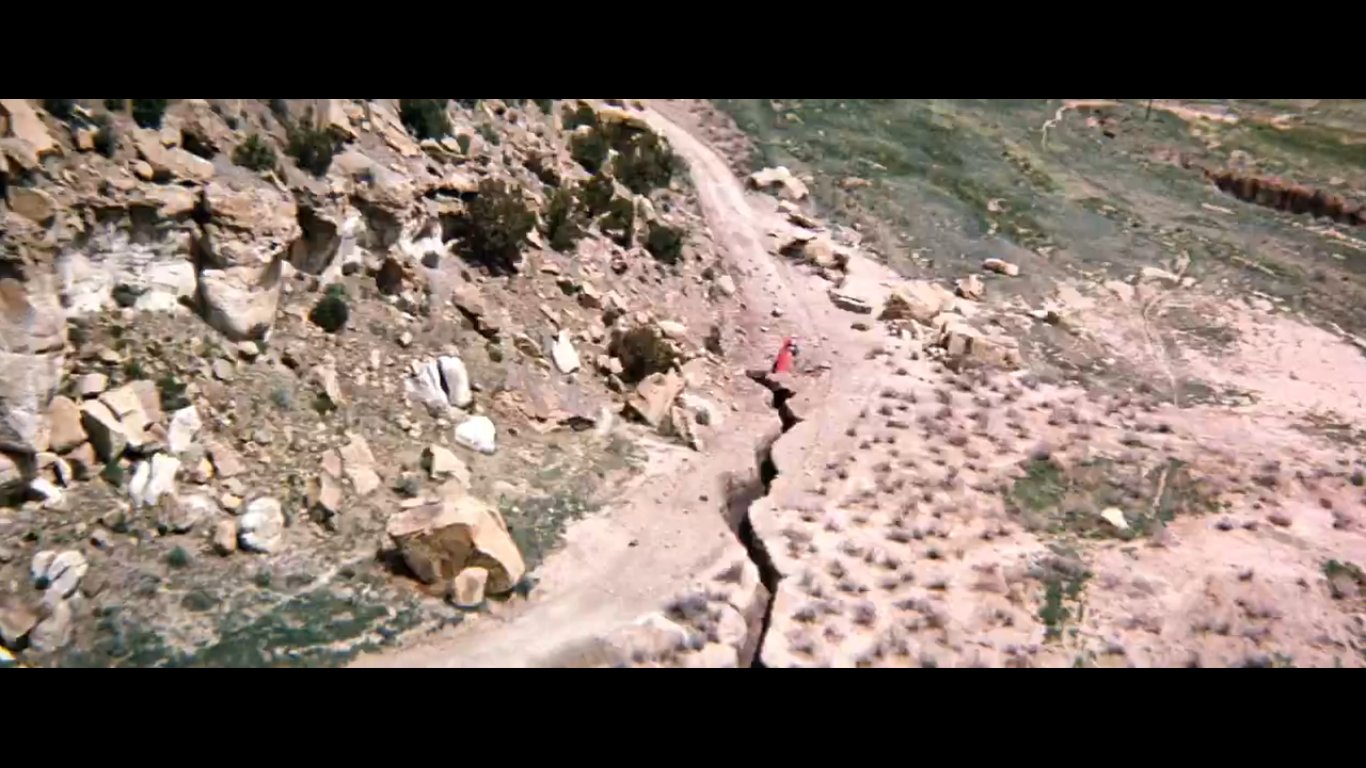
2:08:48 The material with Lois being killed in the earthquake while Superman was busy elsewhere wasn't originally planned. When SUPERMAN II was put on hold, they scrapped the previous cliffhanger ending and came up with this. To the credit of the filmmakers, it feels seamless.
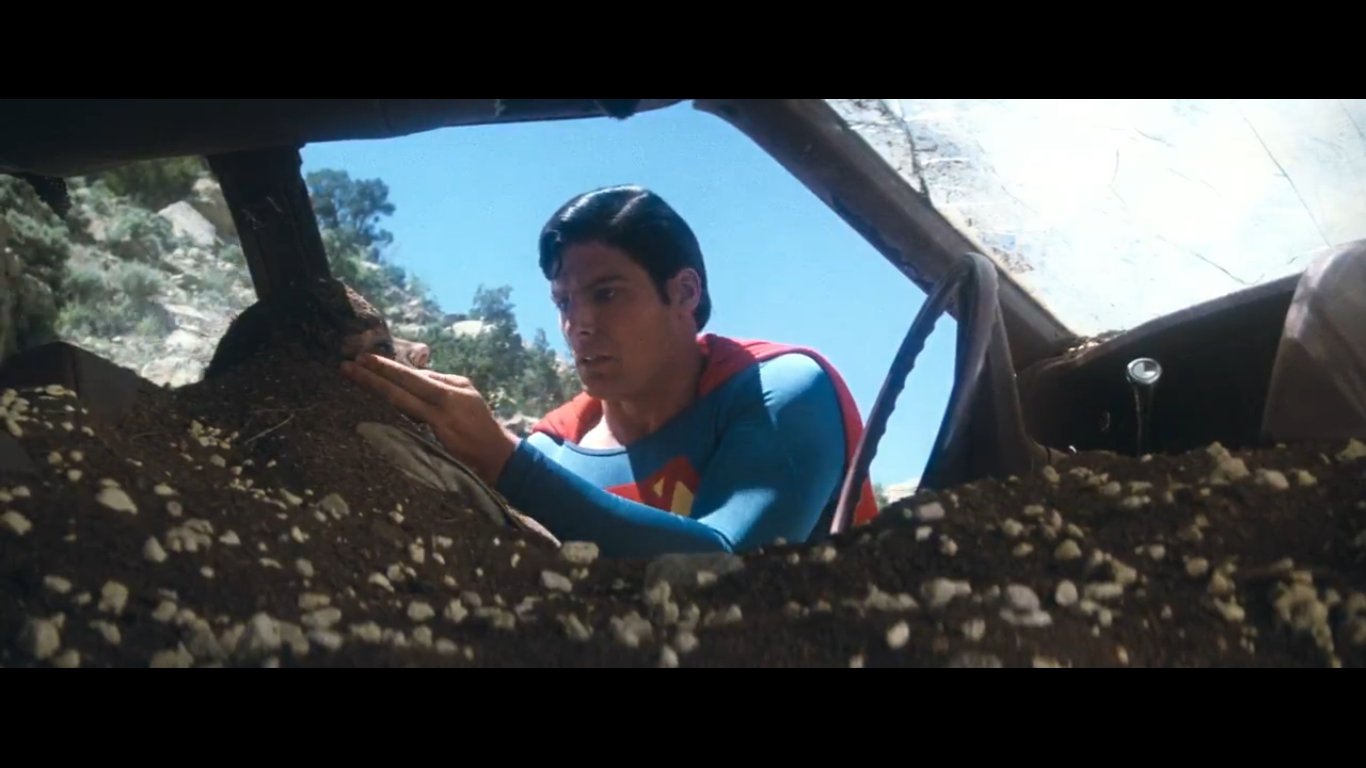
2:11:03 Let's return to an important question Clark asks earlier in the movie: "Who am I?" It isn't enough to be told that he's Kal-El, the only survivor of the planet Krypton, when he's already spent 18 years being Clark Kent of the planet Earth. This is him deciding who he is.

2:11:10 Two things about the sound design here: one, it's brilliant, letting Jor-El's repetition of "It is forbidden" hang over the moment when Superman defies him. Two, the sound effect of Superman flying into orbit creates a gut sense of never-before-seen speed.
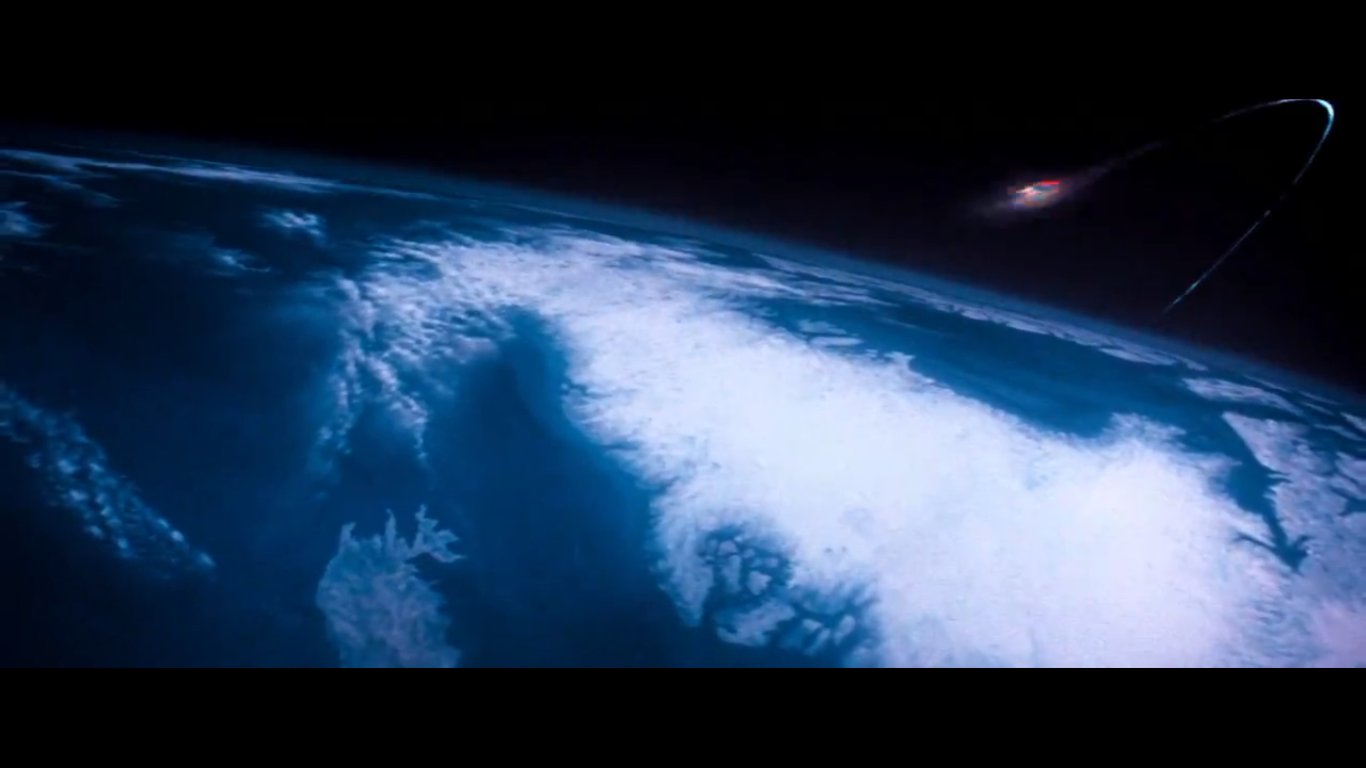
2:11:27 A lot of uncharitable readings of this moment assume that Superman is literally reversing the orbit of the Earth, and that this is somehow causing the timestream to rewind. Let go of this nonsense and accept that this is a visual metaphor, and a fairly elegant one.
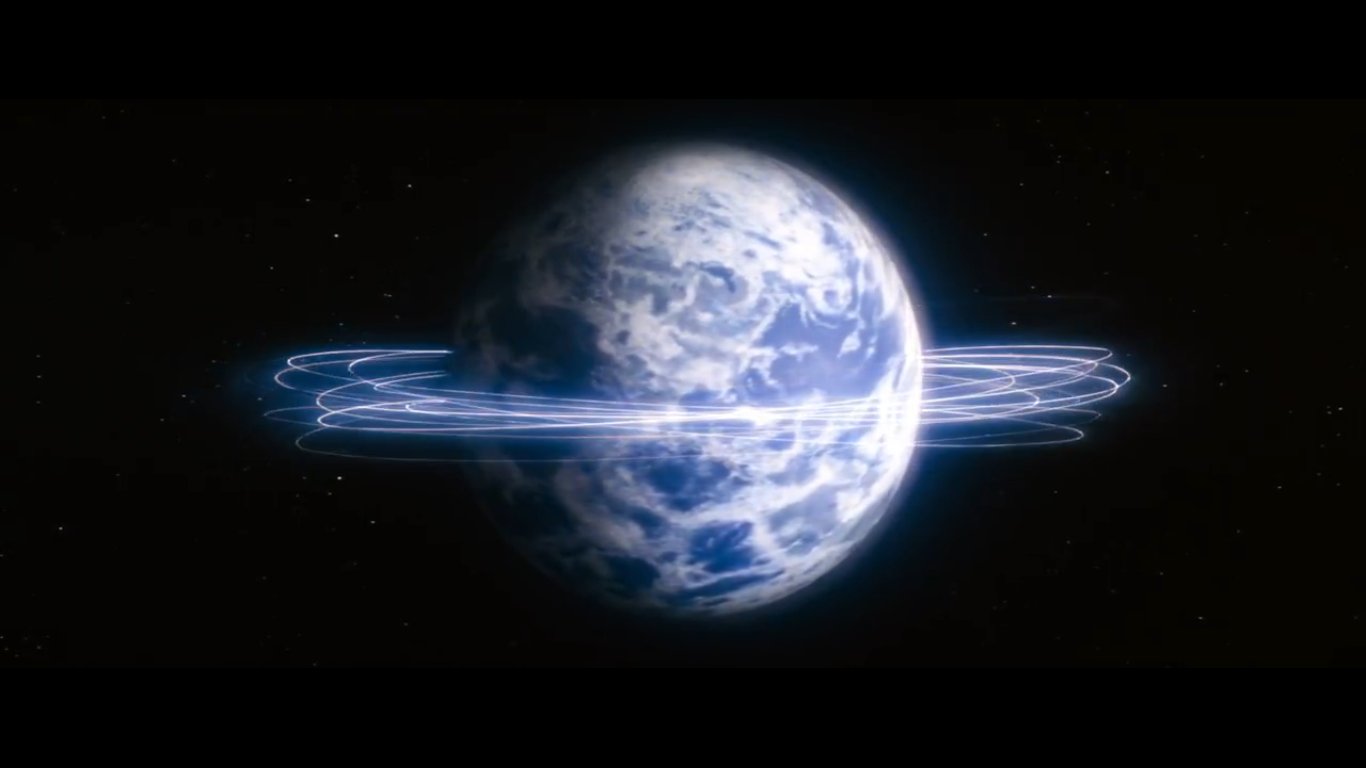
2:12:00 Lois: "Just how fast do you fly, by the way?"
Superman: "Oh, I don't know really. Fast enough to bend my future light cone all the way around to join up with a moment of my choosing from my past light cone."
Lois: "What?"
Superman: "Nothing. Want to go for a ride?"

2:12:10 And we're back. Presumably, before he touches down here, he's already stopped the aftershocks from the earthquake before they could reach Lois, then told the previous version of himself (fresh from rescuing Hackensack, New Jersey) to go back in time to close the loop.
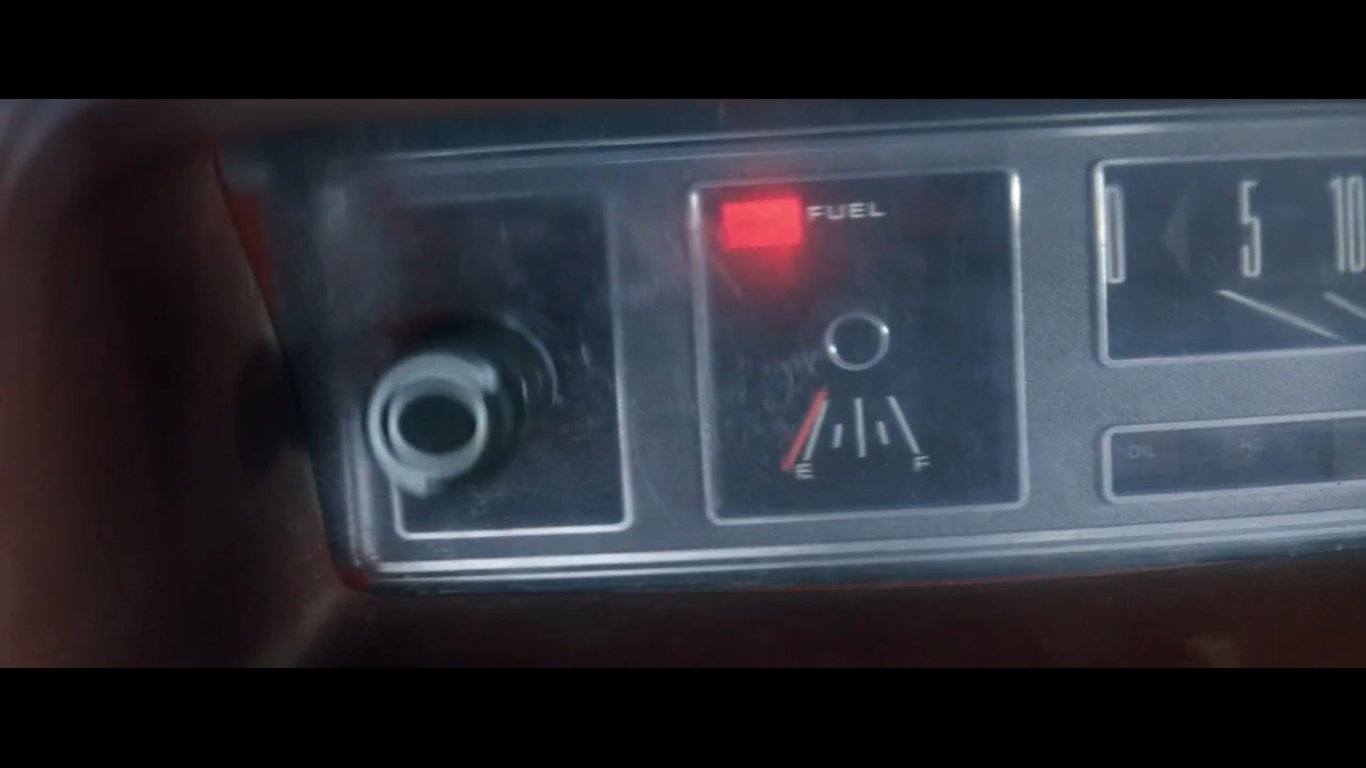
2:13:03 I know it goes without saying, but Christopher Reeve is perfect in this role. Look how happy he is to see her, how hard he's trying to play it cool. (It's probably best not to tell your girlfriend that you were holding her dead body just a few minutes ago.)

2:13:40 The subtext here is actually pretty funny. Maybe Superman wouldn't have been in such a hurry to fly off and apprehend Luthor and Otis if Jimmy hadn't shown up when he did.

2:13:53 The most effective part of the disguise is that the truth would be so hard to believe.

2:14:44 This is the sole scene to make it into this movie in which Gene Hackman would tolerate a bald cap. Scenes in SUPERMAN II (Lester, 1980) also feature Hackman in a bald cap, which were some of the few scenes shot concurrently with this movie not to be reshot for the sequel.

2:15:01 They dubbed this guy to give him a cooler voice.

2:15:08 Superman stands with the carceral system. But remember, this movie is a fantasy in which cops and prisons do the things they're supposed to do.

2:15:22 SUPERMAN is as much a musical experience as it is anything else, and ending on a reprise of the excellent opening title music is a good choice. It gives people a chance to sit in a darkened theater and experience this magnificent score one more time before heading home.

2:15:37 All four SUPERMAN movies starring Christopher Reeve end on this shot, although there are giveaways that they reshot it at least once. For a second time, Superman looks directly at us from inside the movie.

2:16:07 I was unable to find any information about who Norman Enfield is or what script material he might have furnished, But, given that he also worked on The Three Musketeers (Lester, 1973) and The Four Musketeers (Lester, 1974), he probably came aboard by way of the producers.

2:17:07 John Glen, one of the credited second unit directors, is another James Bond alum. He edited three of the 007 movies and directed five. A remarkable run, and a testament to the Bond producers' reliable practice of sticking with talent that they enjoyed working with.
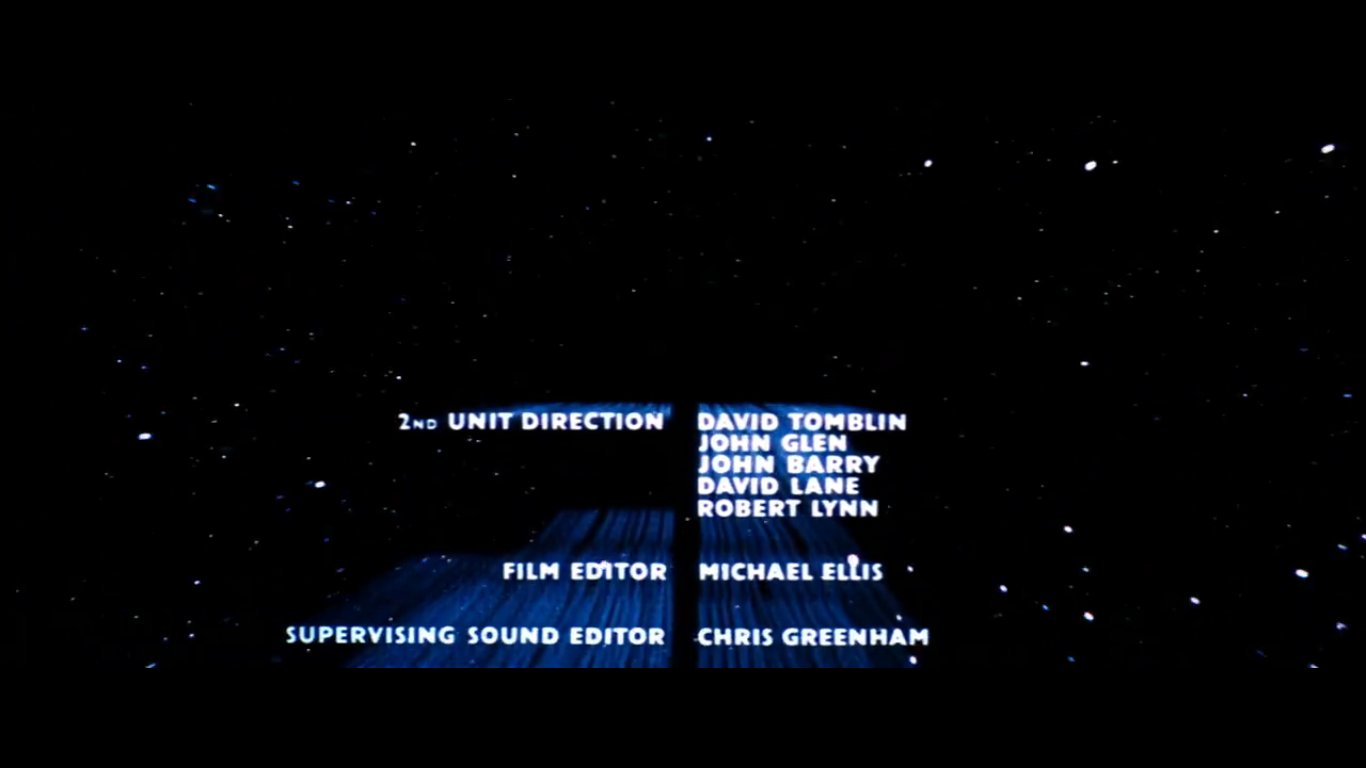
2:18:38 The music that follows wasn't originally intended for the movie. John Williams had created this arrangement of the love theme from SUPERMAN as a concert performance piece. When the credits ran long, this piece was included in order to stretch out the music to the end.
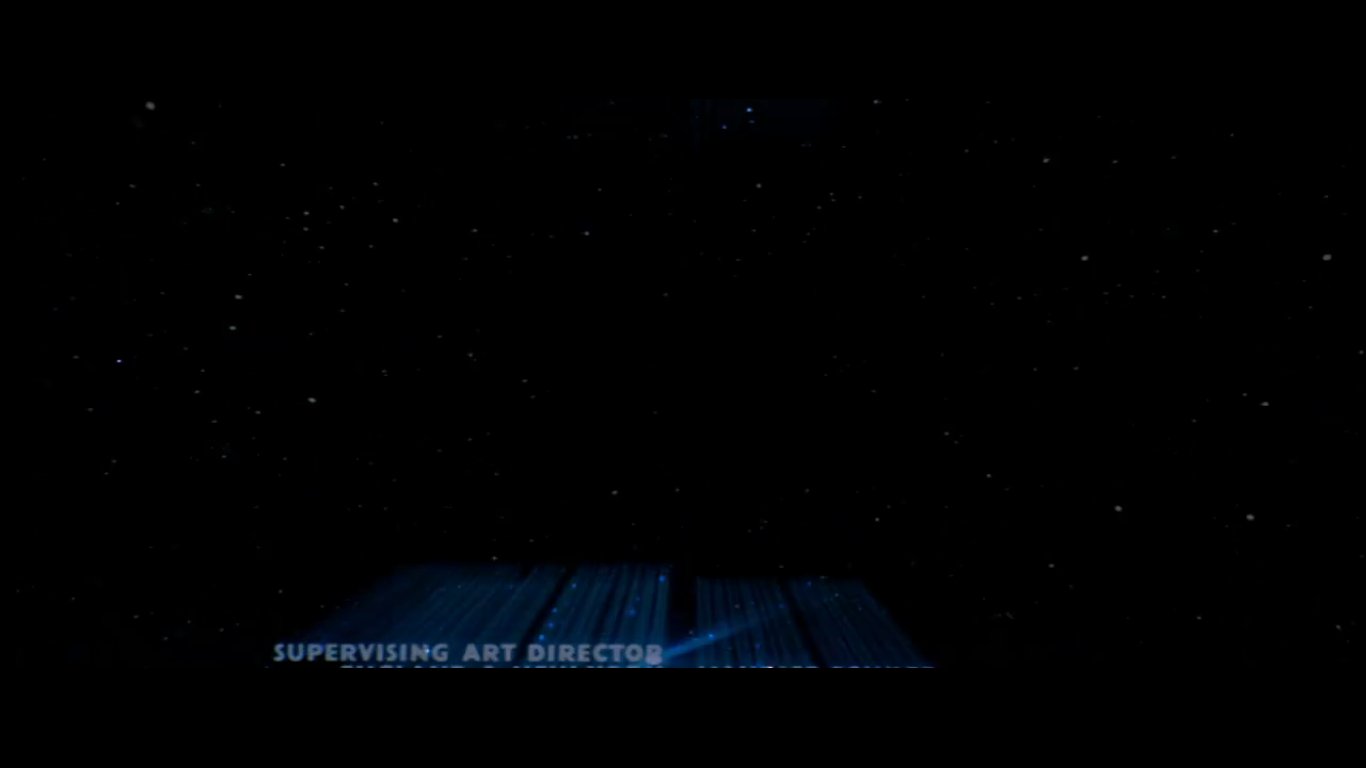
2:22:57 "Next year SUPERMAN II." Not quite!

2:23:14 And, with those delicate closing notes, we sign off.

P.S. Here's how they did the impossible gag (1:32:33): footage was shot of Superman flying away, which was then rear-projected onto a screen in front of Margot Kidder.
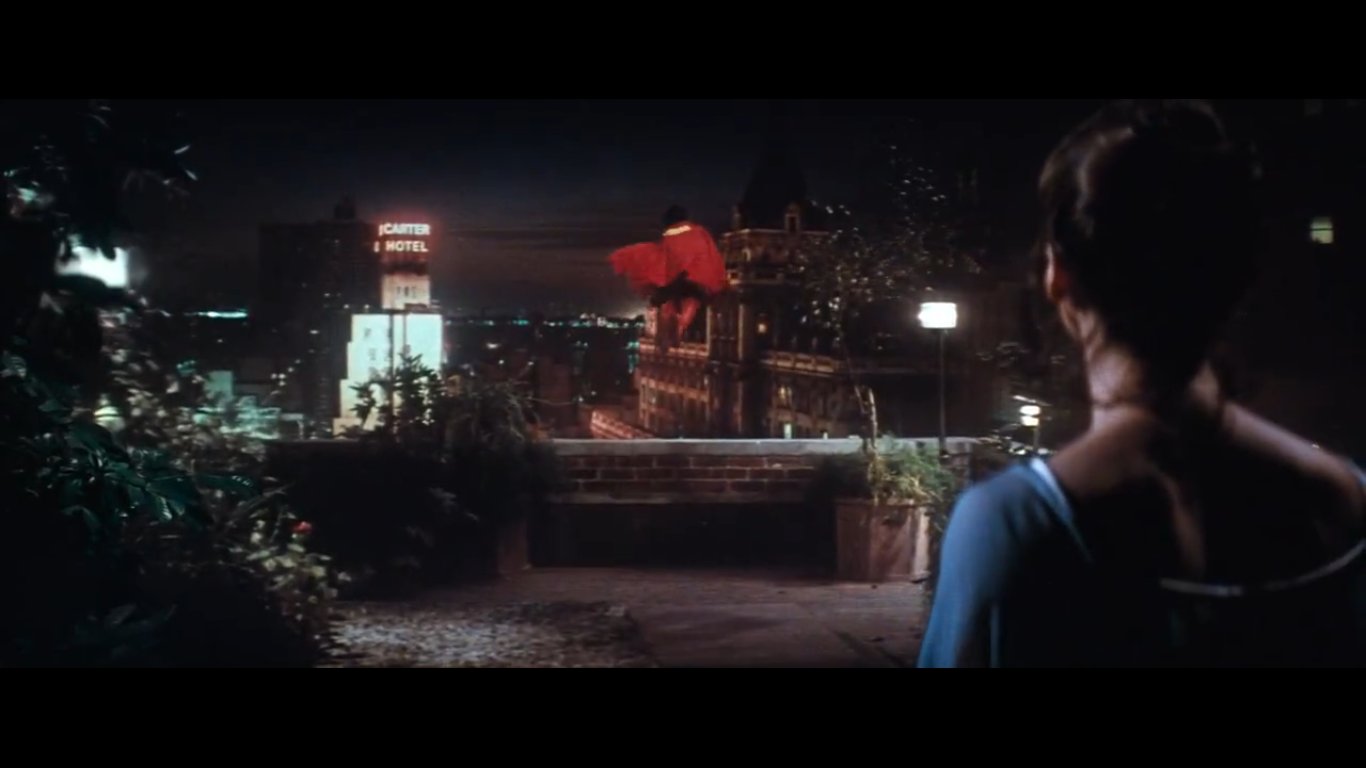
Regarding 2:15:37, a commenter on the original Twitter post pointed out that these were likely alternate takes from the same shoot.
Previous: SUPERMAN and Ideology
Next: SUPERMAN By The Numbers
Back to contents.
Published 3/9/2024
"365 Days of SUPERMAN"
site and contents
© 2024 Ken Alleman.
SUPERMAN is the property
of Warner Bros. Pictures.
Star Wars and The Empire
Strikes Back are the
property of Lucasfilm, Ltd.
Elements of these movies
appear on this page for
purposes of commentary.






































































































































































